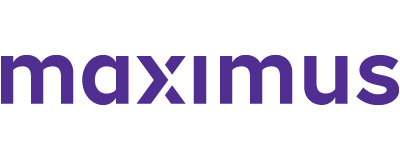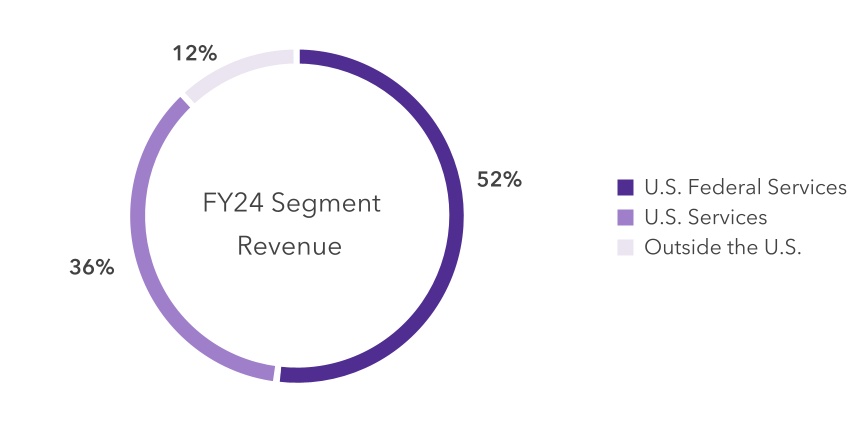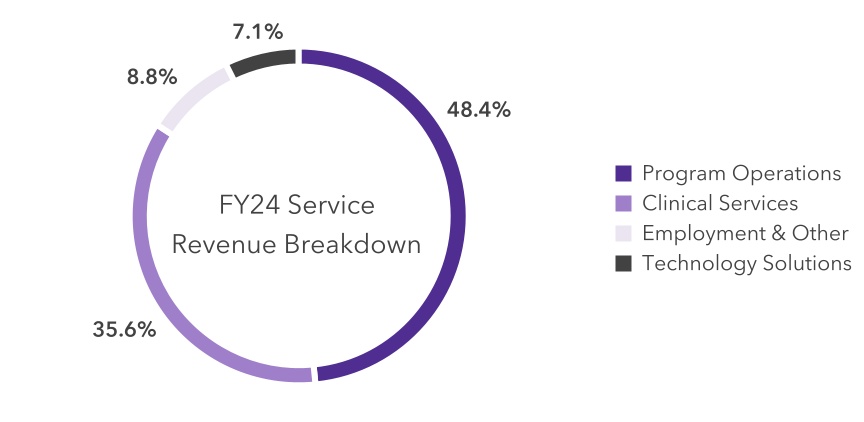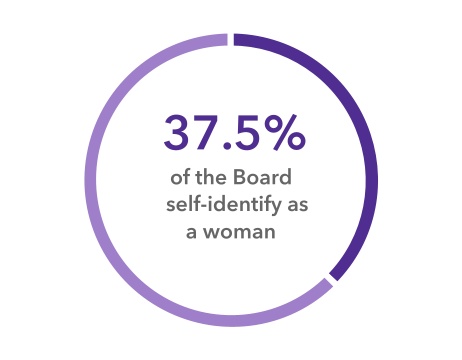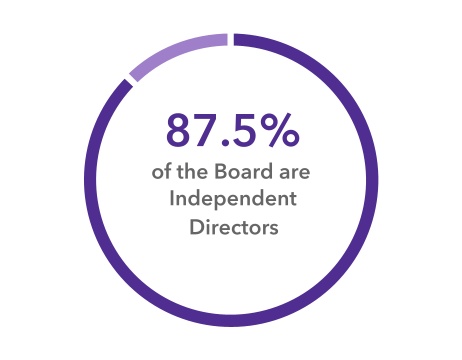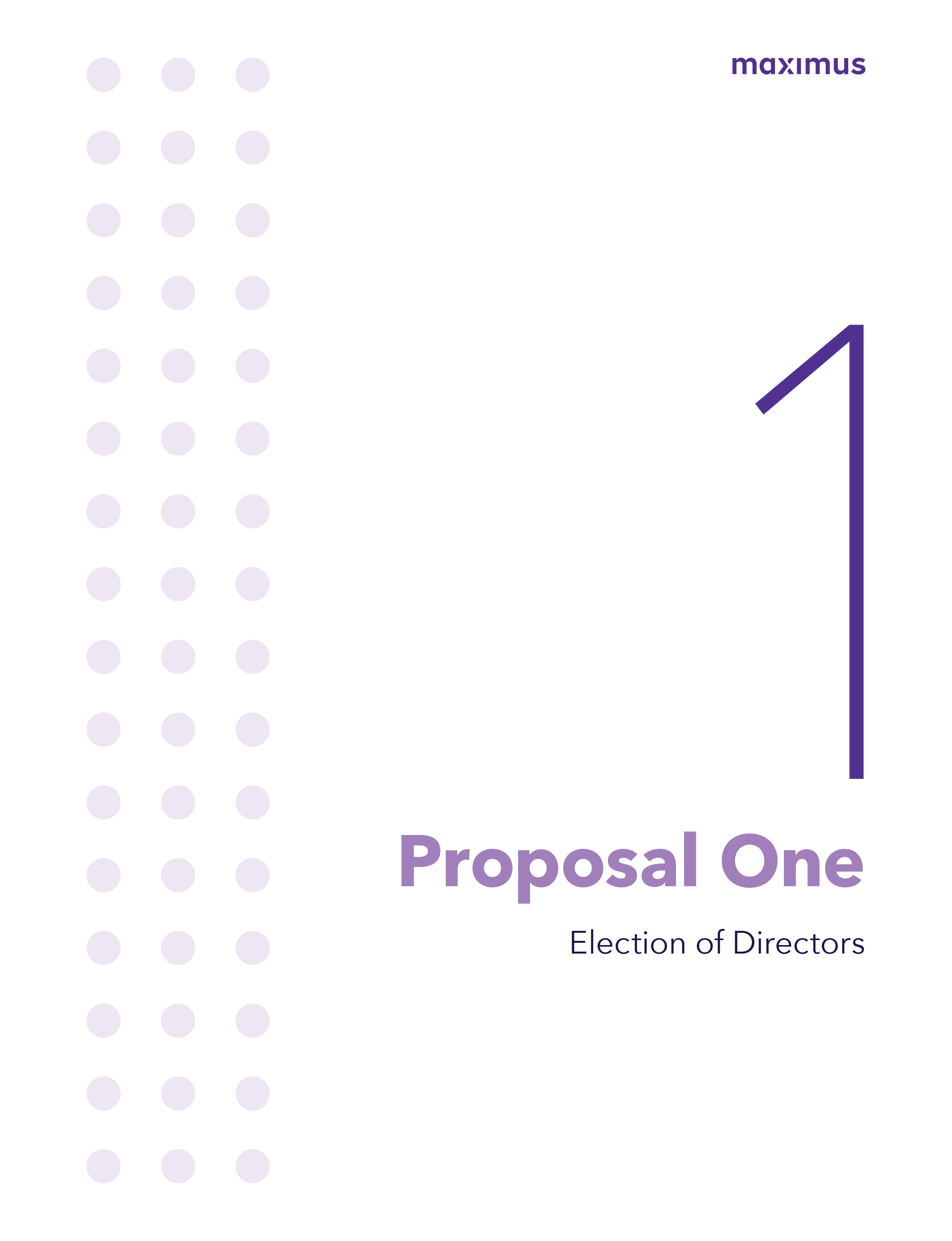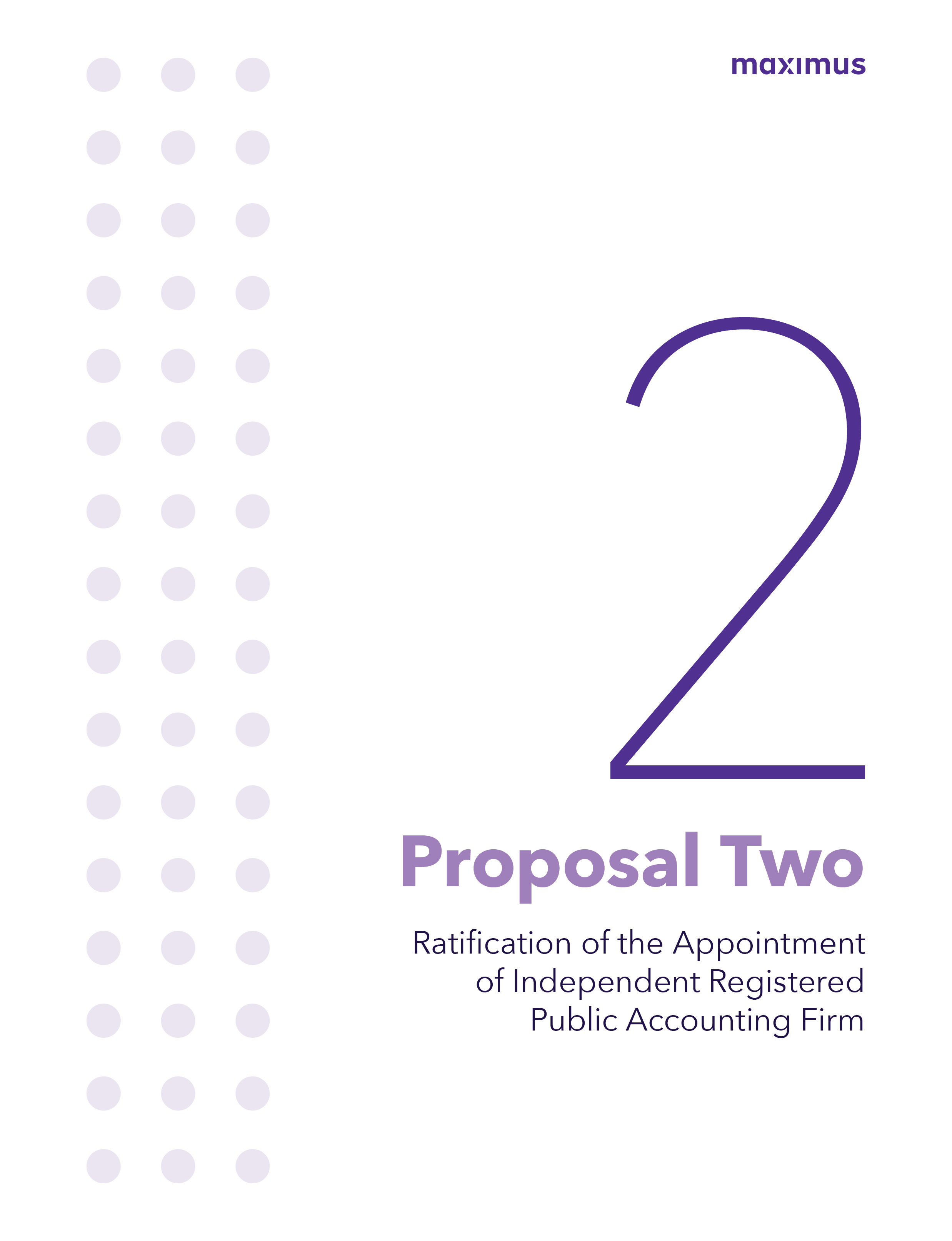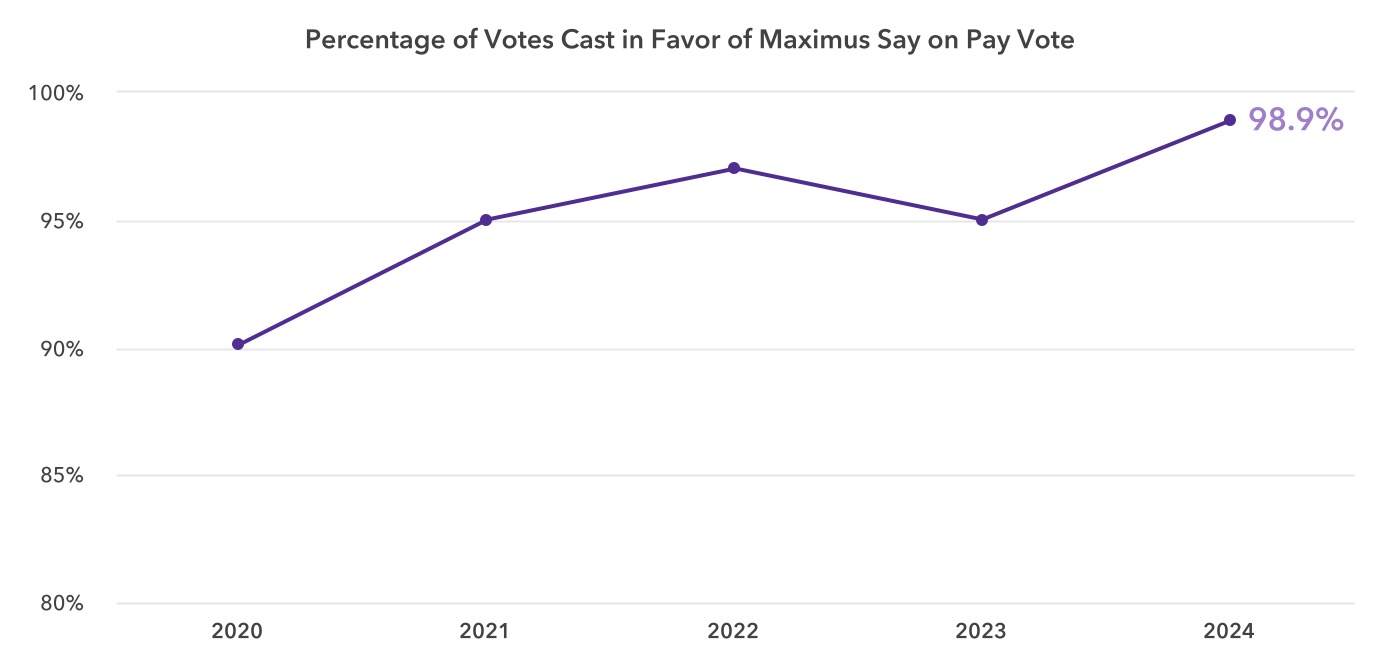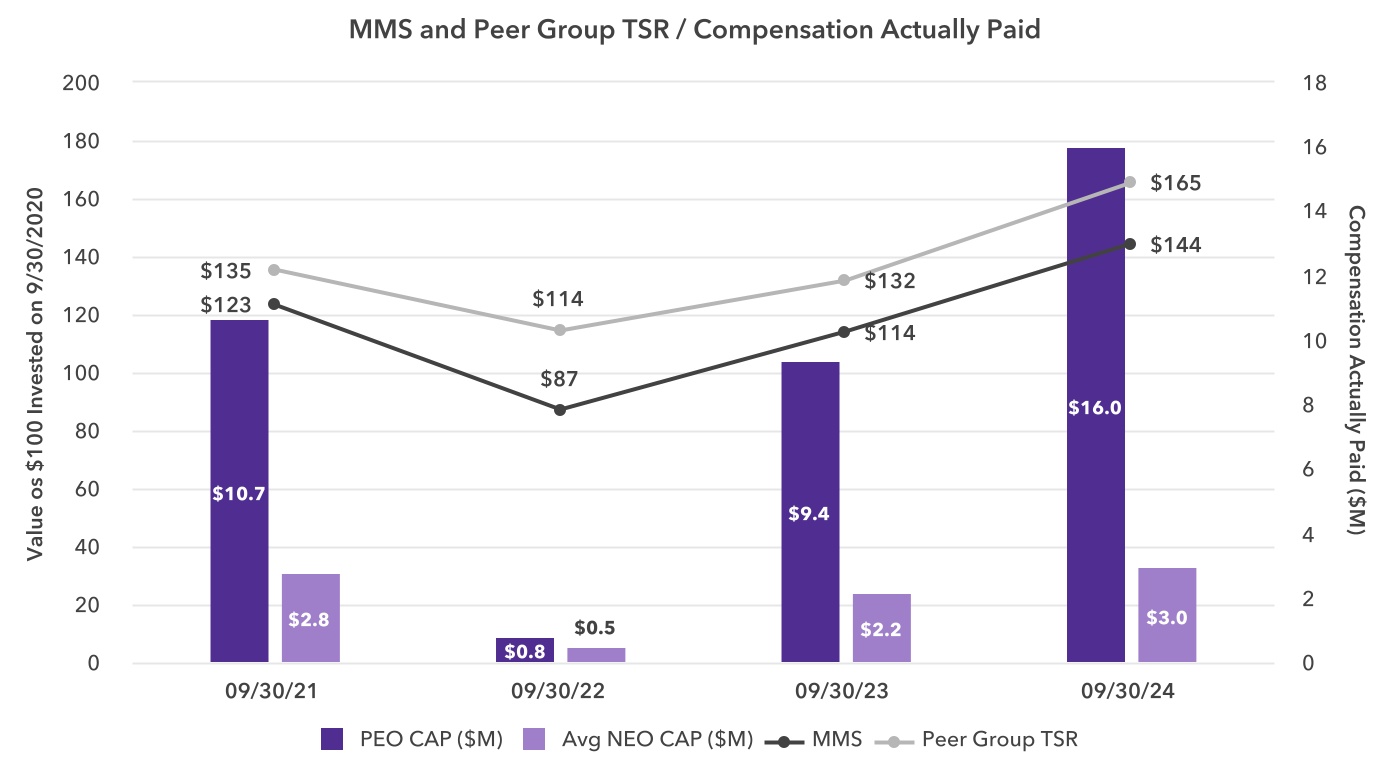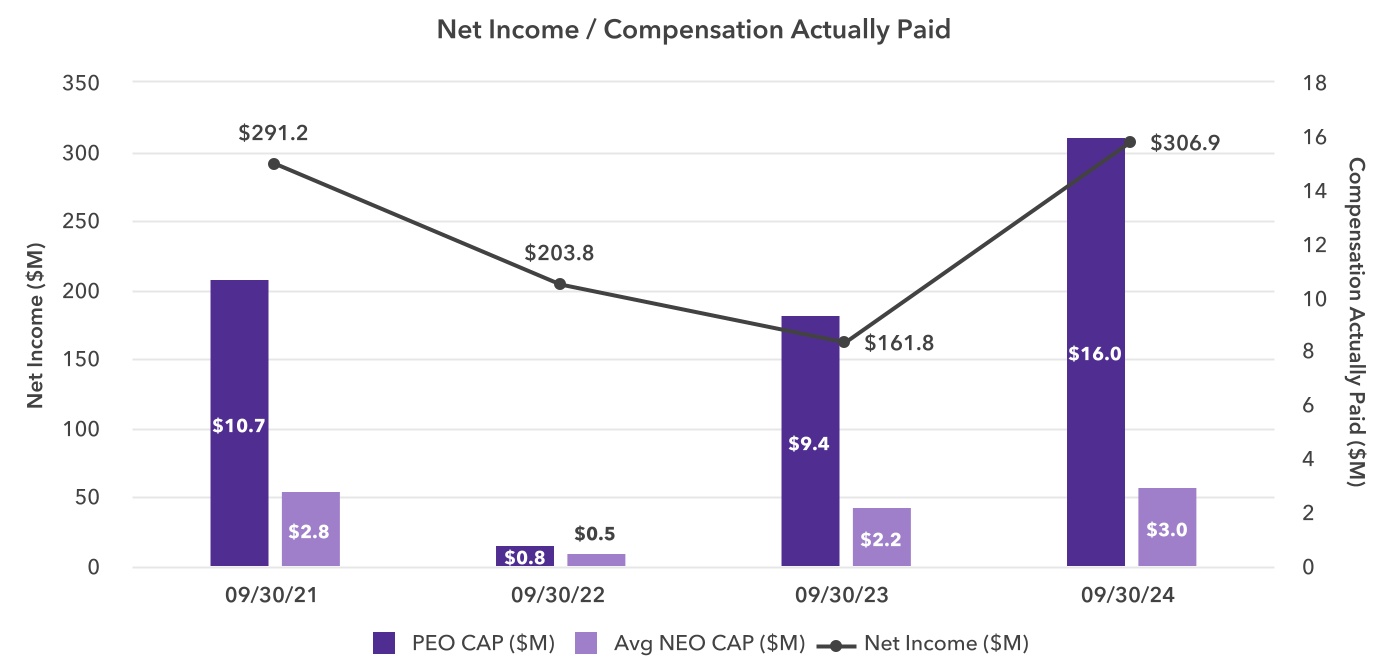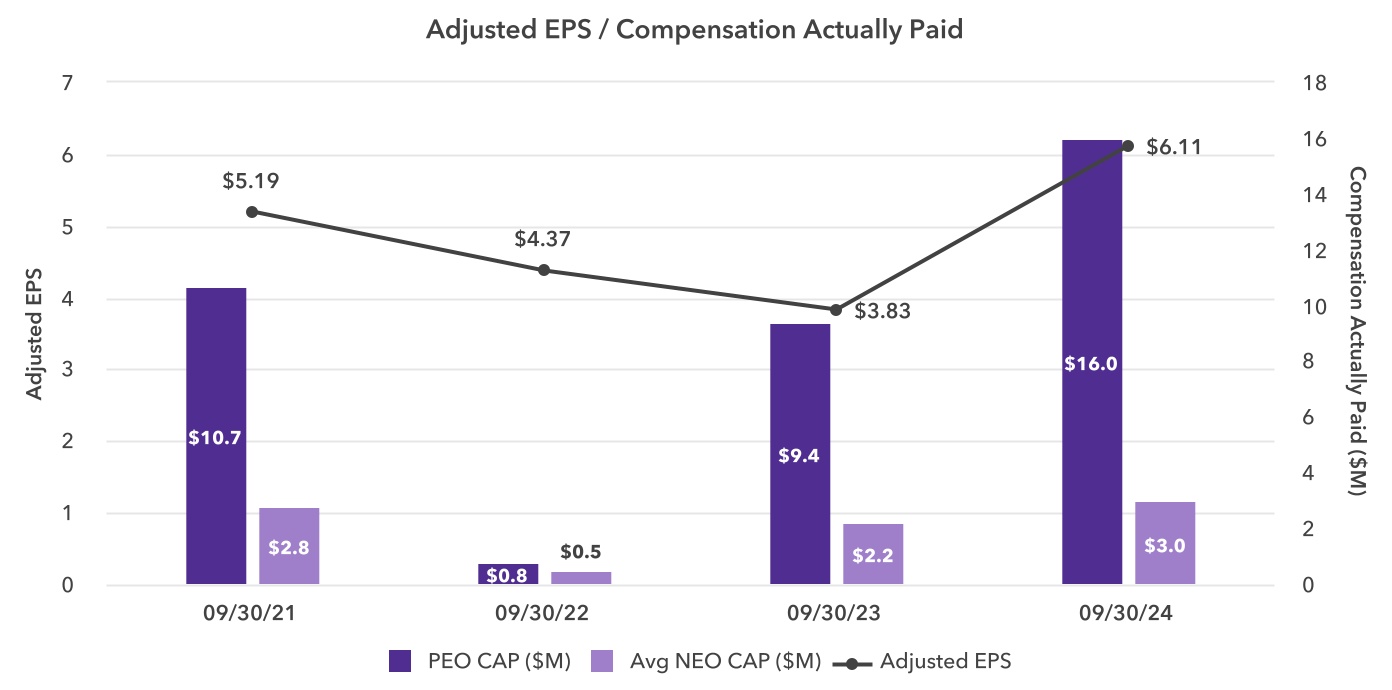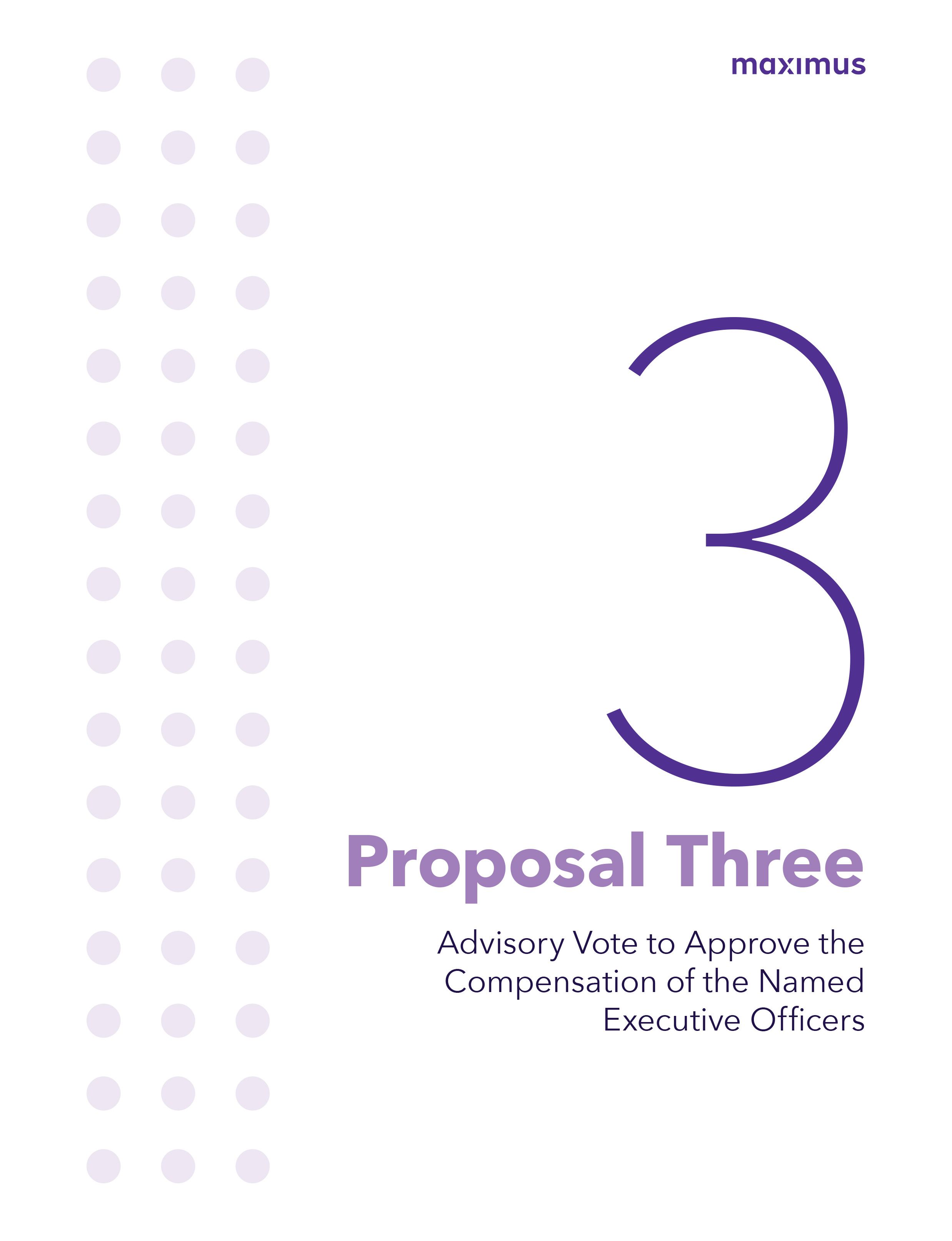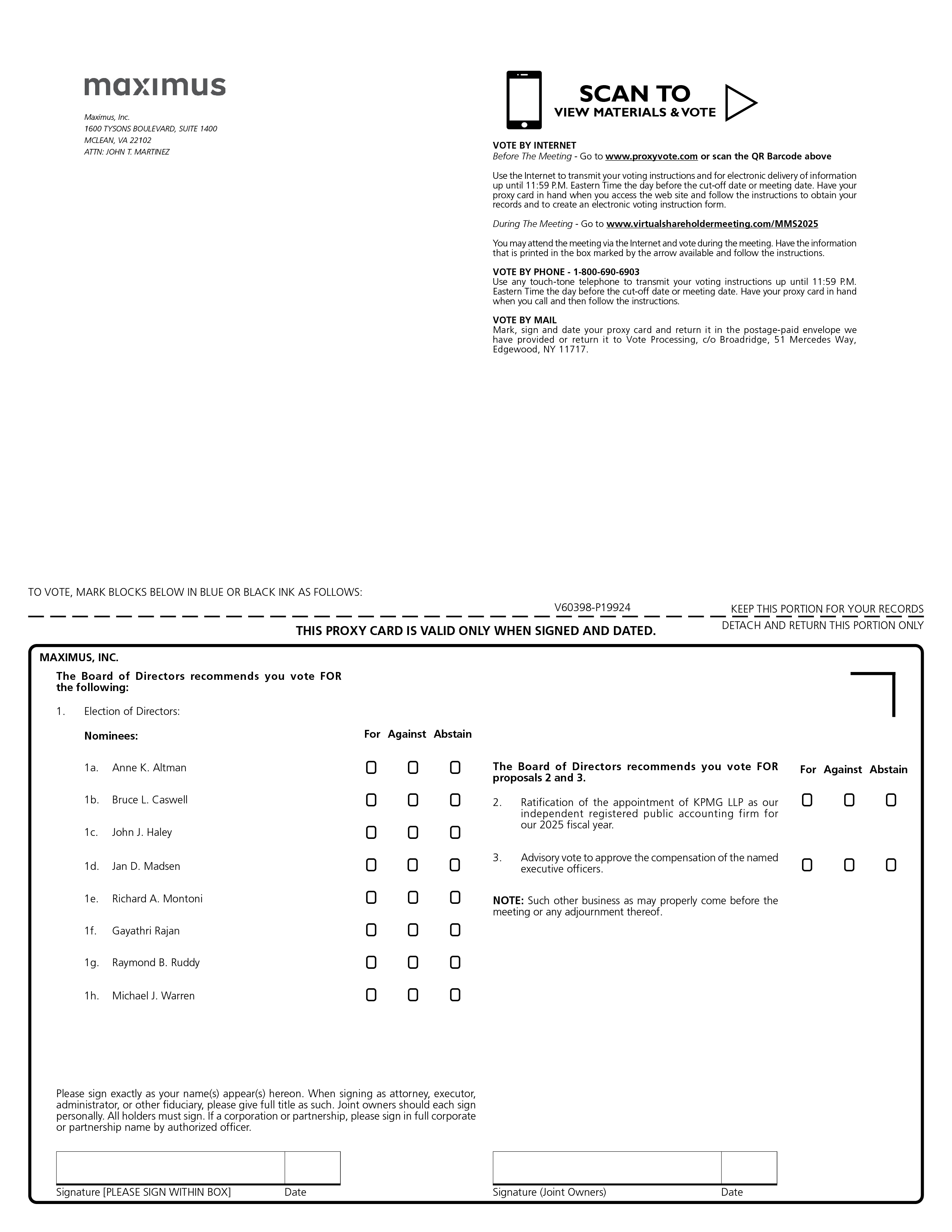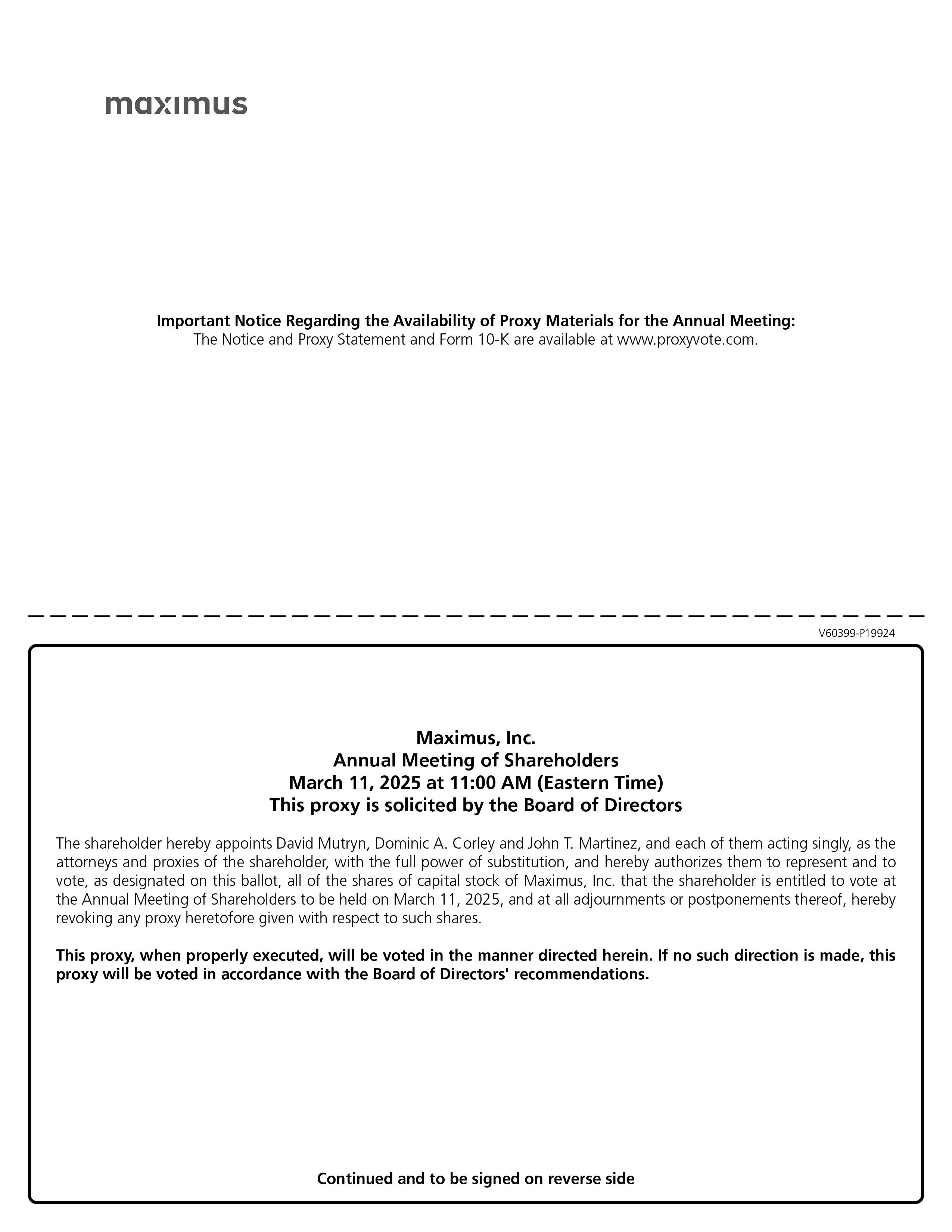UNITED STATES
SECURITIES AND EXCHANGE COMMISSION
Washington, D.C. 20549
SCHEDULE 14A
(Rule 14a-101)
INFORMATION REQUIRED IN PROXY STATEMENT
SCHEDULE 14A INFORMATION
Proxy Statement Pursuant to Section 14(a) of the Securities
Exchange Act of 1934
Filed by the registrant ☒
Filed by a party other than the registrant ☐
Check the appropriate box:
| | | | | | | | | | | |
☐ | | | Preliminary proxy statement |
☐ | | | Confidential, for use of the Commission only (as permitted by Rule 14a-6(e)(2)) |
| ☒ | | | Definitive proxy statement |
☐ | | | Definitive additional materials |
☐ | | | Soliciting material pursuant to section 240.14a-12 |
| | |
| Maximus, Inc. |
| (Name of Registrant as Specified in Its Charter) |
| | |
| Registrant |
| (Name of Person(s) Filing Proxy Statement, if Other Than the Registrant) |
Payment of filing fee (Check all boxes that apply):
| | | | | | | | | | | | | | | | | | | | |
| ☒ | | | No fee required. |
☐ | | | Fee paid previously with preliminary materials. |
☐ | | | Fee computed on table in exhibit required by Item 26(b) per Exchange Act Rules 14a-6(i)(1) and 0-11. |
January 22, 2025
Dear Fellow Shareholders,
On behalf of the Board of Directors, I am pleased to share another year of strong financial and operational performance for Maximus, which delivered company record setting adjusted earnings per share and over 8% revenue growth for the full year. Our recently expanded leadership team continued to guide the Maximus Forward strategy to new heights and efficiencies, allowing our business as a whole to secure numerous task orders and contract wins in 2024.
Our Business Resiliency
As a leading partner to federal, state and local governments, our team has supported millions of Americans in fiscal 2024. Our business resilience is unmatched as we consistently achieve outcomes for the government, at scale. We will continue to partner closely with our government clients to support their efforts helping people respond to the complex technology, health and social challenges facing the world today.
Continued Commitment to Shareholder Engagement
The Board has continued our long-standing practice of annual shareholder engagement, engaging our top 20 investors to discuss our strategy, Board composition, compensation program and evolving governance expectations. We are pleased to share that in response to feedback we heard, we have enhanced this year’s proxy disclosures to include a number of changes to increase transparency, including bolstering disclosures on our continuing director education program, Board assessment and evaluation processes and specific topics of risk oversight, such as how we responsibly and ethically leverage and oversee new possibilities offered by artificial intelligence.
Independent Freedom of Association Audit
In 2024, the Board approved and oversaw an independent, third-party audit that assessed and validated our compliance with employees’ freedom of association rights. We respect and support our workers’ rights and are committed to upholding a work environment and culture centered on open communication. The Board actively oversees the company’s talent strategy to ensure employees at Maximus have a career, not just a job, and is pleased with the progress made to the talent development programs in fiscal 2024, including significant enhancements to the strategic talent planning designed to prepare Maximus and our talent for future market demands.
The Maximus Board thanks you for your continued support of and investment in Maximus. We kindly request your voting support in the voting recommendations contained in this proxy statement.
We look forward to delivering another year of strong performance for all of our shareholders and further expanding our long-standing practice of maintaining open dialogue with our investors in order to continuously improve our strategic execution and shareholder value creation.
Sincerely,
John J. Haley
Chair of the Board
January 22, 2025
Dear Maximus Shareholders,
In fiscal year 2024, the talented and dedicated Maximus team further demonstrated our value as an efficient and accountable partner to government in delivering essential citizen services. Our team achieved a year of transformative growth and record financial results, exceeding our forecasts and demonstrating healthy business operations, partnering with new government agencies and expanding our service offerings.
Highlights included achieving outstanding full year growth in revenue, operating margin and adjusted EBITDA margin. We finished the year with a strong pipeline of opportunities and contract award positioning, with signed new contract awards valued at $2.2 billion and a total pipeline of sales opportunities of over $54 billion.
The success of our teams and operations are a reflection of the resiliency of Maximus’ strategic growth pillars, which prioritize long term demand characteristics that are shaping the role of government in supporting its citizens.
Delivering Customer Services, Digitally Enabled
Maximus’ long-standing practice of bringing together people, process, and advanced technology in the
solutions we deliver on behalf of our customers was further demonstrated in 2024. With greater integration of digital platforms in our offerings, we meet the evolving expectations of citizens seeking a streamlined and efficient interaction with government programs. In doing so, we achieve higher levels of satisfaction, performance accuracy and accountability for our government customers. At Maximus, we take pride in our history of implementing complex public policy with efficient technology-based solutions. In fiscal year 2024, we rolled out Total Experience Management, or TXM. This Contact Center as a Service (or CCaaS) capability is an added differentiator for Maximus as governments seek single providers to deliver secure, scalable, cloud-based solutions to serve employees and citizens.
Focused on the Future of Health
We advanced our ambition to help state and federal government agencies meet rising demands for health services this year, with rebid wins including our California Independent Medical Review (IMR) Project. Since 2013, we have supported the Department of Industrial Relations Division of Workers' Compensation by providing IMR services, underscoring how long-term customer relationships are a key feature of our business. We are also excited to continue supporting our nation's veterans through the Medical Disability Exams ("MDE") contracts with the Veterans Benefits Administration (VBA). We are honored to have gained the trust of the VBA as a reliable and value-driven partner, while continuously investing in operational improvements to enhance the Veteran experience. In fiscal year 2024 we also successfully launched the new Functional Assessment Services (FAS) contract in the United Kingdom. This $1B award provides the foundation for the UK’s progressive efforts to consolidate and streamline multiple assessment programs.
Advancing Technological Modernization
We continued to progress our technology modernization efforts for civilian, defense and health agencies, enabling Maximus to support customers in the rapidly evolving and increasingly complex cybersecurity and geopolitical landscape. As a technology leader, we view progress on this strategic imperative and expanding federal footprint as critical to ensuring government programs are resilient, dynamic, integrated and equitable. Our $171M fiscal year 2024 win of the Transportation Security Administration's OPTIMA program further evidences our growing position as a trusted partner to Federal agencies delivering critical mission services.
Moving Our Talent Forward
As we advance our Maximus Forward strategy, we are also prioritizing initiatives that move our Maximus people forward. Our transformative, organization wide initiative, Moving Our Talent Forward, was established to promote more efficient operations and reinvestment in the business to accelerate talent development, including reskilling, upskilling and leveling-up, as we prepare our teams for the future. Our people are our most valuable asset and top priority, which is why we strive for all of our employees to have a career at Maximus, not just a job.
As a testament to the success of our talent strategy, in our 2024 Global Employee Engagement survey, we had a 76% overall response rate, with a resounding +31 employee net promoter score. An improvement of 11 points from 2023.
We are proud of the financial results, delivery excellence, and contract victories achieved in 2024, made possible by our more than 40,000 employees in whose skills and capabilities we continue to invest. We look forward to delivering another year of strong and focused execution in FY2025, and we are grateful for your engagement and support.
Sincerely,
Bruce L. Caswell
Chief Executive Officer and President
Notice of Annual Meeting
of Shareholders
The 2025 Annual Meeting of Shareholders (the “Annual Meeting”) of Maximus, Inc. (“Maximus” or the “Company”) will be conducted online through a live webcast.
Meeting Details
| | | | | | | | | | | | | | | | | | | | | | | |
| Date March 11, 2025 | | | Time 11:00 a.m. ET | | | Location www.virtualshareholdermeeting.com/MMS2025 |
| | | | | | | |
Voting Matters
| | | | | |
| 1 | The election of eight Directors nominated by the Board of Directors of the Company to serve until the 2026 Annual Meeting of Shareholders. |
| 2 | The ratification of the appointment of KPMG LLP as our independent registered public accounting firm for our 2025 fiscal year. |
| 3 | An advisory vote to approve the compensation of the named executive officers. |
The meeting will also include the transaction of any other business that may properly come before the Annual Meeting or any adjournment or postponement of the Annual Meeting.
Record Date
Shareholders of record at the close of business on January 13, 2025, will be entitled to vote at the Annual Meeting or at any adjournment or postponement of the Annual Meeting.
Attendance
All shareholders are invited to attend the virtual meeting. In order to attend the virtual Annual Meeting, go to virtualshareholdermeeting.com/MMS2025 and enter the control number found on your proxy card, voting instruction form, or notice you previously received. If you are not eligible to participate in the meeting, you may listen to a webcast of the meeting by visiting virtualshareholdermeeting.com/MMS2025 and logging on as a guest. Guests will not be able to ask questions or vote at the meeting.
The Board of Directors of Maximus (“Board of Directors” or “Board”) is making this proxy statement, our Annual Report on Form 10-K for fiscal year 2024, and a form of proxy available to you in connection with the solicitation of proxies by the Board for use at the Annual Meeting and at any adjournments or postponements of the Annual Meeting.
Under Securities and Exchange Commission (“SEC”) rules, we have elected to furnish our proxy materials to shareholders over the Internet. We believe this will allow us to provide shareholders with the information they need while at the same time conserving natural resources and lowering the cost of printing and delivery. On or about January 22, 2025, we will mail to our shareholders a Notice of Internet Availability of Proxy Materials (the “Notice”) containing instructions on how to access our 2025 proxy statement and 2024 annual report. The Notice also provides instructions on how to vote online and includes instructions on how to receive a paper copy of the proxy materials by mail.
By Order of the Board of Directors
John T. Martinez
Chief Legal Officer and Secretary
This proxy statement is dated January 22, 2025 and is first being furnished to shareholders on or about January 22, 2025.
Table of Contents
| | | | | |
| |
| Fiscal Year 2024 Company Highlights | |
| |
| |
| |
| |
| |
| |
| |
| |
| |
| |
| |
Proxy Summary
The information provided in this Proxy Summary is for your convenience only and is merely a summary of the information contained in this proxy statement. You should read this entire proxy statement carefully. Information contained on, or that can be accessed through, our website is not intended to be incorporated by reference into this proxy statement.
Meeting Details
| | | | | | | | | | | | | | | | | | | | | | | |
| Date March 11th, 2025 | | | Time 11:00 A.M. EDT | | | Location www.virtualshareholdermeeting.com/MMS2025 |
| | | | | | | |
| | | | | | | | | | | | | | | | | | | | |
Ways to Vote Your vote is important. Whether or not you plan to attend, we encourage you to vote promptly. There are several ways that you can cast your ballot: | | | Via the Internet Go to proxyvote.com | | | Virtually Attend the virtual Annual Meeting |
| | | | | |
| | By Telephone (+1) 800-586-1548 (toll-free) (+1) 303-562-9288 (international) | | | By Mail Sign, date, and return your proxy card in the enclosed envelope |
| | | | | | |
Voting Recommendations
| | | | | | | | | | | |
| Proposal | Board's Voting Recommendation | Page Reference |
| |
| 1 | The election of eight Directors nominated by the Board of Directors of the Company to serve until the 2026 Annual Meeting of Shareholders. | FOR each nominee | |
| 2 | The ratification of the appointment of KPMG LLP as our independent registered public accounting firm for our 2025 fiscal year. | FOR | |
| 3 | An advisory vote to approve the compensation of the named executive officers. | FOR | |
| | | | | | | | |
| MAXIMUS 2025 PROXY STATEMENT | 1 |
Fiscal Year 2024 Company Highlights
| | | | | | | | |
| | |
| | |
| $5.3B | |
| FY24 Revenue | |
| | |
| | |
| | |
| 41,100+ | |
| Employees worldwide | |
| | |
| | |
| | |
| 100M+ | |
| American citizens supported by programs we administer | |
| | |
| | |
| | |
| McLean | |
| Headquarters are located in McLean, Virginia | |
| | |
| | | | | | | | |
| | |
8.2% | | 11.6% |
| Increase in revenue from $4.9B in fiscal year 2023 | | Adjusted EBITDA margin1 |
| | |
| | |
| $6.11 | | $401M |
Adjusted diluted earnings per share1 | | Free cash flow1 |
| | |
1.Adjusted earnings metrics and free cash flow are non-GAAP terms. A summary of our use of non-GAAP numbers as well as a description of how we calculate them, may be found in Item 7 of our Annual Report on Form 10-K for the year ended September 30, 2024, and filed with the SEC on November 21, 2024.
| | | | | | | | |
| 2 | MAXIMUS 2025 PROXY STATEMENT | |
Moving our Talent Forward
At Maximus, we want our employees to have a career, not just a job. This means it will take all of us, through tools, processes, technology, and a shared vision, to enable our talent to both redeploy internally and level-up for future skills. We are committed to Moving Our Talent Forward. Embarking on an organization-wide initiative of the same name, we are focused on planning and meeting our organization’s current and future strategic talent goals by empowering our most important success factor–our employees.
| | | | | | | | |
| | |
| Mobilizing our talent internally as the business needs | | Helping employees level-up for future skill needs |
| | |
| To support mobilizing our talent internally, we created a Strategic Workforce Planning (SWP) function to ensure we are taking an employee-centric approach to streamlining the redeployment of our workforce. They are dedicated to ensuring we have the right people with the right skills at the right time to meet the demands of our government clients to effectively serve and support the citizens in our own communities. This team partnered with the business to implement the “Beach,” which is a virtual status that bridges the gap between assignments, providing income and benefit continuity, proactively nurturing our employees during times of change, providing them with stability, and enabling employees to move more seamlessly to new projects. Since its implementation, we have matched 2,100 employees ending a project with open positions. preventing potential reductions in force (RIFs). These efforts created value by avoiding severance, recruitment, and rehiring expenses, and created an atmosphere of increased employee security by ensuring their careers could continue. | | To support our employees' journey to level-up for future skills, we are committed to and value ongoing development and continuous learning for all Maximus employees. Maximus offers a variety of instructor-led and self-paced learning programs for diverse audiences ranging from individual contributors to frontline supervisors and executive leadership. Our project training teams manage customized programs supporting contract requirements, customer service, local leadership development, and employee engagement. We also provide many employees with online role-based and skill-based learning tools. Starting in 2023, to support our transition to a Skills-Based Organization, we invested in internal cross-functional resources and into an innovative AI Total Talent Management System, Eightfold. Officially launched on October 1, 2024, Eightfold will ultimately enable us to address talent needs and gaps more effectively as it is a career hub that gives Maximus more data and insight into the skillsets of our employees, recommends internal roles based on skillsets and career aspirations, and connects employees to skill development opportunities. |
| | |
Our Values
We continue to build a culture that embodies our values of accountability, collaboration, compassion, customer focus, innovation, and respect. To support this, we look for ways to continuously embed these values into our organizational DNA, guiding our conduct and decision-making and reflecting our collective beliefs and ambitions. At Maximus, we share an authentic desire to do something meaningful to help others succeed. This is the Maximus culture and the bedrock of our brand identity and values. It’s who we are.
| | | | | | | | | | | | | | | | | |
| Respect | | Compassion | | Innovation |
| | | | | |
| Accountability | | Collaboration | | Customer Focus |
| | | | | | | | |
| MAXIMUS 2025 PROXY STATEMENT | 3 |
Strategy for Growth
Today’s rapidly changing world demands that governments have the capacity and flexibility to respond to the growing expectations of the people they serve. Maximus makes it easier for people to access public services more easily and equitably. As a leader in the ability to translate health and human services public policy into outcomes-based operating models, we provide transformative technology services, digitally enabled customer experiences, and clinical health services that change lives.
The three pillars of our strategy are supported by significant and growing demand, the capabilities we bring to our mission of “moving people forward,” and our ability to deliver on customer priorities with differentiation and sustainable competitive advantage. With the relentless pace of technology, what was considered cutting edge two years ago is becoming table stakes. As the competitive landscape moves, we are investing in anticipation of evolving customer needs.
| | | | | | | | | | | | | | |
| | | | |
Technology
Modernization | | Future
of Health | | Customer Services,
Digitally Enabled |
| | | | |
•Modernizing programs and legacy technology systems to be agile enough to meet the needs of a rapidly changing world can be hard. We make that easier by offering more options for modernizing programs – aligning solutions around the unique circumstances of each program. | | •We use innovative techniques and proven technologies and analytics to meet individuals on their own terms. •We automate complex processes and empower health professionals with timely, actionable data – enabling them to focus on individuals while responding to community needs at scale. | | •Our solutions provide streamlined and equitable access to critical benefits. •We apply advances in business intelligence, predictive analytics, and emerging technologies to unlock the full potential of an agency’s mission. We proactively detect and resolve barriers to reach target populations. |
| | | | | | | | |
| 4 | MAXIMUS 2025 PROXY STATEMENT | |
Board of Directors
The Nominating and Governance Committee (N&G) works directly with the Chairman to lead the Board in an annual self-evaluation process that assesses the performance of the Board as a whole, the committees of the Board, and the contributions of the individual directors. In fiscal year 2024, the N&G Committee recommended retaining the committee structure that was implemented on January 1, 2024.
| | | | | | | | | | | | | | | | | | | | |
| Name | Age | Director Since | Audit | Nominating & Governance | Compensation & Human Resources | Technology Committee |
| | | | | | |
| Anne K. Altman | 65 | 2016 | | | l | |
| Bruce L. Caswell | 59 | 2018 | | | | |
| John J. Haley | 75 | 2020 | | l | | |
| Jan D. Madsen | 61 | 2020 | | | | l |
| Richard A. Montoni | 73 | 2006 | | | | |
| Gayathri Rajan | 57 | 2016 | | l | | l |
| Raymond B. Ruddy | 81 | 2004 | l | l | | |
| Michael J. Warren | 57 | 2019 | l | | l | l |
| | | | | | | | | | | | | | |
| Committee Chair | | l | Committee Member |
| | | | | | | | |
| MAXIMUS 2025 PROXY STATEMENT | 5 |
Board Composition
The N&G Committee has worked to ensure that Maximus' Board reflects that of a strategic asset board that is richly defined by a variety of skills that will benefit the long-term strategy of the organization while at the same time representing the needs of our shareholders. As a global company, with a wide array of stakeholders, whose employees, customers, and stakeholders represent a wide variety of backgrounds, ethnicities, genders, etc, we are proud of our board composition and feel that it represents us well.
Current Board Composition:
| | | | | | | | | | | | | | | | | | | | | | | | | | | | | | | | | | | | | | | | | | | | | | | | | | | | | | | | | | | | | | | | | | | | | | | | | | | | | | | | | | | |
| Director Tenure | | | Director Age |
| | | | | | | | | | | | | | | | | | | | | | | | | | | |
| l | l | l | l | l | l | l | l | | | l | l | l | l | l | l | l | l | | | l | l | l | l | l | l | l | l |
| 5 - 9 years | | | 50's | | | 60's |
| | | | | | | | | | | | | | | | | | | | | | | | | | | |
| | | | | | | | | | | | | | | | | | | | | | | | | | | |
| l | l | l | l | l | l | l | l | | | l | l | l | l | l | l | l | l | | | l | l | l | l | l | l | l | l |
| 10+ years | | | 70's | | | 80's |
| | | | | | | | | | | | | | | | | | | | | | | | | | | |
| | | | | | | | |
| 6 | MAXIMUS 2025 PROXY STATEMENT | |
Our Leadership
Our executive officers and their respective ages and positions as of the date of this proxy statement are as follows:
| | | | | | | | |
| Name | Age | Position |
| | |
| Bruce L. Caswell | 59 | Chief Executive Officer, President and Director |
| David W. Mutryn | 43 | Chief Financial Officer and Treasurer |
| Ilene R. Baylinson | 68 | General Manager, U.S. Services |
| Michelle F. Link | 50 | Chief Human Resources Officer |
| John T. Martinez | 52 | Chief Legal Officer and Corporate Secretary |
The following information sets forth biographical information for the past five years of the executive officers. Such information with respect to Bruce L. Caswell, our Chief Executive Officer and President, is set forth below in the “Proposal 1 - Election of Directors” section.
David W. Mutryn assumed the role of Chief Financial Officer in 2021. Mr. Mutryn joined Maximus in 2016 as Corporate Controller and transitioned to Senior Vice President of Finance in 2020. Prior to Maximus, Mr. Mutryn was Vice President of Finance at CSRA, Inc. and held numerous financial leadership positions at SRA International, Inc.
Ilene R. Baylinson has served as the General Manager of our U.S. Services Segment since 2020. She previously served as the General Manager of the U.S. Health Segment from 2015 to 2020. Ms. Baylinson joined Maximus in 1991.
Michelle F. Link joined Maximus in March 2020 as Chief Human Resources Officer. From 2018 to 2020 she served as the Executive Vice President of Human Resources for ADS, Inc. Before that she served as Chief Human Resources Officer for PRA Group from 2011 to 2018. She has also held senior Human Resources roles at BlueCross Blue Shield of Tennessee, AMERIGROUP (now Elevance Health), CIGNA, and Corning.
John T. Martinez joined Maximus in September 2023 as Chief Legal Officer and Corporate Secretary. Mr. Martinez previously served as Vice President and General Counsel of GE Aerospace from August 2021 to September 2023 where he was responsible for developing and executing GE Aerospace's legal strategy across the commercial aviation and defense sectors and led GE Aerospace's global legal, contracts, compliance, and government relations organizations. In the ten years prior, Mr. Martinez served in roles including senior leadership positions at Raytheon Intelligence & Space, the Director of National Intelligence, and the Central Intelligence Agency.
| | | | | | | | |
| MAXIMUS 2025 PROXY STATEMENT | 7 |
Corporate Governance
Board’s Role in Risk Oversight
The Board of Directors as a whole oversees the risk management of the Company. Senior members of the Company’s management team regularly report to the Board on operational and financial risks relating to the Company’s projects, and about compliance with the Company’s policies and procedures and code of ethics.
| | | | | | | | | | | | | | | | | | | | | | | | | | | | | |
| Board of Directors | |
| | | | | | | | | |
| | | | | | | | | |
| Audit Committee | | Nominating and
Governance Committee | | | Compensation and Human Resources Committee | | Technology Committee | |
| | | | | | | | | |
| Oversees management of business and operational risks that could have a financial impact, such as those relating to internal controls and liquidity. | | Manages the risks associated with compliance matters, including receiving regular reports from the Company’s CCO governance issues, such as the independence and performance of the Board, and environmental and social issues. | | | Responsible for managing the risks relating to the Company’s executive compensation and succession plans and policies. | | Assists the Board with oversight of the Company’s information technology risks, strategic technology investments, and the quality and effectiveness of the Company’s cybersecurity policies and practices, including the company's use of artificial intelligence. | |
| | | | | | | | | |
| | | | | | | | | |
| Enterprise Risk Management | |
| | |
Annually, the Company surveys key leaders of the Company to identify significant risks facing the Company. Those risks are ranked based on likelihood of occurrence as well as potential impact and assigned a risk manager. Management engages risk managers to regularly update performance metrics and mitigation plans for risks identified in the assessment process. The Risk Governance Committee, a management committee made up of key leaders of the Company, oversees performance and mitigations, and determines action necessary based on the Company's tolerance for risk. The outcome of the Risk Governance Committee's process is reported to the Board. This process also informs the Company's disclosure and discussion of risks in its SEC filings.
| | | | | | | | |
| 8 | MAXIMUS 2025 PROXY STATEMENT | |
Corporate Governance Guidelines
The Board of Directors has adopted Guidelines for Corporate Governance that set forth the practices of the Board with respect to the function of the Board, management oversight, Board composition, selection of directors, operation of the Board and meetings, committees of the Board, director responsibilities, and tenure and evaluation of the Board and committees. The Guidelines for Corporate Governance are available on our Corporate Governance web page at investor.maximus.com/governance. The information contained on our website is not a part of this proxy statement and is not deemed incorporated by reference into this proxy statement or any other public filing made with the SEC.
Director Independence
Under our Guidelines for Corporate Governance and New York Stock Exchange (“NYSE”) rules, a director is not independent unless the Board affirmatively determines that he or she does not have a direct or indirect material relationship with the Company or any of its subsidiaries. Our Guidelines for Corporate Governance define independence in accordance with the independence definition in the current NYSE corporate governance rules for listed companies.
Our Guidelines for Corporate Governance require the Board to review the independence of all directors at least annually. In the event a director has a relationship with the Company that is relevant to his or her independence and is not addressed by the objective tests set forth in the NYSE independence definition, the Board will determine, considering all relevant facts and circumstances, whether such relationship is material.
The Board of Directors in its business judgment has determined that the following directors are independent as defined by NYSE listing standards: Anne K. Altman, John J. Haley, Jan D. Madsen, Richard A. Montoni, Gayathri Rajan, Raymond B. Ruddy, and Michael J. Warren.
How We Are Elected
The Board of Directors currently consists of eight directors. All directors are elected annually for one-year terms, and the Board has nominated the eight director nominees for election at the Annual Meeting. If you sign and return your proxy card, the persons named as proxies in the proxy card will vote to elect those eight nominees unless you mark your proxy card otherwise. You may not vote for a greater number of nominees than eight. Each nominee has consented to being named in this proxy statement and to serve if elected. If for any reason a nominee should become unavailable for election prior to the Annual Meeting, the proxy holders may vote for the election of a substitute. We do not presently expect that any of the nominees will be unavailable.
Vote Required for the Election of Directors
The Company’s bylaws provide for majority voting in director elections. The Board of Directors also has adopted a Director Resignation Policy. Under that policy, each director nominee has submitted a written contingent resignation which will become effective only if (i) the director fails to receive the required number of votes for re-election as set forth in the Company’s bylaws and (ii) the Board of Directors accepts the resignation. The affirmative vote of a majority of the total number of votes cast with respect to that director’s election is required to re-elect each nominee to our Board. Abstentions and broker non-votes will not be counted as votes cast and will have no effect on the outcome of this matter.
| | | | | | | | |
| MAXIMUS 2025 PROXY STATEMENT | 9 |
Director Nomination Process
Under the process we use for selecting new Board candidates, the Chief Executive Officer, the Nominating and Governance Committee, or other Board members identify the need to add a new Board member with specific qualifications or to fill a vacancy on the Board. The Chair of the Nominating and Governance Committee will initiate a search, working with staff support and seeking input from Board members and senior management, hiring a search firm, if necessary, and considering any candidates recommended by shareholders. The Chief Executive Officer and members of the Nominating and Governance Committee interview prospective candidates. The Nominating and Governance Committee recommends final candidates for approval by the full Board of Directors.
Shareholder Recommendations and Nominations of Director Candidates
The Nominating and Governance Committee will consider qualified shareholder recommendations for candidates to serve on the Board of Directors and would evaluate any such candidate in the same manner described above. A shareholder may submit candidates for consideration by the Nominating and Governance Committee if such shareholder gives timely written notice, in proper form, for each such recommended director nominee. To be timely for the 2026 Annual Meeting of Shareholders, the notice must be received within the time frame set forth in “Shareholder Proposals and Directors For Our 2026 Annual Meeting of Shareholders” below. To be in proper form, the notice must include each nominee’s written consent to be named as a nominee and to serve, if elected, and such other information as required under our bylaws. These requirements are more fully described in Article I, Section 6, of our bylaws.
Insider Trading Policy
We have adopted our Insider Trading Policy governing the purchase, sale, and/or other dispositions of our securities by our directors, officers, employees and other covered persons that we believe is reasonably designed to promote compliance with insider trading laws, rules and regulations, and the exchange listing standards applicable to us. A copy of our Insider Trading Policy is filed as Exhibit 19.1 to our Annual Report on Form 10-K for the year ended September 30, 2024.
Code of Ethics
We have adopted a code of ethics that applies to all employees, including our principal executive officer, principal financial officer and principal accounting officer or controller, or persons performing similar functions. That code, our Standards of Business Conduct and Ethics, can be found posted on our Corporate Governance web page at investor.maximus.com/governance. The Board regularly reviews our code of ethics, and any amendment or waiver of our code of ethics required to be disclosed under the Securities Exchange Act of 1934 (the “Exchange Act”) will be reflected on our Corporate Governance web page.
| | | | | | | | |
| 10 | MAXIMUS 2025 PROXY STATEMENT | |
Director Attendance
Our Board expects that its members will prepare for, attend, and participate in all Board and applicable committee meetings. Our Board of Directors held 10 meetings during fiscal year 2024. During our 2024 fiscal year, all of our directors attended at least 75% of the aggregate Board and applicable committee meetings.
We encourage members of the Board of Directors to attend our annual meetings. All of our directors attended our annual meeting in 2024.
Executive Sessions
Executive sessions where non-management directors meet on an informal basis are scheduled either at the beginning or at the end of each regularly scheduled Board meeting. John J. Haley, the independent, non-executive Chair of the Board, presides over the executive sessions.
Board Evaluations
As part of the Board’s ongoing commitment to continuous improvement, the Nominating and Governance Committee leads the Board in an annual self-evaluation process that assesses the performance of the Board as a whole, the committees of the Board, and the individual directors. Based on results of the annual assessments, the Chair of the Board provides feedback to each respective Board member. In addition, an outside expert is engaged every five years to perform an in-depth, independent assessment. The most recent external assessment was completed in fiscal year 2022. Board members received feedback on their strengths and contributions, as well as opportunities for improvement. Feedback is also considered when designing education and certification road maps for each director.
As a result of the Board evaluation process, the Board made several changes and enhancements to the Committee composition, overall Board focus, processes, information and resources as well as amplification of our positive Board culture. In fiscal year 2024, the Board adjusted Committee assignments in accordance with Director skills and experiences, further aligned to company strategy and growth plans which have enhanced Board risk assessment, governance and oversight.
Stemming from the annual self-evaluation process, the Board initiated a two-day Board and senior management off-site which examined the company's existing strategy, assessed historical implementation of, and performance against, our strategic metrics as well as reviewed changes to the future strategic direction of the company based on company capabilities, customer demand signals, and overall competitive landscape. The Directors also assessed allocation of Board meeting time, cadence, and presentation materials. Process improvements were implemented, including providing Directors with background reference materials for in-depth understanding of the presentation materials which have been streamlined highlighting important information while maintaining a thoroughness that allows Directors to better assess risk and perform their governance and oversight responsibilities. As a result of these changes, it has allowed greater time for discussion, debate, and detailed reviews of key risk areas and opportunities, focus on strategic trends for the company, and the Board's engagement and interaction with senior management as well as emerging talent within the organization.
Lastly, consistent with our company core values, the overall changes and enhancements made in fiscal year 2024 further facilitated the Board's thoughtful discussion and debate in a collegial and collaborative environment that drives strategic priorities and facilitates stronger governance and oversight.
| | | | | | | | |
| MAXIMUS 2025 PROXY STATEMENT | 11 |
Director Education
The Board acknowledges the significance of continuous director education and is in regular pursuit of continuous learning to enhance governance and oversight responsibilities. The Board facilitates both internal and external speakers and presentations on relevant topics and encourages Directors to pursue their own independent education and continuous learning, including through external director education programs, presentations and professional articles. The Board also leverages formal Board and Committee meetings to access regular presentations by subject-matter experts in a variety of areas relevant to the company's strategic priorities and that facilitates stronger oversight and governance of the company. In fiscal year 2024 alone, the Board received numerous internal and external presentations by experts on topics including: enterprise risk management, ethics and compliance, microeconomic and political trends related to government contractors, the macroeconomic and geopolitical landscape, emerging technology such as generative artificial intelligence, machine learning, quantum computing and cybersecurity risks, trends and best practices, human capital management, talent and succession planning as well as brand and reputational management, among others.
Independent Board Chair
Maximus has maintained separate Chief Executive Officer and Chair of the Board positions since before the Company’s initial public offering in 1997. John J. Haley currently serves as our independent, non-executive Chair of the Board. Under our Guidelines for Corporate Governance, the Board will periodically evaluate the separation of the CEO and Chair positions in light of the Company’s governance objectives and relevant circumstances. We believe that the separation of these roles at this time is appropriate and represents good corporate governance that promotes Board and director independence from the management team.
Mr. Haley brings experience to the Company from his prior roles as both board chair and CEO of a public company. Mr. Haley, together with Anne Altman in her capacity as Chair of the Nominating and Governance Committee and Vice Chair, represents the Company in meetings with shareholders and leads the Board in consideration of input from shareholders and other stakeholders.
| | | | | | | | |
| 12 | MAXIMUS 2025 PROXY STATEMENT | |
Committees of the Board
The standing committees of the Board of Directors are the Audit Committee, the Nominating and Governance Committee, the Compensation and Human Resources Committee, and the Technology Committee. Each Committee operates under a written charter adopted by the Board. Committee charters, as amended and currently in effect, are available on our Corporate Governance web page at investor.maximus.com/governance/governance-documents.
| | | | | | | | | | | | | | |
| | | | |
| Audit Committee Jan D. Madsen (Chair) Raymond B. Ruddy Michael J. Warren Meetings in fiscal 2024: 5 | | | The Audit Committee assists the Board of Directors in fulfilling its responsibility to oversee management’s conduct of our financial reporting processes and audits of our financial statements. The Audit Committee specifically reviews the financial reports and other financial information provided by the Company, our disclosure controls and procedures, internal accounting and financial controls, the internal audit function, the legal compliance and ethics programs, and the annual independent audit process. Each member of the Audit Committee is independent as defined by applicable NYSE listing standards and SEC regulations governing the qualifications of audit committee members. The Board of Directors has determined that all of the committee members are financially literate as defined by the NYSE listing standards and that Ms. Madsen, Mr. Ruddy, and Mr. Warren qualify as audit committee financial experts as defined by regulations of the SEC. For additional information regarding the Audit Committee, see “Report of the Audit Committee” below. |
| | | | |
| | | | | | | | |
| MAXIMUS 2025 PROXY STATEMENT | 13 |
| | | | | | | | | | | | | | |
| | | | |
| Nominating & Governance Committee Anne K. Altman (Chair) John J. Haley Gayathri Rajan Raymond B. Ruddy Meetings in fiscal 2024: 4 | | | The purpose of the Nominating and Governance Committee is to oversee the lifecycle of the Board to include identifying, evaluating, and recommending candidates for membership on the Board of Directors, to establish and assure the effectiveness of the governance principles of the Board and the Company, and to establish the ongoing training and assessments/evaluations of our directors. The Nominating and Governance Committee is responsible for assessing the appropriate mix of skills, qualifications, and characteristics for the effective functioning of the Board in light of the needs of the Company. The committee considers, at a minimum, the following qualifications in recommending to the Board potential new directors, or the continued service of existing directors: •personal characteristics, such as the highest personal and professional ethics, integrity and values, an inquiring and independent mind, with a respect for the views of others, ability to work well with others, and practical wisdom and mature judgment •broad, policy-making level experience in business, government, academia, or science to understand business problems and evaluate and formulate solutions •experience and expertise that is useful to the Company and complementary to the background and experience of other directors •willingness and ability to devote the time necessary to carry out duties and responsibilities of directors and to be an active, objective, and constructive participant at meetings of the Board and its committees •commitment to serve on the Board over a period of several years to develop knowledge about the Company’s principal operations •willingness to represent the best interests of all shareholders and objectively evaluate management performance •diversity of experiences, skills and backgrounds The Nominating and Governance Committee has oversight of the Company’s ESG initiatives. The Committee also oversees and receives reports at least quarterly on (1) compliance with applicable laws and Company policies pertaining to political contributions, (2) political activities and contributions of the Maximus Political Action Committee, (3) significant lobbying priorities and related expenditures in the U.S. and (4) expenditures relating to the Company's principal U.S. trade associations. |
| | | | |
| | | | | | | | |
| 14 | MAXIMUS 2025 PROXY STATEMENT | |
| | | | | | | | | | | | | | |
| | | | |
| Compensation & Human Resources Committee John J. Haley (Chair) Anne K. Altman Michael J. Warren Meetings in fiscal 2024: 6 | | | The Compensation and Human Resources Committee is responsible for reviewing, approving, and overseeing our compensation and executive benefit programs, evaluating their effectiveness in supporting our overall business objectives and ensuring an appropriate structure and process for management succession. The committee also reviews, in conjunction with the CEO and the Chief Human Resources Officer (CHRO), activities impacting human resources such as inclusion initiatives, the Global Employee Engagement Survey, and labor relations. Specifically, the committee is responsible for: •evaluating the performance and setting the compensation of the Chief Executive Officer and approving the CEO’s recommendations for other members of senior management •reviewing the Company’s compensation policies and practices •reviewing executive succession plans •reviewing the risks associated with our incentive compensation programs To assist in its efforts to meet the objectives outlined above, the Compensation and Human Resources Committee also retains an independent consulting firm to advise it on executive compensation programs. For additional information regarding the committee, see “Compensation and Human Resources Committee Report” below. |
| | | | |
| | | | | | | | |
| MAXIMUS 2025 PROXY STATEMENT | 15 |
| | | | | | | | | | | | | | |
| | | | |
| Technology Committee Fiscal 2023 Members: Richard A. Montoni (Chair) Jan D. Madsen Gayathri Rajan Michael J. Warren Meetings in fiscal 2024: 5 | | | The Technology Committee assists the Board of Directors in fulfilling its responsibility to oversee the Company's strategic information technology investments and its risk management efforts pertaining to cybersecurity, artificial intelligence, and the protection of data assets. The Technology Committee meets regularly with our Chief Digital & Information Officer and our Chief Information Security Officer. Strategic technology investments include investments that are considered material expenditures and are important for the ongoing success of the business. These also include evaluation of merger and acquisition strategy intended to supplement or supplant the Company’s technology portfolio. Risk management includes protecting the Company’s intellectual property and other data assets – in particular customer data – from theft or other compromise. This includes protection from external bad actors, as well as from unauthorized access on the part of employees, partners and customers. It also includes oversight of the Company's use of artificial intelligence (AI) to sort, organize, analyze, and generate data for business purposes, including the use of machine learning, generative AI, and other standard techniques. The comprehensive lifecycle utilization of AI, whether implemented directly by us or in collaboration with third parties, necessitates ongoing investment in governance and security resources to help ensure its responsible use of AI and to safeguard against potential risks and vulnerabilities. With oversight from the Technology Committee of the Board of Directors, our AI Guiding Principles ensure that our approach to AI is grounded in: •Human Oversight and Accountability •Ethical and Inclusive Design •Iterative Development These guiding principles help ensure we continue to operate in compliance with applicable laws and regulations, align with industry standards and best practices, and take societal and environmental well-being into consideration. |
| | | | |
| | | | | | | | |
| 16 | MAXIMUS 2025 PROXY STATEMENT | |
Shareholder Engagement and Responsiveness
Maximus is committed to engaging directly with our shareholders to understand their views on governance matters. Maximus, including members of our Board of Directors as appropriate, regularly meets with major shareholders on a wide range of topics including strategy, financial performance, capital allocation, corporate governance, and executive compensation. In addition, the full Board receives and reviews reports on investor feedback and emerging governance issues, allowing our directors to better understand shareholder priorities and perspectives.
We actively consider shareholder feedback and, as warranted, take action. During the last year, Maximus engaged with investors regarding, among other topics: the financial impact of the restart to Medicaid redeterminations, continued volume ramp of Veterans Affairs Medical Disability Exams (VA MDE) contracts, the performance of the Outside the US segment, capital allocation strategy, executive compensation, sustainability initiatives and priorities, cybersecurity, human capital management and employee engagement, as well as Board refreshment and governance.
| | | | | | | | |
| MAXIMUS 2025 PROXY STATEMENT | 17 |
Director Compensation Table
The table below summarizes the compensation paid to our non-employee directors in fiscal year 2024.
| | | | | | | | | | | | | | |
| Name | Fees Earned or Paid in Cash ($) | Stock Awards ($)(1) | Total ($) | |
| | | | |
Anne K. Altman(2) | 150,000 | | 210,000 | | 360,000 | | |
John J. Haley(3) | — | | 500,000 | | 500,000 | | |
Jan D. Madsen(4) | 75,000 | | 255,000 | | 330,000 | | |
Richard A. Montoni(5) | 320,000 | | — | | 320,000 | | |
Gayathri Rajan(6) | 150,000 | | 150,000 | | 300,000 | | |
Raymond B. Ruddy(7) | 335,000 | | — | | 335,000 | | |
Michael J. Warren(8) | 150,000 | | 150,000 | | 300,000 | | |
1.The amounts in this column reflect the aggregate grant date fair values, computed in accordance with FASB ASC Topic 718, of RSU awards made on March 12, 2024, under our 2021 Omnibus Incentive Plan. For each of the RSU awards, the grant date fair value is calculated using the closing price of our common stock on the grant date as if these awards were vested and issued on the grant date. The amounts shown disregard estimated forfeitures. For additional information regarding the assumptions used in determining the fair value of an award, please refer to Note 12 to the consolidated financial statements contained in our Annual Report on Form 10-K for the year ended September 30, 2024.
2.As of September 30, 2024, Ms. Altman held 2,489 RSUs.
3.As of September 30, 2024, Mr. Haley held 5,925 RSUs and an additional 16,582 deferred shares.
4.As of September 30, 2024, Ms. Madsen held 3,021 RSUs and an additional 14,086 deferred shares.
5.As of September 30, 2024, Mr. Montoni held 0 RSUs.
6.As of September 30, 2024, Ms. Rajan held 1,778 RSUs.
7.As of September 30, 2024, Mr. Ruddy held 198,067 deferred shares.
8.As of September 30, 2024, Mr. Warren held 1,778 RSUs and an additional 7,209 deferred shares.
Fees Payable to Non-Employee Directors
The director compensation for fiscal year 2024 as shown in the chart above was comprised of the below elements. The Compensation & Human Resources Committee, with the assistance of FW Cook, the committee’s compensation consultant, regularly reviews our non-employee director compensation and evaluates the competitiveness and reasonableness of the compensation program in light of general trends and practices. Based on its review, in fiscal year 2024 the Compensation & Human Resources Committee recommended, and the Board determined to increase the following annual cash retainers to better reflect market competitiveness: (i) increase the Nominating and Governance Committee Chair’s annual cash retainer from $15,000 to $20,000, (ii) increase the Vice Chair of the Board’s annual cash retainer from $35,000 to $40,000, (iii) increase the Board Chair’s annual cash retainer from $150,000 to $180,000, (iv) increase the Compensation and Human Resources Committee Chair and Technology Committee Chair annual cash retainer from $18,000 to $20,000 and (v) increase the Audit Committee Chair’s annual cash retainer from $25,000 to $30,000.
| | | | | | | | |
| 18 | MAXIMUS 2025 PROXY STATEMENT | |
Directors who are also Maximus employees do not receive additional compensation for their services as directors.
•An annual retainer of $300,000 payable in restricted stock units (“RSUs”) or cash, with a minimum amount of $150,000 in RSUs unless a director holds more than seven times the annual retainer in Company equity.
•Ms. Altman received an additional $20,000 retainer for her services as the Chair of the Nominating and Governance Committee, and an additional $40,000 as Vice Chair of the Board.
•Mr. Haley received an additional $180,000 retainer for his services as Chair of the Board and a $20,000 retainer for his services as the Chair of the Compensation and Human Resources Committee.
•Ms. Madsen received an additional $30,000 retainer for her services as the Chair of the Audit Committee.
•Mr. Montoni received an additional $20,000 retainer for his services as Chair of the Technology Committee.
•Mr. Ruddy received an additional $35,000 retainer, which is a continuation of the additional retainer he previously received for his services as Vice Chair of the Board, which reflects his leadership role on the Board and recognizes the additional time that he continues to spend on Company matters over and above his normal director duties.
•RSU awards granted to our non-employee directors vest after one year; directors may elect to defer receipt of shares for their RSUs for a longer period up to termination of service on the Board of Directors.
We also permit our directors to participate in the medical and dental plans that we offer to our employees, although each director who elects to participate must pay the full cost of his or her own premiums in the plan. During fiscal year 2024, Mr. Montoni and Mr. Ruddy participated in portions of those plans.
Director Equity Ownership Requirements
Directors have been required to hold equity in the Company equal to at least five times their annual cash retainer. For these purposes, “equity” consists of shares owned directly by the director, and any shares that would have been distributed to the director but for the director’s election to defer receipt of the shares for tax purposes. All of our directors met the ownership requirement as of the end of fiscal year 2024.
How To Communicate with Us
Our Board of Directors values input from a wide array of sources to inform its deliberations and decision-making. Since shareholders have a financial stake in the success of the Company and represent independent sources of information, the Board especially values shareholder questions and insights. The Board has therefore created a number of ways to obtain shareholder input including via participation at the annual meeting, use of the Company’s various reporting mechanisms including its hotline and audit functions, requests for individual director engagements, and use of the official communications mechanism described here.
Shareholders and other interested parties wishing to communicate with the Board of Directors, the non-employee directors, or any individual director (including any committee chair) may do so by sending a communication to the Board of Directors and/or a particular member of the Board of Directors, care of the Company Secretary at Maximus, 1600 Tysons Boulevard, McLean, Virginia 22102. Depending upon the nature of the communication and to whom it is directed, the Company Secretary will, as appropriate: (a) forward the communication to the appropriate director or directors; (b) forward the communication to the relevant department within the Company; or (c) attempt to handle the matter directly (for example, a communication dealing with a share ownership matter).
| | | | | | | | |
| MAXIMUS 2025 PROXY STATEMENT | 19 |
PROPOSAL 1
Election of Directors
The Maximus Board of Directors takes seriously the opportunity that you, our shareholders, have to cast votes to elect or re-elect us each year.
When seeking to identify candidates to be considered for potential Board membership, our Board strives for a candidate pool with a wide variety of perspectives and backgrounds, including age, length of service, expertise, gender, orientation, and race/ethnicity. The Board and the Nominating and Governance Committee assess the appropriate mix of skills, qualifications, and characteristics when looking for new directors and nominating current directors in conjunction with the needs of the Company as it continues to evolve.
In 2022, our Board of Directors spent a significant amount of time ensuring they are a strategic asset board – a board that has the critical skills, knowledge, and expertise to advise the Company on subjects specific to our operations and proactively contribute to the Company's successful execution of strategic objectives. We revisited our traditional skills matrix and assessed which skills are needed most, both for today and for the upcoming three to five years.
The following skills are highlighted within the biographies of our current Board members, but are not all-inclusive of the experience and knowledge on which we rely on each individual:
•Additional Public Company Board, CEO/CFO or NEO
•Federal Government Contracting
•Business Process Services
•Technology Modernization
•Government Citizen Services
•Financial Acumen
•Mergers & Acquisitions
•Cybersecurity & Data Privacy
•Human Resource Management
•Environment, Social, and Governance
We also developed, in conjunction with the Nominating and Governance Committee, a competency matrix with appropriate proficiency assessments for Directors to better assess their skills relative to what would most benefit the company. This activity has been important to the Board and Nominating and Governance Committee in their work to refresh the Board. The progression of a strategic asset board is anticipated to be a multi-year process as we carry out our strategic priorities.
We continue to believe that these skills and our Board’s representation of these skills and experiences position us for future success by aligning with our strategic direction.
| | | | | | | | |
| MAXIMUS 2025 PROXY STATEMENT | 21 |
Biographical Information of Director Nominees
The following presents biographical information about the eight directors nominated by the Board for election at the Annual Meeting. As part of the information below, we have included a brief description of the experience, qualifications, attributes, and skills that led to the conclusion that each director should serve on the Board. Information about the number of shares of common stock beneficially owned by each director, directly or indirectly, as of January 13, 2025, appears below under “Security Ownership - Security Ownership of Management.”
Nominees for Director (terms expiring in 2026)
| | | | | | | | |
| | The Board of Directors recommends that the shareholders vote “FOR” the eight nominees set forth below. |
| | | | | | | | |
| 22 | MAXIMUS 2025 PROXY STATEMENT | |
| | | | | | | | |
| | Career Snapshot: Ms. Altman retired from IBM in 2016 having served since 2013 as the company’s General Manager for U.S. Federal and Government Industries. Previously she served as General Manager for IBM's Global Public Sector with responsibilities for global government—national, regional, and local—as well as education, healthcare, and life sciences. Ms. Altman joined IBM in 1981 as a systems engineer and held a number of roles with increasing responsibility in areas pertaining to government and technology. Why she is valuable to Maximus: Ms. Altman’s qualifications and skills include her experience with public sector clients and the information technology industry including security, analytics, cognitive, digital, commerce, and cloud capabilities. She provides expertise around ESG and responsible stewardship. •Federal Government Contracting – at IBM, held positions of General Manager, U.S. Federal and Government Industries ($4B business) and General Manager, Global Public Sector ($20B business). Responsible for strategy, solution development, and services for U.S. Federal Government and global public sectors, as well as compliance with federal and international regulations. •Technology Modernization, Government Citizen Services, Cybersecurity & Data Privacy – proven experience in the IT industry, where she dealt with security, analytics, cognitive, digital, commerce, and cloud capabilities. Started career in 1981 as a system engineer, involved in various government-facing projects requiring innovation and problem-solving, as well as maintenance and security of data. Led IBM’s Smarter Cities initiative helping organizations, states and countries focus on transforming infrastructure, citizen-based services, healthcare, and education all directed at improving economic vitality. •Financial Acumen, Mergers & Acquisitions – at IBM, track record of successful management of global P&L’s of more than $5B. Led and/or contributed to various acquisitions ranging from $200M - $2.6B, ~ $5B in total. Participated in programmatic M&A by identifying needed capabilities and working with M&A team to identify appropriate targets. M&A work consisted of acquisitions in the healthcare industry, Watson analytics, and the IBM Mainframe. As a Director for SPX Flow, Inc., participated in the process to take the company private in 2021. •Environment, Social, Governance Expertise – •E: As Chair of the Nominating and Governance Committee of SPX Flow, Inc., oversaw and contributed to efforts to reduce carbon footprint of a manufacturing company. •S: Led IBM’s women’s group from 2013 to 2016. Co-Founder of Everyone Matters, Inc, a social impact enterprise with a focus on ensuring everyone has equal access to health, education, and government services. •G: Chair or member of Nominating and Governance Committees, focused on discipline and finding best practices and processes for companies to implement. |
| |
Anne K. Altman Age: 65 Director Since: 2016 Vice Chair Since: 2021 Committees: Nominating and Governance (Chair), Compensation and Human Resources Education: B.S., George Mason University More: Co-Founder & CEO, Everyone Matters, Inc. Chairman of the Board, Siemens Government Technologies, Inc. Board Member, TechFlow, Inc. Board Member, Gunnison Consulting Group, Inc. Board Member, National Symphony Orchestra | |
| | | | | | | | |
| MAXIMUS 2025 PROXY STATEMENT | 23 |
| | | | | | | | |
| | Career Snapshot: Mr. Caswell was appointed Chief Executive Officer of Maximus effective April 1, 2018. He was named President of Maximus in 2014, and prior to that served as the President of our Health Services Segment from 2007 through 2014. Before that, he was President of Operations from 2005 to 2007 and President of our Human Services Group from 2004 to 2005. Previously, he worked at IBM Corporation for nine years, serving most recently as Vice President, State and Local Government & Education Industries for IBM Business Consulting Services. Why he is valuable to Maximus: Mr. Caswell provides subject matter expertise in government policy and health and human services programs together with his detailed knowledge of the Company's operations gained through his service as our Chief Executive Officer, President, and other senior leadership positions at the Company. The Board of Directors believes that it is important to have the Company’s chief executive serve as a director. •Business Process Services, Technology Modernization, Government Citizen Services – at Price Waterhouse contributed to nationwide transformation in the delivery of public assistance benefits leveraging financial services infrastructure. At IBM managed emerging technology team in Pervasive Computing division, lead Federal technology modernization bids, and ultimately P&L responsibility for state, local, and education technology solutions delivery. As President & General Manager of multiple Maximus business segments from 2004 - 2014, and subsequently company President, oversaw business process outsourcing and technology modernization projects that carried out critical Federal and state programs. •Financial Acumen, Mergers & Acquisitions – as CEO and President of Maximus, has track record of successful management of global P&L’s of more than $4B. Oversees programmatic M&A team, whose objective is to work with business leaders to identify needed capabilities and appropriate targets to strengthen longer-term organic growth. •Federal Government Contracting – began career in Federal consulting with Price Waterhouse. Served as capture lead on complex systems-integration bids and subsequently led Federal Sales for IBM Business Consulting Services for three years, requiring deep understanding of Federal procurement processes and regulations related to pricing, bidding, and contracting.
|
| |
Bruce L. Caswell Age: 59 Director Since: 2018 Education: Masters, Public Policy, John F. Kennedy School of Government at Harvard University B.A., Economics, Haverford College More: Chairman of the Board, Northern Virginia Technology Council Board of Directors, Wolf Trap Foundation for the Performing Arts, a nonprofit organization Board of Directors, Professional Services Council (PSC) Board of Directors, Greater Washington Partnerships | |
| | | | | | | | |
| 24 | MAXIMUS 2025 PROXY STATEMENT | |
| | | | | | | | |
| | Career Snapshot: John J. Haley served as one of our directors from 2002 to January 2019 and then rejoined the Board in March 2020. In 2021, he was elected to serve as Chair of the Board. From 2016 until his retirement at the end of 2021, Mr. Haley served as the Chief Executive Officer of Willis Towers Watson, an insurance broker and human resources and employee benefits consulting firm formed through the merger of Willis Group Holdings Public Limited Company and Towers Watson & Co. From 2010 until 2016, Mr. Haley served as the Chief Executive Officer and Chair of the Board of Towers Watson & Co. Previously he served as President and Chief Executive Officer of Watson Wyatt Worldwide, Inc. from 1999 until its merger with Towers Perrin, Forster & Crosby, Inc. in 2010. Mr. Haley joined Watson Wyatt in 1977. Mr. Haley is a Fellow of the Society of Actuaries and is a co-author of Fundamentals of Private Pensions (University of Pennsylvania Press). Why he is valuable to Maximus: Mr. Haley’s qualifications and skills include his experience as the Chief Executive Officer and Chair of a large, global publicly-traded consulting firm together with his knowledge of finance and human resources matters as well as his public company directorship experience. Mr. Haley has been instrumental in listening to feedback from Maximus shareholders and embracing a forward-looking view on ESG matters. He has been a champion of the board refreshment strategy and provides valuable compensation and benefits expertise. •Additional CEO/CFO, Public Board, NEO Experience – CEO of Willis Towers Watson for 23 years. Chairman of the Board for Hudson Highland, a publicly traded company. •Financial Acumen – as CEO of Willis Towers Watson, has demonstrated expertise of overseeing $10B P&L, oversaw CFO and signed quarterly SEC certifications. •Mergers & Acquisitions – Responsible for several integral acquisitions which ultimately formed present-day Willis Towers Watson, including acquisitions of large firms in Germany and the Netherlands. •Human Resource Management - As CEO of Willis Towers Watson, led a world-wide organization of experts in the area of workforce management, employee experience, benefits administration, compensation strategy, and executive compensation. •Environment, Social, Governance: •E: Contributor to World Economic Forum with focus on climate resilient infrastructure. At Willis Towers Watson, spearheaded the Coalition for Climate Resilient Investment, which represents 34 companies with more than $5T in assets. Oversaw establishment of key ESG metrics. •S: Presented to United Nations on “Employment: The Autism Advantage” in 2021, working with organizations to recruit and train persons with autism. •G: Leverages experience from Willis Towers Watson to enhance governance programs, particularly with respect to Board and NEO compensation structures, driving focus on shareholder return and best practices. |
| |
John J. Haley Age: 75 Chair Since: 2021 Director Since: 2020 Committees: Compensation and Human Resources (Chair), Nominating and Governance, Technology Prior Tenure on Board of Directors: 2002 – 2019 Education: A.B., Rutgers University More: Director, Willis Towers Watson (until 2021) | |
| | | | | | | | |
| MAXIMUS 2025 PROXY STATEMENT | 25 |
| | | | | | | | |
| | Career Snapshot: Ms. Madsen is a Certified Public Accountant with over fifteen years of experience in global public company senior finance and operations roles, most recently as the Chief Financial Officer of West Corporation. West, rebranded Intrado, operates in 28 countries, serving Fortune 100 and other business clients with technology-based services, focused on communications, safety and health, and wellness. Ms. Madsen was responsible for global financial operations, including internal audit, public reporting, and treasury, managing over $4 billion in debt. She was also instrumental in significant strategic initiatives, including a secondary equity offering, debt, and tax restructuring, and taking the company private in a sale to Apollo in 2017. Prior to West, Ms. Madsen held various finance and operating roles at First Data Corporation, including segment chief financial officer and senior vice president of six sigma quality, earning her certifications in six sigma process improvement methodologies. Prior to First Data, she was a manager at an international public accounting firm. Ms. Madsen currently serves as the Executive Vice President of Creighton University, overseeing operations including finance, information technology, enterprise risk management ("ERM"), human resources, communications and marketing, facilities, internal audit, and continuous improvement. Why she is valuable to Maximus: Ms. Madsen brings finance, accounting, mergers and acquisitions, and operations expertise gained through her current and prior positions in higher education and international, publicly traded, technology-based, business services organizations. •Financial Acumen – Certified Public Accountant with over fifteen years of experience in global public company senior finance and operations roles, including CFO of West Corporation, segment CFO of First Data, and currently EVP of Creighton University. •Additional CEO/CFO, Public Board, NEO Experience – CFO of West Corporation (2014 – 2018, $3B revenue; $5B market cap). Executive Vice President of Creighton University. •Technology Modernization – At First Data, a company focused on selling technology platforms to financial institutions, gained experience in product development, innovation, and software development. Developed and led six sigma process improvement program for 5 years. At West Corporation, provided technology-enabled services to Fortune 500 customers for communications, marketing, and customer care services, and safety and security services (i.e.: 911 support) to state and local government customers. •Mergers & Acquisitions – In previous roles, led and contributed to multiple acquisitions, working directly with investment bankers. Most recently, at West Corporation completed $335M acquisition of Nasdaq’s digital media businesses in 2018 and took West Corporation private in 2017, a $5B transaction. Took First Data private in 2007, a $29B transaction. •Cybersecurity & Data Privacy – Holds NACD certification on Cyber-Risk Oversight. •Environmental, Social, Governance: In addition to completing NACD training on ESG Oversight: •E: At Creighton University, working with their Sustainability Committee to measure and reduce emissions of the University. Collaborating with fund managers to understand ESG ratings of University Endowment’s portfolio. •S: As EVP of Creighton University, where Inclusion is a strategic pillar, participates in or contributes to initiatives. |
| |
Jan D. Madsen Age: 61 Director Since: 2020 Committees: Audit (Chair), Technology Education: B.S.B.A., University of Nebraska – Lincoln More: Certified Public Accountant | |
| | | | | | | | |
| 26 | MAXIMUS 2025 PROXY STATEMENT | |
| | | | | | | | |
| | Career Snapshot: Mr. Montoni served as Senior Advisor to the Chief Executive Officer of Maximus from April 1, 2018 to September 30, 2019. He was the Company's Chief Executive Officer from 2006 to April 1, 2018. He also served as President from 2006 through 2014. Previously, Mr. Montoni served as our Chief Financial Officer and Treasurer from 2002 to 2006. Before his employment with Maximus, Mr. Montoni served as Chief Financial Officer and Executive Vice President for Managed Storage International, Inc. from 2000 to 2001. From 1996 to 2000, he was Chief Financial Officer and Executive Vice President for CIBER, Inc. where he also served as a director until 2002. Before joining CIBER, he was an audit partner with KPMG LLP, where he worked for nearly 20 years. Why he is valuable to Maximus: Mr. Montoni brings to Maximus audit and financial experience together with the detailed knowledge of the operations of the Company gained through his prior service as our Chief Executive Officer and other senior leadership positions at the Company. •Additional CEO/CFO, Public Board, NEO Experience – CFO of Managed Storage International (2000 – 2001), CFO of CIBER (1996 – 2000). •Financial Acumen – Various CFO roles at Managed Storage International, CIBER, and Maximus (2002-2006), and KPMG LLP audit partner. •Mergers & Acquisitions – As CEO of Maximus, led growth strategy into UK, Canada and Australia, largely executed through mergers and acquisitions. Oversaw Corporate Development team responsible for targeting acquisitions, due diligence, and working with bankers to execute. •Government Citizen Services, Business Process Services – As CFO and CEO of Maximus, oversaw divisions responsible for various business process outsourcing projects that carried out critical programs on behalf of Health and Human Services government agencies. |
| |
Richard A. Montoni Age: 73 Director Since: 2006 Vice Chair Since: 2018 Committees: Technology (Chair) Education: Masters, Accounting, Northeastern University B.S., Economics, Boston University | |
| | | | | | | | |
| MAXIMUS 2025 PROXY STATEMENT | 27 |
| | | | | | | | |
| | Career Snapshot: Ms. Rajan is the Senior Vice President of Data and AI Products at Adyen, a financial technology platform. Previously, Ms. Rajan was the Chief Product Officer at DriveWealth. Mas. Rajan spent more than 16 years at Google as Product VP and GM for Google Maps Platform, and in roles leading product development for Good Payments, Android, and Advertising. Prior to that, Ms. Rajan held engineering and product management roles at Air Products & Chemicals, The Vanguard Group, and Unilever. Why she is valuable to Maximus: Ms. Rajan brings to Maximus cutting-edge information technology expertise that has been used to build secure, scalable financial platforms and innovative consumer-centric products. •Technology Modernization – VP and General Manager of Google Maps Platform (2016-2022), including management of Enterprise P&L. As SVP of Product at Adyen, and previously Chief Product Officer at DriveWealth, oversees product development and go-to-market strategies. •Cybersecurity & Data Privacy – Product development roles include consideration for cyber risks and contribution to overall cybersecurity strategy. As a seasoned technology professional, stays relevant on cybersecurity topics and has the technical background to speak the cyber language effectively. •Additional CEO/CFO, Public Board, NEO Experience – Chief Product Officer, DriveWealth. •Mergers & Acquisitions – As VP and General Manager of Google Maps Platform, contributed to programmatic M&A process, with particular focus on due diligence.
|
| |
Gayathri Rajan Age: 57 Director Since: 2016 Committees: Technology, Nominating and Governance Education: MBA Stanford University, MSc Computer Science, University of Pennsylvania B.A. and M. Eng, Chemical Engineering, Cambridge University More: Commonwealth Scholar Arjay Miller Scholar at Stanford GSB Board Member, Shape Therapeutics, Inc. | |
| | | | | | | | |
| 28 | MAXIMUS 2025 PROXY STATEMENT | |
| | | | | | | | |
| | Career Snapshot: Mr. Ruddy retired from Maximus in 2001. Before his retirement Mr. Ruddy served as the Chair of the Board of Directors from 1985 to 2001 and President of our Consulting Group from 1989 to 2000. From 1969 until he joined us in 1985, Mr. Ruddy served in various capacities with Touche Ross & Co., including Associate National Director of Consulting from 1982 to 1984 and Director of Management Consulting (Boston, Massachusetts office) from 1978 to 1983. Why he is valuable to Maximus: Mr. Ruddy's qualifications and skills include, among other things, his consulting and financial experience as well as his knowledge of government programs and our business from his prior service with the Company. •Financial Acumen – Partner with Touche Ross, LLP, Managing Partner of Consulting in the Boston office, and Associate National Director of Consulting (1982-1984). Began career with Maximus overseeing Controllership. •Mergers & Acquisitions – As executive at Maximus, led and/or oversaw financial aspect of various acquisitions, oversaw financial aspect of Maximus IPO in 1997. •Government Citizen Services – At Maximus, President of Consulting group, led state-facing programs focused on revenue maximization services with a focus on Medicaid and welfare programs. |
| |
Raymond B. Ruddy Age: 81 Director Since: 2004 Vice Chair: 2005 – 2018 Committees: Audit, Nominating and Governance Prior Tenure: 1985 – 2001 Education: MBA, Wharton School of Business of the University of Pennsylvania B.S., Economics, Holy Cross College | |
| | | | | | | | |
| MAXIMUS 2025 PROXY STATEMENT | 29 |
| | | | | | | | |
| | Career Snapshot: Mr. Warren is the Managing Director of the Global Innovation and Growth Group of Albright Stonebridge Group, part of the Dentons Global Advisor. He served as ASG’s Managing Principal from 2013 to 2017 and as Principal from 2009 to 2013. Prior to ASG, Mr. Warren served as the Chief Operating Officer and Chief Financial Officer of Stonebridge International from 2004 to 2009, where he managed operations, business development, finance, and personnel portfolios. Mr. Warren served in various capacities in the Obama Administration, including as senior advisor in the White House Presidential Personnel Office and as co-lead for the Treasury and Federal Reserve agency review teams of the Obama-Biden Presidential Transition. Why he is valuable to Maximus: Mr. Warren brings familiarity with government programs and operations and investment, strategic planning and financial expertise gained through his service on other boards and his current and prior positions in government and private industry. •Additional CEO/CFO, Public Board, NEO Experience, Financial Acumen – Managing Director of Albright Stonebridge Group (“ASG”) (2013-2017). Chief Operating Officer and Chief Financial Officer of Stonebridge International (2004 to 2009). Chair of Audit Committee for Yale University. Chaired Investments Committee for DC Pension Fund for 16 years. Board of Trustees and of the Risk and Audit Committees, Commonfund. •Mergers & Acquisitions – Through various positions at ASG, gained over 20 years of experience advising clients on international growth strategies, including mergers and acquisitions, stakeholder management issues, and economic and geopolitical issues affecting global markets. As Managing Director of ASG, led multiple strategic acquisitions as part of the firm’s broader growth strategy. •Technology Modernization – Leads ASG’s Global Innovation and Growth Group – advises clients on international growth strategies, stakeholder management issues, and economic and geopolitical issues affecting global markets, operating at the intersection of public and private sectors. •Environmental, Social, Governance: •G: in addition to deep experience serving various Boards, both public and private, has recently restructured governance model of ASG. |
| |
Michael J. Warren Age: 57 Director Since: 2019 Committees: Compensation and Human Resources, Audit, Technology Education: B.A., Yale University B.A., Balliol College, University of Oxford More: Rhodes Scholar; Board of Trustees, District of Columbia Retirement Board; Board of Directors and Chair of the Audit Committee, Overseas Private Investment Corporation (“OPIC”); Board of Trustees and of the Risk and Audit Committees, Commonfund; Board of Trustees, Yale University; Member, Yale Corporation Investment Committee; Director, Walker & Dunlop Inc.; Director, Ripple Labs; Director, Brookfield Business Partners | |
| | | | | | | | |
| 30 | MAXIMUS 2025 PROXY STATEMENT | |
Proposal Two
Ratification of the Appointment of Independent Registered Public Accounting Firm
On November 25, 2024, after the completion of a competitive selection process, the Audit Committee (the “Committee”) of the Board of Directors of Maximus, Inc. (the “Company”) approved (i) the dismissal of Ernst & Young LLP (“EY”), the Company’s current independent registered public accounting firm, effective as of that date, and (ii) the engagement of KPMG LLP (“KPMG”) to serve as the Company’s independent registered public accounting firm for the fiscal year ending September 30, 2025, subject to the execution of an engagement letter and completion of KPMG’s standard client acceptance procedures.
The audit reports of EY on the Company’s consolidated financial statements as of and for the fiscal years ended September 30, 2024 and September 30, 2023, did not contain an adverse opinion or disclaimer of opinion and were not qualified or modified as to uncertainty, audit scope or accounting principles.
During the Company’s fiscal years ended September 30, 2024 and September 30, 2023, and the subsequent period through November 26, 2024, there were no disagreements (as defined in Item 304(a)(1)(iv) of Regulation S-K) between the Company and EY on any matter of accounting principles or practices, financial statement disclosure, or auditing scope or procedure, and there were no “reportable events” (as defined in Item 304(a)(1)(v) of Regulation S-K).
During the fiscal years ended September 30, 2024 and September 30, 2023, as well as the subsequent period through November 26, 2024, neither the Company nor anyone on the Company’s behalf consulted KPMG regarding any of the matters referred to in Item 304(a)(2)(i) or (ii) of Regulation S-K.
| | | | | | | | |
| | The Board of Directors recommends that the shareholders vote "FOR" the ratification of the appointment of KPMG LLP as our independent registered public accounting firm for the fiscal year ending September 30, 2025. |
Principal Public Accountant Fees and Services
Set forth below is a description of the fees billed by Ernst & Young LLP, our independent registered public accounting firm for the fiscal years ended September 30, 2024 and 2023.
Audit Fees
Fees billed for audit services totaled approximately $3,637,000 for fiscal year 2024 and $3,625,000 for fiscal year 2023. Those fees include fees associated with the annual audit, the reviews of our quarterly reports on Form 10-Q, Sarbanes-Oxley Act Section 404 attest services and statutory audits required internationally.
Audit-Related Fees
Fees billed for audit-related services primarily included services related to non-statutory financial reporting and totaled approximately $45,000 for fiscal year 2024 and $45,000 for fiscal year 2023.
| | | | | | | | |
| 32 | MAXIMUS 2025 PROXY STATEMENT | |
Tax Fees
Fees billed for tax services, including tax advice and tax planning, totaled approximately $106,000 for fiscal year 2024 and approximately $87,000 for fiscal year 2023.
All Other Fees
Fees billed for all other services rendered to us by Ernst & Young LLP, which included a subscription to an accounting research service, totaled approximately $7,000 for fiscal year 2024 and $7,000 for fiscal year 2023.
Pre-Approval Policies and Procedures
The Audit Committee has adopted a policy that requires advance approval of all audit, audit-related, tax, and other services performed by the independent auditor. The policy provides for pre-approval by the Audit Committee of permitted services before the independent auditor is engaged to perform them. The Audit Committee has delegated to the Chair of the Audit Committee authority to approve permitted services. All audit, audit-related, tax, and other services performed by Ernst & Young LLP in fiscal year 2024 and described above were pre-approved in accordance with our pre-approval policy.
Report of the Audit Committee
The Audit Committee is composed of three directors, each of whom is independent within the meaning of the listing standards of the NYSE and SEC regulations. The Audit Committee operates under a written charter adopted by the Board of Directors. The Audit Committee reviews its charter at least annually and revises it as necessary to ensure compliance with current regulatory requirements.
Management is responsible for:
•establishing and maintaining our internal control over financial reporting
•assessing the effectiveness of our internal control over financial reporting as of the end of each year
•the preparation, presentation, and integrity of our consolidated financial statements
Our independent registered public accounting firm is responsible for:
•performing an independent audit of our consolidated financial statements and our internal control over financial reporting
•expressing an opinion as to the conformity of our consolidated financial statements with U.S. generally accepted accounting principles
•expressing an opinion as to management’s assessment of the effectiveness of our internal control over financial reporting and the effectiveness of our internal control over financial reporting
The Audit Committee is responsible for:
•the appointment, compensation, retention, and oversight of the work of the independent registered public accounting firm engaged for the purpose of preparing or issuing an audit report or performing other audit, review, or attestation services for us
•overseeing and reviewing our accounting and financial reporting processes
| | | | | | | | |
| MAXIMUS 2025 PROXY STATEMENT | 33 |
In this context, the Audit Committee has met and held discussions with management and Ernst & Young LLP, our former independent registered public accounting firm. Management represented to the Audit Committee that our audited consolidated financial statements for the year ended September 30, 2024, were prepared in accordance with U.S. generally accepted accounting principles. The Audit Committee has reviewed and discussed those audited consolidated financial statements with management and Ernst & Young LLP, including the scope of the independent registered public accounting firm’s responsibilities, critical accounting policies and practices used, and significant financial reporting issues and judgments made in connection with the preparation of such financial statements.
The Audit Committee has discussed with Ernst & Young LLP the matters required to be discussed by Public Company Accounting Oversight Board (“PCAOB”) Auditing Standard No. 1301 (Communications with Audit Committees). The Audit Committee has also received the written disclosures and the letter from Ernst & Young LLP relating to the independence of that firm as required by PCAOB Ethics and Independence Rule 3526 (Communications with Audit Committees Concerning Independence) and has discussed with Ernst & Young LLP the firm’s independence from the Company.
In addition, the Audit Committee has discussed with management its assessment of the effectiveness of internal control over financial reporting and has discussed with Ernst & Young LLP its opinion as to the effectiveness of our internal control over financial reporting.
Based upon its discussions with management and Ernst & Young LLP and its review of the representations of management and the report of Ernst & Young LLP to the Audit Committee, the Audit Committee recommended to the Board of Directors that the audited consolidated financial statements be included in our Annual Report on Form 10-K for the year ended September 30, 2024, for filing with the SEC.
Audit Committee Members
Jan D. Madsen (Chair)
Raymond B. Ruddy
Michael J. Warren
Notwithstanding anything to the contrary set forth in any of the Company's filings under the Securities Act of 1933, as amended (the “Securities Act”) or the Exchange Act that might incorporate future filings, including this proxy statement, in whole or in part, the Report of the Audit Committee shall not be deemed to be “Soliciting Material,” is not deemed “filed” with the SEC and shall not be incorporated by reference into any filings under the Securities Act or Exchange Act whether made before or after the date hereof and irrespective of any general incorporation language in such filing except to the extent that the Company specifically requests that the information be treated as soliciting material or specifically incorporates it by reference into a document filed under the Securities Act or the Exchange Act.
| | | | | | | | |
| 34 | MAXIMUS 2025 PROXY STATEMENT | |
Executive Compensation Discussion and Analysis
We are proud to have a long history of shareholder support for our Executive Compensation Program along with its underlying philosophy as ascertained by our annual advisory vote for Say on Pay. In 2024, we received support of approximately 98.9% for our 2023 practices, which demonstrates strong support for our approach. As a result, you will find only minor changes to our overall program design in 2024 and that we continue to focus on paying for performance. This Compensation Discussion and Analysis (“CD&A”) discusses our compensation policies and determinations that apply to our named executive officers. When we refer to our named executive officers, or NEOs, we are referring to the following individuals whose fiscal year 2024 compensation is set forth below in the Summary Compensation Table and subsequent compensation tables.
| | | | | |
| Name | Position |
| |
| Bruce L. Caswell | Chief Executive Officer, President, and Director |
| David W. Mutryn | Chief Financial Officer and Treasurer |
| Ilene R. Baylinson | General Manager, U.S. Services |
| John T. Martinez | Chief Legal Officer and Secretary |
| Michelle F. Link | Chief Human Resources Officer |
| Teresa A. Weipert | Former General Manager, U.S. Federal Services |
While the discussion in the CD&A is focused on our NEOs, many of our executive compensation programs apply broadly across our executive ranks.
Our executive compensation program is structured to support our long-term growth strategy.
Fiscal Year 2024 Business Highlights
•Full year revenue increased 8.2% to $5.31 billion, compared to $4.90 billion in fiscal year 2023
•Organic revenue growth was 8.8% and driven by higher volumes on key programs in the U.S. segments.
•Record full year adjusted diluted earnings per share of $6.11 and full year adjusted EBITDA margin of 11.6%, compared to $3.83 and 9.1%, respectively, for fiscal year 2023.
•Free cash flow grew nearly 80% over the prior year to $401 million, enabling debt reduction to yield a 1.4x leverage ratio at September 30, 2024, in accordance with our credit agreement.
| | | | | | | | |
| MAXIMUS 2025 PROXY STATEMENT | 35 |
| | | | | |
| EXECUTIVE COMPENSATION DISCUSSION AND ANALYSIS | |
Key Fiscal Year 2024 Compensation Actions
In determining the compensation of our executive officers, the Compensation and Human Resources Committee took into account the following:
•Our financial and operating performance, measured by attainment of specific objectives including a variety of organizational financial and non-financial measures
•The duties, responsibilities, and performance of each executive officer, including the achievement of identified goals for the year as they pertain to the business operations or functions for which the executive is personally responsible and accountable
•Total overall compensation levels, as well as the mix of salary, cash bonus incentives, and equity incentives
•Comparative industry market data to assess compensation competitiveness
•Internal pay equity considerations
•Adjustments to base salary and bonus targets to ensure market competitiveness for our key executives.
•Adjustments to the Executive Bonus Plan (EBP) short-term incentive metrics: Added Adjusted Operating Margin % and Revenue to the EBP plan and removed New Contract Awards shifting our focus to increasing revenue across all facets of our business and intensifying focus on operational excellence.
•Updated the TSR payout schedule for performance stock units to increase the maximum payout to 200% to better align with market practice.
The primary elements of our total direct compensation program for the NEOs and a summary of the actions taken by the Compensation and Human Resources Committee during fiscal year 2024 are set forth below.
| | | | | | | | |
| 36 | MAXIMUS 2025 PROXY STATEMENT | |
| | | | | |
| EXECUTIVE COMPENSATION DISCUSSION AND ANALYSIS |
| | | | | | | | |
| Compensation Component | Link to Business and Talent Strategies | Fiscal Year 2024 Compensation Actions |
| | |
| | |
Base Salary (Page 43) | •Competitive base salaries reflect each NEO’s skills, experience, and responsibilities to provide regular fixed income and help attract and retain executive talent. | •Mr. Caswell and the other NEOs received base pay increases in line with competitive market levels in fiscal year 24. |
| | |
| | |
Executive Bonus Plan (“EBP”) Compensation (Page 44) | •Focus executives on achieving annual financial and non-financial results that are key indicators of annual financial and operational performance.
The EBP pool is funded based on the following financial metrics: •Adjusted Net Operating Income (50%) •Adjusted Net Operating Margin Percentage (15%) •Revenue (20%) •Inclusion (7.5%) •Employee Engagement (7.5%) Individual payouts are determined based on the achieved results against pre-established performance targets and the Compensation and Human Resources Committee’s assessment of the individual contribution of each NEO. | •Adjusted Net Operating Income achieved approximately 125% of target performance. •Adjusted Net Operating Margin Percentage was above outperform levels of performance. •Employee Engagement was above outperform levels of performance and while Maximus' efforts and continued focus on improving inclusion increased, the Committee determined that the Comany did not achieve the established goal.. •The formulaic EBP payouts for the CEO and other NEOs, based on the pre-set performance goals, were 232.4% of target. However, the total pool for EBP participants is capped at 220.0%. •As a result, the Compensation and Human Resources Committee approved overall EBP pool funding of 220.0% of target for fiscal year 2024. |
| | |
| | |
Long-Term Incentive Plan Compensation (Page 47) | •Fiscal year 2024 annual equity-based awards consist of restricted stock units (RSUs) and performance stock units (PSUs). •PSUs vest based on our performance against two pre-established metrics: diluted earnings per share (EPS) and relative Total Shareholder Return (TSR). •RSUs and PSUs provide focus on our long-term financial objectives, stock price growth, and our talent retention objectives. | •RSUs vest for the NEOs and all EBP participants over three years, in equal annual installments. •PSUs cliff-vest at the end of the three-year performance period subject to achieving pre-set adjusted EPS and relative TSR performance targets. •Adjusted EPS PSUs vest after three years but are divided into three equal tranches that each have a target goal for annual earnings per share. •TSR PSUs vest after three years based on our relative TSR performance evaluated against S&P 400 Value index. |
| | |
| | | | | | | | |
| MAXIMUS 2025 PROXY STATEMENT | 37 |
| | | | | |
| EXECUTIVE COMPENSATION DISCUSSION AND ANALYSIS | |
Fiscal Year 2024 Say-On-Pay Vote
At the 2024 Annual Meeting of Shareholders, approximately 98.9% of the votes cast were in favor of the advisory vote to approve executive compensation. The Compensation and Human Resources Committee will continue to regularly review, assess and, when appropriate, adjust our executive compensation program in response to shareholder feedback.
Independence Assessment of Compensation Consultant
The Compensation and Human Resources Committee retained Frederic W. Cook & Co., Inc. (“FW Cook”) as its independent consulting firm, to advise it on executive compensation programs. The Compensation and Human Resources Committee reviewed the independence of FW Cook in light of SEC rules and NYSE listing standards and has concluded that the consultant’s work for the Compensation and Human Resources Committee was independent and did not raise any conflicts of interest. The Compensation and Human Resources Committee assesses the performance of the FW Cook firm annually and makes an informed decision to retain the FW Cook firm each year.
Fiscal Year 2025 Compensation Program Changes
Our executive compensation program focuses our leadership team on key areas that drive the business forward and align with the long-term interests of our shareholders. The Compensation and Human Resources Committee regularly reviews and discusses our compensation program and incentive plan performance. The Compensation and Human Resources Committee considers many factors when electing to make changes to the program and for future incentive plans including market trends, input from its independent compensation consultant and shareholder feedback. For fiscal year 2025, the Compensation and Human Resources Committee is making the following changes to the current program.
•Providing modest increases to base salaries to maintain market competitiveness. The Committee remains mindful of the market median of its proxy peers and overall market data when making these adjustments.
| | | | | | | | |
| 38 | MAXIMUS 2025 PROXY STATEMENT | |
| | | | | |
| EXECUTIVE COMPENSATION DISCUSSION AND ANALYSIS |
•Providing modest increases to bonus targets for NEOs, not including our CEO, to further align our total compensation package to market, while keeping an appropriate mix of pay at risk.
•Refining the Adjusted EPS performance range for the PSU award in order to better align our Adjusted EPS metric to our dynamic business environment.
We believe these changes will further align our executive compensation program with competitive market practice and sustain shareholder value.
How We Determine Executive Compensation
Our Executive Compensation Philosophy and Objectives
Maximus is committed to providing an executive compensation program that enables our organization to attract, develop, reward, motivate and retain top executive-level talent. Our executive team is responsible for driving our organization’s mission of Moving People Forward.
The guiding principles of our executive compensation program are:
•Performance-based and tied to individual and Company-wide achievement to motivate executives to attain the Company’s short and long-term financial and strategic objectives. Variable pay constitutes the majority of total compensation.
•Alignment with external talent markets we compete in, to support the attraction, motivation and retention of top talent while remaining competitive with Maximus peer companies.
•Fair and equitable compensation allocated based on the expected contributions of an individual, along with their skills, abilities, competencies, and performance.
Our compensation program is designed to create commonality of interest between management and shareholders by tying a meaningful portion of realized compensation directly to changes in shareholder value. We consider the financial efficiency of the overall executive compensation program from taxation, accounting, and cash flow perspectives. We also consider corporate governance best practices and input from our shareholders whether through Say-on-Pay proxy voting or investor outreach initiatives.
| | | | | | | | |
| MAXIMUS 2025 PROXY STATEMENT | 39 |
| | | | | |
| EXECUTIVE COMPENSATION DISCUSSION AND ANALYSIS | |
Executive Compensation Practices
The Compensation and Human Resources Committee reviews on an ongoing basis the Company’s executive compensation program to evaluate whether it supports the Company’s executive compensation philosophies and objectives and is aligned with shareholder interests. Our executive compensation practices include the following, each of which the Compensation and Human Resources Committee believes reinforces our executive compensation objectives:
| | | | | | | | | | | |
| | | |
| ✔ | Provide short-term and long-term incentive plans with performance targets aligned to business goals | ✘ | Do not allow directors or executives to engage in hedging or pledging of Maximus securities |
| | | |
| | | |
| ✔ | Maintain a Compensation and Human Resources Committee composed entirely of independent directors who are advised by an independent compensation consultant | ✘ | Do not encourage or reward executives for excessive, imprudent, inappropriate, or unnecessary risk-taking |
| | | |
| | | |
| ✔ | Require meaningful stock ownership for all senior leaders | ✘ | Do not backdate equity awards |
| | | |
| | | |
| ✔ | Require equity awards to have double trigger change in control provisions | ✘ | Do not provide excise tax gross-ups |
| | | |
| | | |
| ✔ | Complete an annual incentive compensation risk assessment | ✘ | Do not allow dividends or dividend equivalents on unearned performance-based awards |
| | | |
| | | |
| ✔ | Require cash and equity incentive awards for all executive officers to be subject to clawback and cancellation provisions including meeting SEC requirements | ✘ | Do not allow repricing of underwater stock options without shareholder approval |
| | | |
| | | |
| ✔ | Strong shareholder and stakeholder engagement | ✘ | Do not provide excessive perquisites |
| | | |
| | | | | | | | |
| 40 | MAXIMUS 2025 PROXY STATEMENT | |
| | | | | |
| EXECUTIVE COMPENSATION DISCUSSION AND ANALYSIS |
Oversight Responsibilities for Executive Compensation
The table below summarizes the key oversight responsibilities for executive compensation.
| | | | | |
| |
| Compensation and Human Resources Committee | •Establishes executive compensation philosophy •Approves incentive compensation programs and target performance expectations for the short-term and long-term incentive awards •Recommends and approves all compensation actions for the CEO and approves the CEO's recommendations for the other NEOs. |
| |
| |
| Independent Board Members | •Assess performance of the CEO |
| |
| |
| Independent Committee Consultant | •Provides independent advice, research, and analytical services on a variety of subjects to the Compensation and Human Resources Committee, including compensation of executive officers, non-employee director compensation, annual compensation programs risk assessment, and executive compensation trends •Participates in Committee meetings as requested and communicates with the Chair of the Compensation and Human Resources Committee between meetings •In fiscal year 2024, FW Cook served as an independent compensation consultant to the Compensation and Human Resources Committee and reported solely to the Compensation and Human Resources Committee; FW Cook has not performed any other services for the Company nor has economic or other ties to the Company |
| |
| |
| CEO and Management | •Management, including the CEO, develops preliminary recommendations regarding compensation matters with respect to all NEOs, other than the CEO, and provides these recommendations to the Compensation and Human Resources Committee, which makes the final decisions, with input from FW Cook, as appropriate •Responsible for the administration of the compensation programs once Compensation and Human Resources Committee decisions are finalized |
| |
Peer Group Selection and Market Data
The Compensation and Human Resources Committee uses comparative industry data to assist it in evaluating our executive compensation program. With the assistance of the independent compensation consultant, the Compensation and Human Resources Committee reviews elements of our executive compensation program against a group of peer companies that are similar in business operations, size, scope, and complexity through the use of public filings which is supplemented with broad-market survey data. Maximus may vary from the median in terms of pay mix and total compensation as we view market data as a reference rather than a determining factor in compensation decisions.
| | | | | | | | |
| MAXIMUS 2025 PROXY STATEMENT | 41 |
| | | | | |
| EXECUTIVE COMPENSATION DISCUSSION AND ANALYSIS | |
For purposes of fiscal year 2024 compensation, the Compensation and Human Resources Committee reviewed compensation practices for the following comparable companies based on analysis provided by FW Cook. Based on the criteria discussed above, the Compensation and Human Resources Committee did not adjust the peer group for fiscal year 2024.
| | | | | | | | |
| AMN Healthcare Services, Inc. | Genpact Limited | Parsons Corporation |
| Booz Allen Hamilton Holding Corp. | ICF International | Science Applications International Corp. |
| CACI International | KBR, Inc. | Tetra Tech, Inc. |
| Conduent, Inc. | Leidos Holdings, Inc. | WEX, Inc. |
| Gartner, Inc. | | |
The Compensation and Human Resources Committee believes that this peer group was appropriate as it represented a comparable group of public companies with similar business models and of similar revenue size. At the time the compensation peer group for fiscal 2024 was approved, the Company was at the 48th percentile for revenue, 80th in total employees, and 29th percentile for market cap compared to the new compensation peer group.
As there is limited data on positions other than the CEO and CFO in the peer group data, the Compensation and Human Resources Committee also reviews data from national survey sources related to general industry, when it considers the market competitiveness of NEO compensation levels and/or market practices. The Compensation and Human Resources Committee does not review the specific companies included in these surveys and the data presented to the Compensation and Human Resources Committee is general and not specific to any particular subset of companies.
| | | | | | | | |
| 42 | MAXIMUS 2025 PROXY STATEMENT | |
| | | | | |
| EXECUTIVE COMPENSATION DISCUSSION AND ANALYSIS |
Fiscal Year 2024 Named Executive Officer Compensation
Fiscal Year 2024 Compensation Snapshot
The Company’s fiscal year 2024 executive compensation program can be summarized as follows:
Fiscal Year 2024 Total Direct Compensation Elements
| | | | | | | | | | | | | | |
| Base Salary | Annual Cash Incentive (Bonus) | PSU | RSU |
| | | | |
| | | | |
| Who Receives | CEO & Other NEOs -------------------------------------------------------------------------------------------------------------u |
| | | | |
| | | | |
| When Granted | Annually ----------------------------------------------------------------------------------------------------------------------------u |
| | | | |
| | | | |
| Form of Delivery | Cash -----------------------------------------------------------u | Equity ------------------------------------------------------u |
| | | | |
| | | | |
| Type of Performance | Short-term emphasis (fixed) | Short-term emphasis (variable at-risk) | Long-term emphasis (variable at-risk) |
| | | | |
| | | | |
| Performance Period | 1 year | 1 year | 3 years (cliff-vest) | 3 years (ratable annually) |
| | | | |
| | | | |
| How Payout Determined | Compensation and Human Resources Committee determination | Pre-established formula. Compensation and Human Resources Committee maintains +/- 25% pool modifier | Value of PSUs at vesting is tied to achieved performance results against pre-established metrics and our stock price performance | Ongoing service through each applicable vesting date |
| | | | |
| | | | |
| Fiscal Year 2024 Performance Measures | Individual. Base salary adjustments to align key executives with the market and relative to their peers. | Adjusted Net Operating Income; Adjusted Operating Income Margin Percentage; Revenue; Strategic, non-financial objectives | Adjusted Earnings per Share Growth; Relative TSR | Stock price |
| | | | |
Base Salary
Our base salary philosophy is to provide market competitive fixed income to our executive officers in amounts that attract and retain individuals with a broad, proven track record of performance. In general, we offer base salaries at or around the median of market practice among the peer group of comparable companies. Individual salaries can be above or below the median based on individual skills, experience, performance, tenure, and scope of responsibility of the incumbent, as well as the difficulty of replacing an incumbent and importance of the position to our Company. Salaries may exceed market medians for those whose skills are superior to typical executives with similar responsibilities, for those who hold positions that are broader in scope than their peers or who are uniquely important to the Company.
| | | | | | | | |
| MAXIMUS 2025 PROXY STATEMENT | 43 |
| | | | | |
| EXECUTIVE COMPENSATION DISCUSSION AND ANALYSIS | |
Adjustments to base salary are made based on (i) competitive practices among our peer group, as well as broader industry practices, (ii) our Company’s financial or individual performance in the prior year and expectations for the coming year, and (iii) qualitative assessments of the nature of the position, as well as the contribution, performance, and experience of the executive officer. In fiscal year 2024, the Compensation and Human Resources Committee determined to adjust the base salaries for our NEOs (including for Mr. Caswell and Ms. Baylinson, neither of whom received a base salary increase in the prior year) to maintain market competitiveness.
| | | | | | | | | | | |
| Fiscal Year 2023
Base Salary | Increase
(%) | Fiscal Year 2024 Base
Salary |
| | | |
| Bruce L. Caswell | $850,000 | 5.9% | $900,000 |
| David W. Mutryn | $580,000 | 8.6% | $630,000 |
| Teresa A. Weipert | $600,000 | 5.0% | $630,000 |
| Ilene R. Baylinson | $530,000 | 9.4% | $580,000 |
| John T. Martinez | N/A | N/A | $600,000 |
| Michelle F. Link | $425,000 | 5.9% | $450,000 |
Executive Bonus Plan
The Compensation and Human Resources Committee aims to set targets for the EBP (our annual cash incentive plan) within the range of the market median. As a result, annual cash compensation (base salary plus annual cash incentive) targets also generally approximate the market median.
Our short-term incentive plan is governed by the following considerations:
•Tying metrics and key indicators to the Company’s short-term strategic and financial objectives
•Establishing performance goals that are reasonably achievable with effort and viewed as fair, while at the same time, encouraging stretch performance
•Identifying metrics which are within line-of-sight and can be influenced by the executives participating in the plan and for which there is accountability
•Basing annual incentive payouts earned on overall Company, as well as individual, performance
The Compensation and Human Resources Committee determined the fiscal year 2024 annual cash incentive awards for the NEOs using the following framework:
| | | | | | | | | | | | | | | | | | | | | | | | | | |
| Base Salary | X | Annual Target Percentage | X | EBP Performance | X | Individual Performance | è | Earned Award |
| | | | | | | | |
| 44 | MAXIMUS 2025 PROXY STATEMENT | |
| | | | | |
| EXECUTIVE COMPENSATION DISCUSSION AND ANALYSIS |
The target annual cash incentive opportunity as a percent of annual base salary for each of our NEOs in fiscal year 2024 was as follows:
| | | | | | | | | | | |
| Fiscal Year 2023
Target Annual
Incentive as Percent
of Base Salary (%) | Year Over Year
Percentage Point Increase | Fiscal Year 2024
Target Annual
Incentive as
Percent of Base
Salary (%) |
| | | |
| Bruce L. Caswell | 150% | —% | 150% |
| David W. Mutryn | 70% | 30% | 100% |
| Teresa A. Weipert | 75% | 10% | 85% |
| Ilene R. Baylinson | 70% | 10% | 80% |
| John T. Martinez | N/A | N/A | 75% |
| Michelle F. Link | 70% | 5% | 75% |
Our annual performance metrics are established with due consideration for the cyclical nature of our business and evolving government programs. This helps avoid inadvertently discouraging management from pursuing opportunities that involve start-up investments or losses that could deliver long-term financial benefits to the Company but might adversely affect near-term financial results and potential rewards. The Company sets metric targets by building a model that aligns with the Company’s internal business plan. The metrics are designed with rigor and their achievement is not guaranteed. All performance metrics are adjusted to eliminate the effects of currency fluctuations from budget, goodwill, mergers and acquisitions, changes in accounting standards, legal settlements or recoveries, and any gains or losses from discontinued businesses as well as other factors deemed appropriate by the Compensation and Human Resources Committee. For our non-financial metrics, we use both historical internal data and external benchmark data to set goals.
The participants in our EBP, as recommended by the CEO and determined by the Compensation and Human Resources Committee, include our NEOs and approximately 25 other key executives (individuals that the CEO believes have the ability to directly deliver the results necessary to achieve the objectives). The metrics used in the EBP were Adjusted Net Operating Income, Adjusted Operating Income Margin Percentage, Revenue, Inclusion, and Employee Engagement. We chose the metrics for the following reasons:
•Adjusted Net Operating Income: demonstrates both our financial and operational success and is our most heavily weighted metric.
•Adjusted Operating Income Margin Percentage: demonstrates exceptional and efficient operational performance
•Revenue: a key indicator of demand for Maximus's services
•Inclusion and Employee Engagement: these two goals were chosen as the fiscal year 2024 strategic, non-financial goals as we believe they are essential to demonstrating that we are committed to maintaining and improving a strong relationship with our entire workforce. Our Inclusion goal is focused on making organizational improvements related to our U.S. inclusion strategy and our Engagement goal is tied to our global employee net promoter score (eNPS) as ascertained through our global employee engagement survey
| | | | | | | | |
| MAXIMUS 2025 PROXY STATEMENT | 45 |
| | | | | |
| EXECUTIVE COMPENSATION DISCUSSION AND ANALYSIS | |
and more frequent quarterly survey pulse checks. These Inclusion and Employee Engagement goals are set with a mind towards external benchmarks, are challenging, and their achievement is not guaranteed. In support of these goals, we have launched additional employee resource groups (ERGs), delivered training to all people managers focused on mitigating bias and promoting equal opportunity, started the transition to a skills-based workforce, enhanced our global employee wellbeing resources, reduced medical deductibles, introduced a PPO plan, and funded an employee assistance fund for employees experiencing hardships.
For fiscal year 2024, the goals for the metrics used to fund the bonus were as follows:
| | | | | | | | | | | | | | |
| Metric | Weight | 2023 Actual | 2024 Target | 2024 Actual |
| | | | |
| Adjusted Net Operating Income | 50% | $304M | $406M | $506M |
| Adjusted Operating Income Margin | 15% | 8.0% | 9.5% | 11.0% |
| Revenue | 20% | $4.90B | $5.120B | $5.31B |
| Inclusion | 7.5% | 60% of Goal | 100% of Goal | 93% of Goal |
| Employee Engagement | 7.5% | 20 | 22 | 33 |
In aggregate, payout opportunities for achieving threshold, target, and outperform levels of achievement are 40%, 100%, and 220%. Each of the metrics in the EBP are subject to interpolation between points, and extrapolation for performance delivered in excess of the outperform goal with Non-Financial metrics capped at the Outperform level and the overall plan capped at 220%. The target performance goal, actual achievement, and resulting component payout achievement for each metric, are set forth below:
| | | | | | | | | | | | | | | | | | | | |
| Threshold | Target | Outperform | Actual | Payout Achievement | Component Payout |
| | | | | | |
| Adjusted Net Operating Income | $345M | $406M | $467M | $506M | 296% | 148.0% |
| Adjusted Operating Income Margin | 8.0% | 9.5% | 11.0% | 11.0% | 220.0% | 33.0% |
| Revenue | $4.68B | $5.12B | $5.63B | $5.31B | 143.6% | 28.7% |
| Inclusion | 75% of Goal | 100% of Goal | 125% of Goal | 93% of Goal | 82.98% | 6.2% |
| Engagement | 17 | 22 | 27 | 33 | 220%(1) | 16.5% |
| Weighted Average Payout for Goals: 232.4% |
| Final Executive Bonus Pool Funding: 220.0% |
1.Non-financial metrics are capped at 220% payout achievement.
| | | | | | | | |
| 46 | MAXIMUS 2025 PROXY STATEMENT | |
| | | | | |
| EXECUTIVE COMPENSATION DISCUSSION AND ANALYSIS |
Determination of Fiscal Year 2024 Annual Cash Incentive Awards
Notwithstanding the calculated payout of 232.4%, the Compensation and Human Resources Committee made the decision to pay at the outperform level of 220%, consistent with the conditions of the EBP, accordingly, although all NEOs surpassed performance expectations for the fiscal year 2024, the Committee determined not to award any additional increase to reflect outstanding individual performance.
| | | | | | | | | | | |
| Target Annual Cash Incentive Opportunity ($) | Annual Cash Incentive Paid ($) | % of Target |
| | | |
| Bruce L. Caswell | 1,350,000 | | 2,970,000 | | 220.0 |
| David W. Mutryn | 630,000 | | 1,386,000 | | 220.0 |
Teresa A. Weipert(1) | N/A | N/A | N/A |
| Ilene R. Baylinson | 464,000 | | 1,020,800 | | 220.0 |
| John T. Martinez | 450,000 | | 990,000 | | 220.0 |
| Michelle F. Link | 337,500 | | 742,500 | | 220.0 |
1.Ms. Weipert forfeited the annual cash incentive upon her separation from the Company on June 30, 2024.
Long-Term Incentive Program
Long-term incentive (“LTI”) opportunities are generally established so that, when combined with salary and target annual bonus, target total direct compensation (“TDC”) falls at the approximate median of market levels. Realized LTI and TDC will then vary from the median based on actual financial and stock price performance.
Our LTI program is forward-looking, so executives are generally granted consistent target awards annually. However, when relevant, we also consider Company and individual performance during the prior fiscal year, as well as retention objectives for each executive. We manage our plans carefully to avoid excessive levels of shareholder value transfer in relation to peer companies. Additionally, we believe that the aggregate LTI cost must be reasonable in comparison to our peer companies, and the cost implications of such plans must be supported by our Company’s annual and longer-term operating plans.
Each NEO has an annual long-term equity incentive target grant denoted in terms of a dollar value, which was allocated between PSUs and RSUs. Details on the types of equity awards granted are provided in the table below. We did not grant any options or similar LTI awards in 2024.
| | | | | | | | |
| Equity Award | Weighting | Rationale and Key Features |
| | |
| | |
| PSUs | 100% CEO / 50% other NEOs | •Incentivize our executive officers to achieve specific measurable financial performance and shareholder return over a three-year performance cycle. •The PSUs are split evenly, on a value basis, between PSUs that are based on 3-year relative TSR performance (“TSR PSUs”) and PSUs that are based on annual adjusted EPS growth (“EPS PSUs”). •Earned shares vest and are issued at the end of the 3-year performance cycle and payouts can range from 0%-200%. |
| | |
| | |
| RSUs | 0% CEO / 50% other NEOs | •Align pay and company performance as reflected in our stock price. •Encourage retention of our executive officers' services and promote ownership by our executives in Company stock. •RSUs vest in one-third installments at the end of each of the first three years following grant. |
| | |
| | | | | | | | |
| MAXIMUS 2025 PROXY STATEMENT | 47 |
| | | | | |
| EXECUTIVE COMPENSATION DISCUSSION AND ANALYSIS | |
PSU Performance Metrics
The performance measures and weightings for the fiscal year 2024 PSU awards are as follows:
| | | | | | | | |
| Performance Measures | Weighting | Description |
| | |
| | |
| Relative TSR | 50% | •The TSR PSUs may be earned based on the Company’s TSR relative to the S&P 400 Value index, measured over a three-year performance period. •TSR PSUs require performance to be at the 50th percentile relative to the S&P 400 Value index comparator group for target vesting, and minimum performance to be at the 25th percentile relative to the comparator group for any vesting to occur. The maximum payout of 200% of target requires TSR performance to be at the 90th percentile or greater relative to the comparator group. |
| | |
| | |
| Adjusted EPS Growth | 50% | •The EPS PSUs are separated into three tranches and may be earned based on fiscal year 2024, 2025, and 2026 performance, and then cliff vest at the end of a three-year vesting period to further align compensation outcomes with the long-term interests of the Company’s shareholders. •The initial target annual adjusted EPS growth is measured at a forecasted target with +5% being a maximum payout and -5% being zero payout. After the first year, target is set at a 4% increase over the prior year’s actual adjusted EPS. Each tranche will be earned based on the extent to which the Company achieves the applicable level of adjusted EPS growth over the immediately preceding fiscal year’s adjusted EPS result (i.e., each fiscal year’s actual result forms the baseline for the immediately following fiscal year’s performance measurement adjusted for the effects of changes in tax rate and weighted shares outstanding. The effects of acquisitions and other adjustments are applied to each respective period.). For threshold payout, the adjusted EPS growth must be at least 2% and maximum payout requires an increase of 8% or more. •Annual adjusted EPS growth is defined as year over year growth of the Company’s Adjusted EPS. “Adjusted EPS” is defined as the Company’s fully diluted EPS, as adjusted for the positive or negative effect of: goodwill and intangible asset impairments; changes in the effective income tax rate; contributions to the Maximus Foundation or other tax-exempt organizations; the amortization of intangible assets; gains or losses on disposals of assets; changes in accounting standards; the portion of legal settlements or recoveries in excess of $3 million (for the avoidance of doubt, the first $3 million is not adjusted); merger, acquisition and divestiture expenses; gains, losses, or other charges related to divested or discontinued businesses; the portion of acquisitions and divestitures that have an accretive or dilutive impact in excess of $0.05 per share after any discrete adjustments detailed in prior bullets (for the avoidance of doubt, the first $0.05 per share is not adjusted); and the disclosed impact of a US Federal Government shutdown. |
| | |
| | | | | | | | |
| 48 | MAXIMUS 2025 PROXY STATEMENT | |
| | | | | |
| EXECUTIVE COMPENSATION DISCUSSION AND ANALYSIS |
Fiscal Year 2024 LTI NEO Awards
During fiscal year 2024, the Compensation and Human Resources Committee approved the grant of the following annual PSUs and RSUs.
| | | | | | | | | | | | | | |
| PSU | RSU |
| Award
(#) | Target Value ($)(1) | Award
(#) | Target Value ($)(1) |
| | | | |
| Bruce L. Caswell | 67,204 | 5,499,975 | | — | | — | |
| David W. Mutryn | 9,164 | 749,982 | | 9,164 | 749,982 | |
| Teresa A. Weipert | 7,942 | 649,973 | | 7,942 | 649,973 | |
| Ilene R. Baylinson | 7,332 | 600,051 | | 7,331 | 599,969 | |
| John T. Martinez | 7,332 | 600,051 | | 7,331 | 599,969 | |
| Michelle F. Link | 4,888 | 400,034 | | 4,888 | 400,034 | |
1.Target Value is based on the fair market value of the stock price, $81.84, as of the grant date.
2022 Relative TSR Grant Vesting Achievement
Relative TSR PSUs with a three-year performance period were previously reported in our proxy statement for the 2023 annual meeting at fair value at the time of grant. The 2022 relative TSR PSU awards compared Maximus' relative TSR, relative to other companies in the S&P 400 index (companies in the Index at the start of the performance period and that remained publicly traded at the conclusion of the performance period), and set the payout scale (% of target) as shown in the following table:
| | | | | |
| TSR Ranking | Target Shares Earned
(%) |
| |
| Below 25th percentile | Zero |
| 25th percentile | 50 |
| 50th percentile | 100 |
| 75th percentile or more | 150 |
| | | | | |
| MMS Ranking | Payout Percentage
(%) |
| |
| 56th Percentile | 112 |
| | | | | | | | |
| MAXIMUS 2025 PROXY STATEMENT | 49 |
| | | | | |
| EXECUTIVE COMPENSATION DISCUSSION AND ANALYSIS | |
Vesting Achievement Under the Third Tranche of the Fiscal 2022-2024 PSU Award Cycle
The target adjusted EPS for fiscal year 2024 was $2.85 and the actual adjusted EPS for fiscal year 2024 was $5.18.
The following table shows the performance of the final tranche of the Fiscal 2022-2024 EPS PSUs and the degree of attainment of the goals and resulting outcome.
| | | | | | | | | | | | | | | | | | | | |
| Annual EPS Growth(1) Performance Range |
| Threshold | Target | Stretch | Maximum | Fiscal 2024 Actual | Earned PSUs (as % of Target) |
| | | | | | |
| Earned PSUs as a % of Target | 50% | 100% | 150% | 200% | | |
| Fiscal 2024 Adjusted EPS Growth | 2% | 5% | 7.5% | 10% or more | 91.1% | 200% |
1.Adjusted EPS, as used for the Fiscal 2022-2024 EPS PSUs, is a non-GAAP measure and is adjusted EPS as shown in Item 7 of our Annual Report on Form 10-K and then further adjusted to exclude (i) any changes in the effective income tax rate, (ii) changes in weighted average shares outstanding, (iii) contributions to the Maximus Foundation or other tax-exempt organizations, (iv) merger and acquisition expenses, (v) the portion of gains or losses on disposals of assets in excess of $1 million, (vi) changes in accounting standards, (vii) the portion of legal settlements or recoveries in excess of $3 million, (viii) the portion of gains or losses from discontinued businesses in excess of $1 million and (ix) the portion of acquisitions that have an accretive or dilutive impact in the year the acquisition occurs or in the following year in excess of $0.05 per share to either year. Because of these adjustments to adjusted EPS, adjusted EPS as used for the Fiscal 2022-2024 EPS PSUs is not the same as adjusted EPS reported in Item 7 of our Annual Report on Form 10-K.
The target number of EPS PSUs and actual number of earned EPS PSUs for the fiscal year 2022-2024 award cycle is summarized in the table below:
| | | | | | | | | | | | | | |
| Target Number of PSUs in Each Vesting Tranche | Earned PSUs During Each Year of the Three-Year Performance Period(1)(2) |
| | First Tranche (0%) | Second Tranche (0%) | Third Tranche
(200%) |
| | | | |
| Bruce L. Caswell | 5,658 | 0 | 0 | 11,316 |
| David W. Mutryn | 769 | 0 | 0 | 1,538 |
Teresa A. Weipert(3) | 923 | N/A | N/A | N/A |
| Ilene R. Baylinson | 923 | 0 | 0 | 1,846 |
John T Martinez(4) | N/A | N/A | N/A | N/A |
| Michelle F. Link | 718 | 0 | 0 | 1,436 |
1.EPS PSUs are eligible for dividend equivalents, which are subject to the same vesting conditions as the associated equity awards, during the vesting period.
2.To the extent that actual EPS growth falls between any two of the values indicated in the table above, the number of earned EPS PSUs will be determined by the Committee based on an interpolation between the applicable values.
3.Ms. Weipert forfeited the PSU award for the 2022-2024 award cycle upon her separation with the Company on June 30, 2024.
4.Mr. Martinez was not an NEO in fiscal year 2022 and did not receive a PSU award for the 2022-2024 award cycle.
| | | | | | | | |
| 50 | MAXIMUS 2025 PROXY STATEMENT | |
| | | | | |
| EXECUTIVE COMPENSATION DISCUSSION AND ANALYSIS |
Vesting Achievement Under the Second Tranche of the Fiscal 2023-2025 PSU Award Cycle
The target adjusted EPS for fiscal year 2024 was $4.08 and the actual adjusted EPS for fiscal year 2024 was $6.32.
The following table shows the performance of the first tranche of the Fiscal 2023-2025 EPS PSUs and the degree of attainment of the goals and resulting outcome. In the normal course, the earned PSUs will be subject to time-based vesting until September 30, 2025.
| | | | | | | | | | | | | | | | | | | | |
| Annual EPS Growth(1) Performance Range |
| Threshold | Target | Stretch | Maximum | Fiscal 2024 Actual | Earned PSUs (as % of Target) |
| | | | | | |
| Earned PSUs as a % of Target | 50% | 100% | 150% | 200% | | |
| Fiscal 2024 Adjusted EPS Target | 2% | 5% | 7.5% | 10% or more | 62.5% | 200% |
1.Adjusted EPS, as used for the Fiscal 2023-2025 EPS PSUs, is a non-GAAP measure and is adjusted EPS as shown in Item 7 of our Annual Report on Form 10-K and then further adjusted to include the amortization of intangible assets and exclude (i) any changes in the effective income tax rate, (ii) changes in weighted average shares outstanding, (iii) contributions to the Maximus Foundation or other tax-exempt organizations, (iv) merger and acquisition expenses, (v) the portion of gains or losses on disposals of assets in excess of $1 million, (vi) changes in accounting standards, (vii) the portion of legal settlements or recoveries in excess of $3 million, (viii) the portion of gains or losses from discontinued businesses in excess of $1 million and (ix) the portion of acquisitions that have an accretive or dilutive impact in the year the acquisition occurs or in the following year in excess of $0.05 per share to either year. Because of these adjustments to adjusted EPS, adjusted EPS as used for the Fiscal 2023-2025 EPS PSUs is not the same as adjusted EPS reported in Item 7 of our Annual Report on Form 10-K.
The target number of EPS PSUs and actual number of earned EPS PSUs for the fiscal year 2023-2025 PSU award cycle is summarized in the table below:
| | | | | | | | | | | | | | |
| Target Number of PSUs in Each Vesting Tranche | Earned PSUs During Each Year of the Three-Year Performance Period(1)(2) |
| | First Tranche (0%) | Second Tranche (200%) | Third Tranche |
| | | | |
| Bruce L. Caswell | 11,879 | 0 | 23,758 | Fiscal 2025 Performance Period Has Not Completed |
| David W. Mutryn | 1,654 | 0 | 3,308 |
Teresa A. Weipert(3) | 1,283 | N/A | N/A |
| Ilene R. Baylinson | 944 | 0 | 1,888 |
John T. Martinez(4) | N/A | N/A | N/A |
| Michelle F. Link | 909 | 0 | 1818 |
1.EPS PSUs are eligible for dividend equivalents, which are subject to the same vesting conditions as the associated equity awards, during the vesting period.
2.To the extent that actual EPS growth falls between any two of the values indicated in the table above, the number of earned EPS PSUs will be determined by the Committee based on an interpolation between the applicable values.
3.Ms. Weipert forfeited the PSU award for the 2023-2025 award cycle upon her separation with the Company on June 30, 2024.
4.Mr. Martinez was not an NEO in fiscal year 2023 and did not receive a PSU award for the 2023-2025 award cycle.
| | | | | | | | |
| MAXIMUS 2025 PROXY STATEMENT | 51 |
| | | | | |
| EXECUTIVE COMPENSATION DISCUSSION AND ANALYSIS | |
Vesting Achievement Under the First Tranche of the Fiscal 2024-2026 PSU Award Cycle
The target adjusted EPS for fiscal year 2024 was $5.10 and the actual adjusted EPS for fiscal year 2024 was $6.32.
The following table shows the performance of the first tranche of the Fiscal 2024-2026 EPS PSUs and the degree of attainment of the goals and resulting outcome. In the normal course, the earned PSUs will be subject to time-based vesting until September 30, 2026.
| | | | | | | | | | | | | | | | | | | | |
| Annual EPS Growth(1) Performance Range |
| Threshold | Target | Stretch | Maximum | Fiscal 2024 Actual | Earned PSUs (as % of Target) |
| | | | | | |
| Earned PSUs as a % of Target | 50% | 100% | 150% | 200% | | |
| Fiscal 2024 Adjusted EPS Target | $4.97 | $5.10 | $5.23 | $5.36 | $6.32 | 200% |
1.Adjusted EPS, as used for the Fiscal 2024-2026 EPS PSUs, is a non-GAAP measure and is adjusted EPS as shown in Item 7 of our Annual Report on Form 10-K and then further adjusted to include the amortization of intangible assets and exclude (i) any changes in the effective income tax rate, (ii) changes in weighted average shares outstanding, (iii) contributions to the Maximus Foundation or other tax-exempt organizations, (iv) merger and acquisition expenses, (v) the portion of gains or losses on disposals of assets in excess of $1 million, (vi) changes in accounting standards, (vii) the portion of legal settlements or recoveries in excess of $3 million, (viii) the portion of gains or losses from discontinued businesses in excess of $1 million and (ix) the portion of acquisitions that have an accretive or dilutive impact in the year the acquisition occurs or in the following year in excess of $0.05 per share to either year. Because of these adjustments to adjusted EPS, adjusted EPS as used for the Fiscal 2024-2026 EPS PSUs is not the same as adjusted EPS reported in Item 7 of our Annual Report on Form 10-K.
The target number of EPS PSUs and actual number of earned EPS PSUs for the fiscal year 2024-2026 PSU award cycle is summarized in the table below:
| | | | | | | | | | | | | | |
| Target Number of PSUs in Each Vesting Tranche | Earned PSUs During Each Year of the Three-Year Performance Period(1)(2) |
| | First Tranche (200%) | Second Tranche | Third Tranche |
| | | | |
| Bruce L. Caswell | 11,201 | 22,402 | Fiscal 2025 Performance Period Has Not Completed | Fiscal 2026 Performance Period Has Not Commenced |
| David W. Mutryn | 1,527 | 3,054 |
Teresa A. Weipert(3) | 1,324 | N/A |
| Ilene R. Baylinson | 1,222 | 2,444 |
| John T. Martinez | 1,222 | 2,444 |
| Michelle F. Link | 815 | 1,630 |
1.EPS PSUs are eligible for dividend equivalents, which are subject to the same vesting conditions as the associated equity awards, during the vesting period.
2.To the extent that actual EPS growth falls between any two of the values indicated in the table above, the number of earned EPS PSUs will be determined by the Committee based on an interpolation between the applicable values.
3.Ms. Weipert forfeited the PSU award for the 2024-2026 award cycle upon her separation with the Company on June 30, 2024.
| | | | | | | | |
| 52 | MAXIMUS 2025 PROXY STATEMENT | |
| | | | | |
| EXECUTIVE COMPENSATION DISCUSSION AND ANALYSIS |
Other Compensation and Governance Matters
Retirement and Deferred Compensation Plans
We provide additional compensation to our executive officers through various plans which are also available to some or all of our employees. Those plans include our 401(k) plan and our deferred compensation plan. We maintain the 401(k) plan for our employees, including our executives, because we wish to encourage employees to save some percentage of their cash compensation for their eventual retirement. The 401(k) plan permits employees to make such savings in a manner that is tax efficient. Maximus also maintains a non-tax-qualified deferred compensation plan that allows participants to save for the future on a tax-deferred basis. The plan is generally available to highly-compensated employees who desire to save more than permitted under the 401(k) plan. See the Supplemental Discussion of Deferred Compensation Plan below.
Perquisites and Other Benefits
To promote our executives’ health and well-being, Maximus offers an annual healthcare screening for eligible executives and enhanced disability benefits. The Company also offers the opportunity for eligible executives’ access to paid financial planning services. Following the conclusion of our fiscal year 2024, the Committee determined it was in the best interests of the Company and our shareholders to authorize certain personal security protection services for our Chief Executive Officer. The costs related to these personal security measures will be reported in the “All Other Compensation” column in the 2025 Summary Compensation Table as required by SEC regulations.
Executive Stock Ownership
Maximus has adopted executive stock ownership guidelines to encourage the retention of our common shares and share equivalents delivered to executives through the compensation program. Retention of equity is critical to the Company’s ability to create commonality of interest between management and shareholders by tying the value of compensation already paid to future changes in shareholder value. Accumulation of equity therefore encourages a partnership-like environment where executives behave like owners rather than employees. The CEO must hold six times his base salary in fully owned shares, including vested stock awards that were elected to be deferred, and unvested time-based RSUs, but excluding unvested PSUs, while all other NEOs must hold two times their base salary. As of September 30, 2024, all NEOs had met their shareholding requirements except Mr. Martinez who still has four years to meet the requirement.
Anti-Hedging and Anti-Pledging Policies
The Company’s Insider Trading Policy prohibits directors, officers, and employees from selling short or purchasing financial instruments (including prepaid variable forward contracts, equity swaps, collars, and exchange funds), or otherwise engaging in transactions that hedge or offset, or are designed to hedge or offset, any decrease in the market value of Maximus securities, including the trading of those securities on margin. It also prohibits those parties from pledging Maximus securities (including incurring margin debt against those shares).
Compensation Recovery (“Clawback”) Policy
Under the Company's Compensation Recovery Policy, effective as of September 13, 2021, the Board of Directors may, consistent with applicable law, cancel or require reimbursement of any incentive compensation (which includes bonuses, other short-term and long-term non-equity incentive compensation and time-based and performance-based equity-based incentive compensation) received by an executive officer, if and to the extent that (i) the amount of the bonus or other incentive compensation was calculated based upon the achievement of
| | | | | | | | |
| MAXIMUS 2025 PROXY STATEMENT | 53 |
| | | | | |
| EXECUTIVE COMPENSATION DISCUSSION AND ANALYSIS | |
certain financial results that were subsequently the subject of a restatement, (ii) if the Board determines that incentive compensation was based on performance achievement that was calculated by the Company in a materially inaccurate manner, and (iii) the individual engaged in egregious conduct that is substantially detrimental to the Company (whether financially, reputationally or otherwise). In such cases, the Company may recover from the executive officer the amount by which the actual incentive payment or equity award for the relevant period exceeded the amount that the executive officer would have received based on the restated results, except in the case of egregious conduct where the board shall determine the amount of incentive compensation to recoup based on the following factors:
•the amount of incentive compensation received by the covered executive that exceeds the amount of incentive compensation that otherwise would have been received or granted had the covered executive’s egregious conduct substantially detrimental to the Company been known
•the relative fault or degree of involvement by the covered executive
•the relative impact of the covered executive’s conduct on the Company and the magnitude of any restatement, loss or variance from budget or plan; and/or any other facts and circumstances determined relevant by the Board, in its sole discretion
Additionally, to comply with the mandatory new compensation recovery requirements of the SEC and the NYSE that became effective on October 1, 2023, the Company implemented the Policy Regarding Recovery of Executive Compensation, effective as of October 2nd, 2023. The additional policy requires the Company, in the event of an accounting restatement, to recover from current and former executives any incentive-based compensation received during the three years preceding the date the Company concludes an accounting restatement is required, that would not have been paid under the restated financial statements.
Severance Payments
The Company has severance guidelines for executive officers that apply in the event of a layoff or termination of employment for reasons other than cause (and not in connection with a change in control of the Company). The purpose of the guidelines is to have uniform standards that minimize the need for separately-negotiated arrangements and to provide for reasonable consideration in the event of an executive’s termination in exchange for a release of all claims against the Company.
The Company also maintains the Maximus, Inc. Income Continuity Program for executive officers that provides for severance payments and certain other benefits in the event of a change in control of the Company. The objective of that plan is to assure the Company that it will have the continued services and support of the executives notwithstanding the possibility, threat, or occurrence of a change in control. The income continuity program uses a “double trigger” approach such that cash-based payments to a participant under the plan are contingent on both a change in control of the Company as well as a qualifying termination of the participant’s employment. See Potential Payments upon Change in Control Involving Employment Termination below.
On February 27, 2024 the Company announced Ms. Weipert’s departure from the Company. The Company and Ms. Weipert entered into a separation agreement and release on February 22, 2024 and a second separation agreement and release on June 3, 2024, which included enhanced provisions for her participation in a transition period to ensure a smooth and orderly transition and business continuity through June 30, 2024. The severance payments and benefits Ms. Weipert received upon her departure are further disclosed in the Potential Payments Upon Termination section of this Proxy.
| | | | | | | | |
| 54 | MAXIMUS 2025 PROXY STATEMENT | |
| | | | | |
| EXECUTIVE COMPENSATION DISCUSSION AND ANALYSIS |
Risk Assessment of Compensation Programs
The Compensation and Human Resources Committee has reviewed with FW Cook the compensation and benefit programs for the Company’s executive officers and the potential effects of those programs on individual and group behavior and on the risk profile of the Company. The Compensation and Human Resources Committee has determined that those programs do not create incentives with respect to individual or group behavior that are likely to have a material adverse effect upon the Company’s risk profile or approach to risk management.
Additionally, the Company’s non-executive officer and management compensation policies and practices do not excessively incentivize or create a need for inappropriate risk-taking by its employees and therefore, it is not reasonably likely that current compensation policies and practices would have a material adverse effect on the Company.
Tax Considerations
Section 162(m) of the Code limits the deductibility of compensation paid to certain “covered employees” in excess of $1 million per year.
The Compensation and Human Resources Committee takes into consideration the potential deductibility of the compensation as one of the factors to be considered when establishing our executive compensation program. However, the Compensation and Human Resources Committee believes its primary responsibility is to provide a compensation program that attracts, retains, and rewards our executive officers critical to our success regardless of the deductibility of such compensation. Following the Tax Cuts and Jobs Act, the Compensation and Human Resources Committee continues to consider tax deductibility as a factor in determining executive compensation but does not structure its compensation arrangements solely around tax deductibility. The Compensation and Human Resources Committee will continue to monitor the effect of tax reform on our executive compensation program.
Compensation and Human Resources Committee Report
The Compensation and Human Resources Committee has reviewed the Compensation Discussion and Analysis included in this proxy statement and discussed it with the Company’s management. Based on that review and discussion, the Compensation and Human Resources Committee recommended that the Compensation Discussion and Analysis be included in the Company’s annual report on Form 10-K for the year ended September 30, 2024, and this proxy statement.
Compensation and Human Resources Committee
John J. Haley (Chair)
Anne K. Altman
Michael J. Warren
| | | | | | | | |
| MAXIMUS 2025 PROXY STATEMENT | 55 |
| | | | | |
| EXECUTIVE COMPENSATION DISCUSSION AND ANALYSIS | |
Annual Compensation of Executive Officers
Summary Compensation Table
In the tables and discussion below, we summarize the compensation earned during fiscal years 2022, 2023 and 2024 by our Chief Executive Officer, our Chief Financial Officer, and our other NEOs.
| | | | | | | | | | | | | | | | | | | | | | | | | | |
| Name and Principal Position | Fiscal Year | Salary
($) | Bonus
($) | Stock Awards ($)(1) | Non-Equity Incentive Plan Compensation ($)(2) | Change in Pension Value and Nonqualified Deferred Compensation Earnings
($) | All Other Compensation ($)(3) | Total ($) |
| | | | | | | | |
Bruce L. Caswell Chief Executive Officer and President | 2024 | 886,904 | | — | | 6,303,063 | | 2,970,000 | | — | | 20,947 | | 10,180,914 | |
| 2023 | 850,000 | | — | | 5,588,751 | | 892,500 | | — | | 18,689 | | 7,349,940 | |
| 2022 | 823,077 | | — | | 4,682,108 | | 765,000 | | — | | 16,200 | | 6,286,385 | |
David W. Mutryn Chief Financial Officer | 2024 | 616,539 | | — | | 1,609,474 | | 1,386,000 | | — | | 20,947 | | 3,632,960 | |
| 2023 | 551,731 | | — | | 1,241,956 | | 294,350 | | — | | 15,189 | | 2,103,226 | |
| 2022 | 443,269 | | — | | 761,154 | | 222,300 | | — | | 16,200 | | 1,442,923 | |
Teresa A. Weipert(4) Former GM US Federal Services | 2024 | 468,000 | | — | | 1,394,854 | | — | | — | | 1,623,262 | | 3,486,116 | |
| 2023 | 593,269 | | — | | 963,610 | | 360,000 | | — | | 15,189 | | 1,932,068 | |
| 2022 | 557,981 | | — | | 913,469 | | 355,063 | | — | | 12,200 | | 1,838,713 | |
Ilene R. Baylinson GM U.S. Services | 2024 | 566,539 | | — | | 1,287,637 | | 1,020,800 | | — | | 17,447 | | 2,892,423 | |
| 2023 | 530,000 | | — | | 841,741 | | 306,075 | | — | | 15,189 | | 1,693,005 | |
| 2022 | 525,962 | | — | | 913,469 | | 155,025 | | — | | 12,450 | | 1,606,906 | |
John T. Martinez(5) Chief Legal Officer | 2024 | 600,000 | | — | | 1,287,637 | | 990,000 | | — | | 43,203 | | 2,920,840 | |
Michelle F. Link(5) Chief Human Resources Officer | 2024 | 443,269 | | — | | 858,480 | | 742,500 | | — | | 46,296 | | 2,090,545 | |
1.The amounts in this column reflect the aggregate grant date fair values, computed in accordance with FASB ASC Topic 718, of PSU and RSU awards granted during the applicable year. For each of the RSU and EPS PSU awards, the grant date fair value is calculated using the closing price of our common stock on the grant date as if the awards were vested and issued on the grant date. Each of the TSR PSU awards are calculated using a Monte Carlo simulation technique to return the fair value of the awards of $86.14 for awards granted in fiscal year 2022, $86.67 for awards granted in fiscal year 2023, and $105.74 for fiscal year 2024. The amounts shown disregard estimated forfeitures. There can be no assurance that these grant date fair values will ever be realized by the named executive officers. Assuming the highest level of the performance conditions is achieved, the value of the fiscal year 2024 PSU awards would be as follows: Mr. Caswell $10,999,951, Mr. Mutryn $1,499,964, Ms. Weipert $1,299,947, Ms. Baylinson $1,200,102, Mr. Martinez $1,200,102, and Ms. Link $800,068.
2.The amounts in this column reflect annual cash incentive awards earned by our NEOs under the EBP.
| | | | | | | | |
| 56 | MAXIMUS 2025 PROXY STATEMENT | |
| | | | | |
| EXECUTIVE COMPENSATION DISCUSSION AND ANALYSIS |
3.The amounts in this column reflect the Company match for 401(k) of $13,800 and $3,647 for Executive Short and Long-term Disability for all of the NEOS (except $3,356 for Ms. Link), $3,500 for an annual physical for Mr. Caswell, Mr. Mutryn, and Mr. Martinez and $22,256 for Mr. Martinez and $29,140 for Ms. Link for financial planning services. For Ms. Weipert, $1,605,815 of the total amount reflects severance and benefits paid out upon her separation with the Company on June 30, 2024 as further described in Potential Payments Upon Termination below.
4.Ms. Weipert separated from the Company effective June 30, 2024.
5.Mr. Martinez and Ms. Link were first designated as NEOs for 2024.
Supplemental Discussion of Compensation
As described below, we have entered into an employment agreement with Mr. Caswell. We have not entered into employment agreements with any of the other named executive officers. All compensation that we pay to our named executive officers is determined as described above in our “Compensation Discussion and Analysis” section.
Employment Agreement with Mr. Caswell
The Company and Mr. Caswell entered into a new employment agreement effective April 1, 2018, the date on which Mr. Caswell became Chief Executive Officer. The initial term of Mr. Caswell’s employment agreement was three years and automatically renews for successive one-year terms unless either party gives no less than three months’ prior notice of non-renewal. For fiscal year 2024, Mr. Caswell's annual base salary was $900,000 and he was eligible to receive a cash bonus under our EBP, with a targeted bonus of 150% of his base salary. For fiscal year 2024, his targeted equity award level was $5,500,000, and awards will continue to vest over their scheduled terms unless he is terminated for cause or resigns without good reason. If Mr. Caswell’s employment is terminated without cause, if Mr. Caswell terminates his employment for good reason, or if the Company elects not to renew the agreement, Mr. Caswell is entitled to receive a lump-sum severance payment equal to the greater of his base salary for the remainder of the initial term (or renewal term), or two times the sum of (a) his base salary, plus (b) the lesser of his target bonus or the actual bonus paid to him in the year prior to the termination. In addition, Mr. Caswell will receive continued vesting of his equity awards in accordance with their terms and continuation of health and welfare benefits coverage for the greater of 12 months or the remainder of the term. If his employment terminates in connection with a change in control of the Company, Mr. Caswell will be entitled to benefits under the Company’s Income Continuity Program in lieu of the severance under his employment agreement. Mr. Caswell is subject to confidentiality provisions and non-competition restrictions under the agreement for a period of one year following the termination of his employment.
CEO Pay Ratio
In accordance with Section 953(b) of the Dodd-Frank Act and Item 402(u) of Regulation S-K, we are using the same “median employee” identified in the 2024 CEO Pay Ratio calculation, as we believe that there has been no change in our employee population or employee compensation arrangements that we believe would result in a significant change to our pay ratio disclosure for fiscal year 2024. The ratio of the annual total compensation of Mr. Caswell to the median of the annual total compensation of our median employee was computed to be 207 to 1 for fiscal year 2024, based on the methodology described below.
We identified the earned elements of this employee’s total compensation for fiscal year 2024 in accordance with the requirements of Item 402(u) of Regulation S-K resulting in annual total compensation for our median employee of $49,159. The ratio of the annual total compensation of Mr. Caswell as reported in the “Total” column of our 2024 Summary Compensation Table to the compensation of the median employee was then computed totaling $10,180,914. We believe this is a reasonable estimate calculated in a manner consistent with Item 402(u) of Regulation S-K.
| | | | | | | | |
| MAXIMUS 2025 PROXY STATEMENT | 57 |
| | | | | |
| EXECUTIVE COMPENSATION DISCUSSION AND ANALYSIS | |
The information disclosed in this section was developed and is provided to comply with applicable SEC rules. The SEC rules for identifying the median employee and calculating the pay ratio permit companies to use various methodologies, exclusions, estimates and assumptions that reflect their employee populations and compensation practices. Accordingly, the pay ratio reported by other companies may not be comparable to the pay ratio reported above, as other companies have different employee populations and compensation practices and may use different methodologies, exclusions, estimates and assumptions in calculating their own pay ratios. Neither the Compensation and Human Resources Committee nor management of the Company used the foregoing pay ratio measure in making compensation decisions
Grants of Plan-Based Awards Table
The following table contains information concerning potential payouts under the EBP as well as actual grants of equity awards to each of the NEOs during the fiscal year ended September 30, 2024.
| | | | | | | | | | | | | | | | | | | | | | | | | | | | | | | | |
| Grant Date | | Estimated Future Payouts Under Non-Equity Incentive Plan Awards(1) | Estimated Future Payouts Under Equity Incentive Plan Awards(1) | All Other Stock Awards: Number of Shares of Stock or Units (#) | Grant Date Fair Value of Equity Awards ($)(7) |
| Name | | Threshold ($)(2) | Target ($)(3) | Outperform ($)(4) | Threshold (#)(5) | Target (#) | Maximum (#)(6) |
| | | | | | | | | | |
| | | | | | | | | | |
| Bruce L. Caswell | | Cash | 540,000 | | 1,350,000 | | 2,970,000 | | | | | | |
| 11/21/2023 | PSU EPS | | | | 16,801 | 33,602 | 67,204 | | 2,749,988 | |
| 11/21/2023 | PSU TSR | | | | 16,801 | 33,602 | 67,204 | | 3,553,075 | |
| David W. Mutryn | | Cash | 252,000 | | 630,000 | | 1,386,000 | | | | | | |
| 11/21/2023 | RSU | | | | | | | 9,164 | 749,982 | |
| 11/21/2023 | PSU EPS | | | | 2,291 | 4,582 | 9,164 | | 374,991 | |
| 11/21/2023 | PSU TSR | | | | 2,291 | 4,582 | 9,164 | | 484,501 | |
| Teresa A. Weipert | | Cash | 214,200 | | 535,500 | | 1,178,100 | | | | | | |
| 11/21/2023 | RSU | | | | | | | 7,942 | 649,973 | |
| 11/21/2023 | PSU EPS | | | | 1,986 | 3,971 | 7,942 | | 324,987 | |
| 11/21/2023 | PSU TSR | | | | 1,986 | 3,971 | 7,942 | | 419,894 | |
| Ilene R. Baylinson | | Cash | 185,600 | | 464,000 | | 1,020,800 | | | | | | |
| 11/21/2023 | RSU | | | | | | | 7,331 | 599,969 | |
| 11/21/2023 | PSU EPS | | | | 1,833 | 3,666 | 7,332 | | 300,025 | |
| 11/21/2023 | PSU TSR | | | | 1,833 | 3,666 | 7,332 | | 387,643 | |
| | | | | | | | |
| 58 | MAXIMUS 2025 PROXY STATEMENT | |
| | | | | |
| EXECUTIVE COMPENSATION DISCUSSION AND ANALYSIS |
| | | | | | | | | | | | | | | | | | | | | | | | | | | | | | | | |
| Grant Date | | Estimated Future Payouts Under Non-Equity Incentive Plan Awards(1) | Estimated Future Payouts Under Equity Incentive Plan Awards(1) | All Other Stock Awards: Number of Shares of Stock or Units (#) | Grant Date Fair Value of Equity Awards ($)(7) |
| Name | | Threshold ($)(2) | Target ($)(3) | Outperform ($)(4) | Threshold (#)(5) | Target (#) | Maximum (#)(6) |
| | | | | | | | | | |
| | | | | | | | | | |
| John T. Martinez | | Cash | 180,000 | | 450,000 | | 990,000 | | | | | | |
| 11/21/2023 | RSU | | | | | | | 7,331 | 599,969 | |
| 11/21/2023 | PSU EPS | | | | 1,833 | 3,666 | 7,332 | | 300,025 | |
| 11/21/2023 | PSU TSR | | | | 1,833 | 3,666 | 7,332 | | 387,643 | |
| Michelle F. Link | | Cash | 135,000 | | 337,500 | | 742,500 | | | | | | |
| 11/21/2023 | RSU | | | | | | | 4,888 | 400,034 | |
| 11/21/2023 | PSU EPS | | | | 1,222 | 2,444 | 4,888 | | 200,017 | |
| 11/21/2023 | PSU TSR | | | | 1,222 | 2,444 | 4,888 | | 258,429 | |
1.These amounts reflect the potential range of payouts for threshold to outperform performance levels (there is no maximum amount that may be paid) under the 2024 EBP. Actual amounts paid for fiscal year 2024 performance are set forth in the Summary Compensation Table.
2.Threshold has been established at 40% of the executive’s target bonus; however, that amount does not constitute a lower limit and may be exceeded depending on Company and individual performance.
3.Each executive’s target bonus is set as a percent of base pay as follows: Mr. Caswell 150%, Mr. Mutryn 100%, Ms. Weipert 85%, Ms. Baylinson 80%, Mr. Martinez 75%, and Ms. Link 75%.
4.Outperform has been established at 220% of the executive’s target bonus; however, that amount does not constitute an upper limit and may be exceeded depending on Company and individual performance.
5.Threshold has been established at 50% of target number of shares for EPS PSUs and TSR PSUs.
6.Maximum has been established at 200% or the target number of shares for EPS PSUs and TSR PSUs.
7.The amounts in this column reflect the aggregate grant date fair values, computed in accordance with FASB ASC Topic 718, of equity awards made during the applicable fiscal year under our 2021 Omnibus Incentive Plan. For each of the RSU and EPS PSU awards, the grant date fair value is calculated using the closing price of our common stock on the grant date as if these awards were vested and issued on the grant date. For TSR PSUs awards, the grant date fair value is calculated using a Monte Carlo simulation. The amounts shown disregard estimated forfeitures. For additional information regarding the assumptions used in determining the fair value of an award, please refer to Note 12 to the consolidated financial statements contained in our Annual Report on Form 10-K for the year ended September 30, 2024.
Supplemental Discussion of Awards
Dividends are accrued on unvested RSUs and PSUs in the form of additional RSUs and PSUs. Those additional RSUs and PSUs vest over the same period and within the same parameters as the underlying awards on which they are paid. Once the RSUs and PSUs vest, they become shares of stock and are entitled to cash dividends and possess all other features of the Company’s common stock. RSU awards vest in equal installments over three years and PSU awards vest after three years and upon certification of performance by the Compensation and Human Resources Committee.
| | | | | | | | |
| MAXIMUS 2025 PROXY STATEMENT | 59 |
| | | | | |
| EXECUTIVE COMPENSATION DISCUSSION AND ANALYSIS | |
Outstanding Equity Awards at Fiscal Year-End Table
In the table below, we list information on the holdings of unvested stock awards as of September 30, 2024, for each of the NEOs. The NEOs did not have any outstanding stock options as of September 30, 2024.
| | | | | | | | | | | | | | | | | | | | | | | | | | |
| Name | Grant Date | Approval Date | Number of Shares or Units of Stock That Have Not Vested (#) | | Market Value of Shares or Units of Stock That Have Not Vested ($)(1) | Equity Incentive Plan Awards: Number of unearned Shares, Units or Other Rights That Have Not Vested | | Equity Incentive Plan Awards: Market or Payout Value of Unearned Shares, Units or Other Rights That Have Not Vested |
| | | | | | | | |
| | | | | | | | |
| Bruce L. Caswell | 11/25/2022 | 11/17/2022 | | | | 36,511 | | (4) | 3,401,387 | |
| 11/25/2022 | 11/17/2022 | | | | 36,511 | | (5) | 3,401,387 | |
| 11/20/2023 | 11/14/2023 | | | | 45,266 | | (6) | 4,216,984 | |
| 11/20/2023 | 11/14/2023 | | | | 33,950 | | (7) | 3,162,785 | |
| David W. Mutryn | 11/25/2022 | 11/17/2022 | 2,258 | (2) | 210,355 | | | |
| 11/25/2022 | 11/17/2022 | | | | 5,084 | (4) | 473,587 |
| 11/25/2022 | 11/17/2022 | | | | 5,083 | (5) | 473,491 |
| 11/20/2023 | 11/14/2023 | 6,172 | (3) | 574,984 | | | |
| 11/20/2023 | 11/14/2023 | | | | 6,172 | (6) | 575,009 |
| 11/20/2023 | 11/14/2023 | | | | 4,629 | (7) | 431,280 |
Teresa A. Weipert(8) | | | — | | — | — | | — |
| Ilene R. Baylinson | 11/25/2022 | 11/17/2022 | 1,934 | (2) | 180,171 | | | |
| 11/25/2022 | 11/17/2022 | | | | 2,902 | (4) | 270,389 |
| 11/25/2022 | 11/17/2022 | | | | 2,902 | (5) | 270,389 |
| 11/20/2023 | 11/14/2023 | 4,938 | (3) | 460,024 | | | |
| 11/20/2023 | 11/14/2023 | | | | 4,939 | (6) | 460,082 |
| 11/20/2023 | 11/14/2023 | | | | 3,704 | (7) | 345,062 |
| | | | | | | | |
| 60 | MAXIMUS 2025 PROXY STATEMENT | |
| | | | | |
| EXECUTIVE COMPENSATION DISCUSSION AND ANALYSIS |
| | | | | | | | | | | | | | | | | | | | | | | | | | |
| Name | Grant Date | Approval Date | Number of Shares or Units of Stock That Have Not Vested (#) | | Market Value of Shares or Units of Stock That Have Not Vested ($)(1) | Equity Incentive Plan Awards: Number of unearned Shares, Units or Other Rights That Have Not Vested | | Equity Incentive Plan Awards: Market or Payout Value of Unearned Shares, Units or Other Rights That Have Not Vested |
| | | | | | | | |
| | | | | | | | |
| John T. Martinez | 9/11/2023 | 5/16/2023 | 2,576 | | (3) | 239,980 | | | | |
| 11/20/2023 | 11/14/2023 | 4,938 | | (3) | 460,024 | | | | |
| 11/20/2023 | 11/14/2023 | | | | 4,939 | | (6) | 460,082 | |
| 11/20/2023 | 11/14/2023 | | | | 3,704 | | (7) | 345,062 | |
| Michelle F. Link | 11/25/2022 | 11/17/2022 | 1,241 | (2) | 115,612 | | | |
| 11/25/2022 | 11/17/2022 | | | | 2,794 | (4) | 260,272 |
| 11/25/2022 | 11/17/2022 | | | | 2,793 | (5) | 260,177 |
| 11/20/2023 | 11/14/2023 | 3,292 | (3) | 306,683 | | | |
| 11/20/2023 | 11/14/2023 | | | | 3,292 | (6) | 306,659 |
| 11/20/2023 | 11/14/2023 | | | | 2,469 | (7) | 230,041 |
1.The market value of the RSUs and PSUs is based on $93.16 the closing price of a share of our common stock as of September 30, 2024, the last trading day of our fiscal year as reported on the NYSE.
2.RSUs will vest on September 30, 2025, the third year after the year of grant.
3.One-half of the RSUs will vest on each of September 30, 2025, and September 30, 2026, the second, and third years, respectively, after the year of grant.
4. EPS PSUs will vest on September 30, 2025, according to the performance criteria. The settlement date and the determination of the total amount of shares earned under this award when the Compensation and Human Resources determines the performance of the EPS PSUs no later than two and a half months following the vesting date.
5.The TSR PSUs will vest on September 30, 2025, according to the performance criteria. The settlement date and the determination of the total amount of shares earned under this award when the Compensation and Human Resources determines the performance of the TSR PSUs no later than two and a half months following the vesting date.
6.The EPS PSUs will vest on September 30, 2026, according to the performance criteria. The settlement date and the determination of the total amount of shares earned under this award when the Compensation and Human Resources determines the performance of the EPS PSUs no later than two and a half months following the vesting date.
7.The TSR PSUs will vest on September 30, 2026, according to the performance criteria. The settlement date and the determination of the total amount of shares earned under this award when the Compensation and Human Resources determines the performance of the TSR PSUs no later than two and a half months following the vesting date.
8.Ms. Weipert forfeited all unvested RSU and PSU awards upon her separation with the Company on June 30, 2024.
| | | | | | | | |
| MAXIMUS 2025 PROXY STATEMENT | 61 |
| | | | | |
| EXECUTIVE COMPENSATION DISCUSSION AND ANALYSIS | |
Stock Vested Table
In the table below, we list information on the vesting of stock awards during the year ended September 30, 2024, for each of the named executive officers.
| | | | | | | | |
| Stock Awards Vested |
| Name | Number of Shares Acquired on Vesting (#) | Value Realized on Vesting(1) ($) |
| | |
| Bruce L. Caswell | 51,592 | | 4,806,311 |
| David W. Mutryn | 15,621 | | 1,455,252 |
Teresa A. Weipert(2) | — | — |
| Ilene R. Baylinson | 14,790 | | 1,377,836 |
| John T. Martinez | 3,758 | | 350,095 |
| Michelle F. Link | 9,551 | | 889,771 |
1.The value realized on vesting is calculated as the number of shares acquired on vesting multiplied by the market value of the underlying shares on the vesting date.
2.Ms. Weipert forfeited all unvested RSU and PSU awards upon her separation with the Company on June 30, 2024.
Nonqualified Deferred Compensation Table
In the table below, we show the changes in the balance of the NEOs nonqualified deferred compensation plans during the year ended September 30, 2024.
| | | | | | | | | | | | | | | | | |
| Name | Executive Contributions in Last Fiscal Year ($)(1) | Registrant Contributions in Last Fiscal Year ($) | Aggregate Earnings in Last Fiscal Year ($)(2) | Aggregate Withdrawals/Distributions ($) | Aggregate Balance at Last Fiscal Year End ($)(3) |
| | | | | |
| Bruce L. Caswell | 311,779 | | — | | 2,032,948 | | — | | 8,479,233 | |
| David W. Mutryn | — | | — | | 193 | | — | | 1,707 | |
| Teresa A. Weipert | 72,000 | | — | | 23,812 | | — | | 133,540 | |
| Ilene R. Baylinson | — | — | — | — | — |
| John T. Martinez | — | — | — | — | — |
| Michelle F. Link | 14,058 | | — | | 5,069 | | — | | 34,722 | |
1.For Mr. Caswell, Mr. Mutryn, Ms. Weipert, and Ms. Link the deferrals were made under the Maximus Deferred Compensation Plan. All amounts contributed by these individuals during 2024 have been including in the Summary Compensation Table.
2.None of these amounts are included in the Summary Compensation Table as compensation earned in 2024, since the Maximus Deferred Compensation Plan does not provide above-market or preferential earnings.
| | | | | | | | |
| 62 | MAXIMUS 2025 PROXY STATEMENT | |
| | | | | |
| EXECUTIVE COMPENSATION DISCUSSION AND ANALYSIS |
3.Includes the following amounts that were reported as compensation in the Summary Compensation Table for prior years; Mr. Caswell — $357,123; Mr. Mutryn — $2,412; Ms. Weipert— $35,506; and Ms. Link— $0.
Supplemental Discussion of Deferred Compensation Plan
The Maximus Deferred Compensation Plan is a non-tax-qualified, deferred compensation plan offered by the Company to certain highly-compensated employees including the NEOs. A participant may elect to defer receipt of up to 80% of salary, 100% of bonus payments, and any refunds of excess 401(k) Plan contributions. Participants may also defer receipt of all or a portion of their equity awards under the 2021 Omnibus Incentive Plan. Participants choose from investment alternatives which are used to measure the gains or losses that will be attributed to the participant’s deferral account over time. Equity awards are maintained as stock units and distributed only in the form of shares of the Company’s stock. The plan includes a discretionary 50% match by the Company on the first 1% of employee salary deferrals. As required by IRS regulations, deferral elections are made in a year prior to the year in which the compensation is earned. Elections for the distribution of deferrals may be made during employment as an in-service withdrawal, in a lump sum or installments upon termination of employment, or as a lump sum payment in the event of a change in control of the Company. Distribution elections may be changed in accordance with IRS rules. The Company partially funds the plan through variable universal life insurance. Participants in the plan are general creditors of the Company for payment of their deferral accounts. The plan has been amended to comply with Section 409A of the Code.
Retirement Program for Key Executives
In fiscal year 2019, the Compensation and Human Resources Committee adopted a program pertaining to the treatment of equity awards upon the retirement of certain key executives. The participants in the program are the NEOs and the Company's Segment General Managers. An individual must be at least 55 years of age with 10 or more years of service with the Company or at least 60 years of age with five or more years of service to qualify. Provided an individual gives sufficient notice and enters into an enhanced non-competition agreement that extends for two years beyond the last vesting date of any equity awards, the individual's equity awards will continue to vest over their stated terms.
The following table shows the total pre-tax value of equity awards that would be subject to continued vesting and performance conditions had the person elected to retire under the terms of this program effective September 30, 2024. The value shown would be the amount realized over the remaining vesting period of the equity awards based on the value of the Company's common stock as of September 30, 2024.
| | | | | | | | |
| Name | Years of Service | Continued Vesting of Equity Awards over Their Stated Terms ($) |
| | |
| Bruce L. Caswell | 19 | 14,182,492 |
David W. Mutryn(1) | 8 | — | |
| Ilene R. Baylinson | 33 | 1,986,171 | |
John T. Martinez(1) | 1 | — | |
Michelle F. Link(1) | 4 | — | |
1.Mr. Mutryn, Mr. Martinez, and Ms. Link were not eligible for the program as of September 30, 2024. Ms. Weipert is not included as she separated from the Company effective June 30, 2024.
| | | | | | | | |
| MAXIMUS 2025 PROXY STATEMENT | 63 |
| | | | | |
| EXECUTIVE COMPENSATION DISCUSSION AND ANALYSIS | |
Potential Payments upon Termination
The Compensation and Human Resources Committee has adopted severance guidelines that would apply to executive officers (other than the CEO) in the event of a layoff or termination of employment for reasons other than cause (and not in connection with a change in control of the Company). The guidelines provide for the following benefits in exchange for a release by the executive of all claims against the Company:
•a severance amount equal to one time (two times in the case of the CEO) an executive’s base salary plus the lesser of his/her target bonus or previous year’s actual bonus
•the cash equivalent value of one year’s worth of executive-level outplacement services
•benefits continuation for one year
•unvested stock options and equity awards shall generally be forfeited; however, the Compensation and Human Resources Committee retains discretion to approve continued or accelerated vesting, with the expectation that such discretion shall be rarely exercised; and
•executives with written agreements or offer letters that address severance shall be entitled to whatever higher level of compensation and benefits might be set forth in those documents
Employment Agreement with Mr. Caswell
As described above, under Supplemental Discussion, Mr. Caswell's Employment Agreement provides for certain severance payments and benefits. If Mr. Caswell’s employment is terminated without cause, if Mr. Caswell terminates his employment for good reason, or if the Company elects not to renew his employment agreement, Mr. Caswell is entitled to receive (i) a lump-sum severance payment equal to the greater of his base salary for the remainder of the initial term (or renewal term), or two times the sum of (a) his base salary, plus (b) the lesser of his target bonus or the actual bonus paid to him in the year prior to the termination, (ii) continued vesting of his equity awards in accordance with their terms and (iii) continuation of health and welfare benefits coverage for the greater of 12 months or the remainder of the term. The foregoing severance payments and benefits are subject to Mr. Caswell’s execution and non-revocation of a release of claims against the Company.
Separation Agreement with Ms. Weipert
On February 22, 2024 the Company and Ms. Weipert entered into a separation agreement and release and on June 3, 2024 the Company and Ms. Weipert entered into a second separation agreement and release (collectively the “Separation Agreement”), whereby Ms. Weipert no longer served as the Company’s Group General Manager, US Federal effective February 27, 2027 and agreed to provide services to the Company through a transition period ending June 30, 2024. Consistent with the terms of the severance guidelines in the event of a termination of employment for reasons other than cause (as described above) the Separation Agreement provided for the following severance payments and benefits, payable in a lump sum: (i) payment of $10,000 in consideration of her executing the first release of claims against the Company, (ii) 12 months’ base salary equal to $630,000, (iii) a bonus that is the lesser of the prior year bonus or target bonus amount for fiscal year 2024 ($360,000), (iv) a one-time payment of $25,000 representing an amount to offset benefits impacted by the termination, (v) outplacement services for one year in the amount of $50,000 and (vi) a one-time cash payment in lieu of the RSUs that would have vested on September 30, 2024 (determined based on the 90-day average of the stock price on June 30, 2024). All other unvested equity awards were forfeited upon her separation from the Company. The foregoing severance payments were subject to Ms. Weipert executing and not revoking a release of claims against the Company and continuing compliance with certain confidentiality and restrictive covenant obligations.
| | | | | | | | |
| 64 | MAXIMUS 2025 PROXY STATEMENT | |
| | | | | |
| EXECUTIVE COMPENSATION DISCUSSION AND ANALYSIS |
The cash payments and (where applicable) continued equity vesting for each of the named executive officers, if his or her employment had been terminated at the end of fiscal year 2024 for reasons other than cause (and not in connection with a change in control of the Company), are reflected in the table below. Each amount reflects the 2024 salary and the lower of the target bonus or previous year’s actual bonus and includes an estimated amount for continued employee benefits and outplacement services, as described above.
| | | | | | | | | | | | | | | | | |
| | Cash-Based | Equity-Based | |
| Name | Cash Severance ($) | Misc. Benefits ($)(1) | Total Cash-Based ($) | Stock-Based Awards ($)(2) | Total Pre-Tax Benefit ($) |
| | | | | |
Bruce L. Caswell(3) | 2,692,500 | | 96,275 | | 2,788,775 | | 14,182,492 | | 16,971,267 | |
| David W. Mutryn | 924,351 | | 94,115 | | 1,018,466 | | | 1,018,466 | |
Teresa A. Weipert(4) | 1,530,815 | | 75,000 | | 1,605,815 | | | 1,605,815 | |
| Ilene R. Baylinson | 886,076 | | 83,152 | | 969,228 | | | 969,228 | |
| John T. Martinez | 1,050,001 | | 117,691 | | 1,167,692 | | | 1,167,692 | |
| Michelle F. Link | 665,689 | | 119,824 | | 785,513 | | | 785,513 | |
1.The miscellaneous benefits amount includes an estimated $50,000 intended for outplacement services. It also includes 12 months’ worth of employee benefits which include medical, dental, life insurance, disability, and financial planning benefits made available to an executive (and his or her eligible dependents) prior to termination.
2.An executive may also be entitled to continued vesting of equity awards provided he or she has complied with the terms of the Retirement Program for Key Executives described above.
3.Mr. Caswell's entitlement to compensation upon termination of employment is governed by his Employment Agreement as described above in Supplemental Discussion of Compensation. His equity awards will continue to vest over their stated terms pursuant to that agreement.
4.Amounts for Ms. Weipert reflect the severance payments and benefits actually received upon her separation with the Company on June 30, 2024 pursuant to the Separation Agreement.
Potential Payments upon Change in Control Involving Employment Termination
The Maximus Income Continuity Program provides each executive officer participant with compensation, benefits, and rights if the following events occur:
We terminate the participant’s employment without “cause,” or a participant resigns for “good reason,” within 36 months following a “change in control” (as each of those terms is defined in the program); or the participant’s employment is terminated one year prior to a change in control at the request of a party involved in such change in control, or otherwise in connection with or in anticipation of a change in control.
This program is a “double-trigger” program meaning that there must be both a change in control and a termination of a participant’s employment for any benefits based on salary, bonus, or benefits to be payable under the program. The double trigger applies to such equity awards. The compensation, benefits, and rights to which a participant would be entitled include the following items:
| | | | | | | | |
| MAXIMUS 2025 PROXY STATEMENT | 65 |
| | | | | |
| EXECUTIVE COMPENSATION DISCUSSION AND ANALYSIS | |
•a lump sum cash payment equal to the sum of (i) any unpaid salary through the date of termination, (ii) any bonus earned but unpaid as of the date of termination for any previously completed year, (iii) reimbursement for any unreimbursed expenses incurred prior to the date of termination, and (iv) an amount equal to 200% (300% in the case of the Chief Executive Officer) of base salary and bonus (which is defined as the higher of the individual’s target bonus or the average of the actual bonuses paid over the previous three years)
•the vesting of any unvested stock options, RSUs, PSUs, or similar equity incentives that are outstanding on the date of termination (to the extent that such awards have not vested in connection with a change in control; see the description of terms applicable to RSU awards in the next section below)
•continued eligibility for employee benefits for a period of 24 months (36 months in the case of the Chief Executive Officer) following the date of termination
•a lump sum, payable within ten days following the date of termination, equal to $50,000, which is intended for outplacement and financial planning services
The program also provides for the continuation of indemnification and directors’ and officers’ liability insurance coverage as permitted by law and the potential reimbursement of the participant’s costs and expenses in connection with any legal proceedings relating to the program. The Company does not provide excise tax gross-ups.
The initial term of the program continued until December 31, 2009, with automatic one-year renewals commencing on December 31, 2009, and each December 31 thereafter, unless we notify participants no later than October 31 of a particular year that we will not extend the program. The program nevertheless will remain in effect for not less than three years following a change in control.
The total pre-tax benefit for each of the NEOs is reflected in the table below as if his or her employment had been terminated at the end of fiscal year 2024 following a change in control. Each amount includes an estimate for continued employee benefits and outplacement and financial planning services, as described above.
| | | | | | | | | | | | | | | | | |
| Cash-Based | Equity-Based | |
| Name | Cash Severance ($) | Misc. Benefits ($)(1) | Total Cash-Based ($) | Stock-Based Awards ($) | Total Pre-Tax Benefit ($) |
| | | | | |
Bruce L. Caswell(2) | 6,832,500 | | 188,824 | | 7,021,324 | | 14,182,492 | | 21,203,816 | |
| David W. Mutryn | 2,520,000 | | 138,229 | | 2,658,229 | | 2,738,718 | | 5,396,947 | |
| Ilene R. Baylinson | 2,088,000 | | 116,305 | | 2,204,305 | | 1,986,171 | | 4,190,476 | |
| John T. Martinez | 2,100,000 | | 185,381 | | 2,285,381 | | 1,505,093 | | 3,790,474 | |
| Michelle F. Link | 1,575,000 | | 189,649 | | 1,764,649 | | 1,479,381 | | 3,244,030 | |
1.The miscellaneous benefits amount includes $50,000 intended for outplacement and financial planning services, but which may be used for any purpose. It also includes 36 months’ worth of employee benefits in the case of the Chief Executive Officer and 24 months’ worth of employee benefits in the case of the other NEOs which include medical, dental, life insurance and disability benefits made available to an executive (and his or her eligible dependents) prior to a change in control.
2.Mr. Caswell's Employment Agreement incorporates the terms of the Company's Income Continuity Program.
| | | | | | | | |
| 66 | MAXIMUS 2025 PROXY STATEMENT | |
| | | | | |
| EXECUTIVE COMPENSATION DISCUSSION AND ANALYSIS |
Other Potential Benefits upon Change in Control or Death or Disability of Participant
Under the terms and conditions applicable to stock-based awards granted to Maximus employees under the 2021 Omnibus Incentive Plan, unvested stock-based awards vest immediately upon (i) a change in control of the Company (as defined in our 2021 Omnibus Incentive Plan) if the successor company does not assume, continue, or substitute such stock-based awards, or (ii) the death or disability of the participant if the participant was employed by the Company at the time of his or her death or disability.
The total pre-tax benefit for each of the NEOs is reflected in the table below as if there were a change in control of the Company (not involving a termination of employment and assuming the successor company does not assume, continue or substitute such awards) or the death or disability of the executive at the end of fiscal year 2024.
| | | | | | | | | | | |
| Cash-Based | Equity-Based | |
| Name | Cash Severance ($) | Stock-Based Awards ($)(1) | Total Pre-Tax Benefit ($) |
| | | |
| Bruce L. Caswell | — | | 14,182,492 | | 14,182,492 | |
| David W. Mutryn | — | | 2,596,183 | | 2,596,183 | |
| Ilene R. Baylinson | — | | 1,986,171 | | 1,986,171 | |
| John T. Martinez | — | | 1,505,093 | | 1,505,093 | |
| Michelle F. Link | — | | 1,862,641 | | 1,862,641 | |
1.Note that the amounts in this column are included in the preceding table reflecting Potential Payments upon Change in Control Involving Employment Termination and are not in addition to those amounts.
| | | | | | | | |
| MAXIMUS 2025 PROXY STATEMENT | 67 |
| | | | | |
| EXECUTIVE COMPENSATION DISCUSSION AND ANALYSIS | |
Equity Compensation Plan Information
The following table sets forth as of September 30, 2024, information with respect to (a) number of securities to be issued upon exercise of outstanding options, warrants, and rights, (b) the weighted average exercise price of outstanding options, warrants, and rights and (c) the number of securities remaining available for future issuance under our 2021 Omnibus Incentive Plan. All shares under the 2021 Omnibus Incentive Plan may be issued in the form of restricted stock, performance shares, stock appreciation rights, stock units, or other stock-based awards.
| | | | | | | | | | | |
| Number of securities to be issued upon exercise of outstanding options, warrants and rights | Weighted average exercise price of outstanding options, warrants and rights | Number of securities remaining available for future issuance under equity compensation plans |
| | | |
| Equity compensation plans/arrangements approved by the shareholders | 966,808 | — | 1,807,031 |
| Equity compensation plans/arrangements not approved by the shareholders | — | — | — |
| Total | 966,808 | — | 1,807,031 |
Compensation and Human Resources Committee Interlocks and Insider Participation
In fiscal year 2024, the members of our Compensation and Human Resources Committee were John J. Haley (Chair), Anne K. Altman, and Michael J. Warren. All members of the Compensation and Human Resources Committee are independent directors, were independent directors and none were employees or officers of the company during fiscal year 2024. None of the Compensation and Human Resources Committee currently serves, or has served during the last completed fiscal year, on the compensation committee or board of directors of any other entity that has one or more executive officers serving as a member of our Board or Compensation and Human Resources Committee.
| | | | | | | | |
| 68 | MAXIMUS 2025 PROXY STATEMENT | |
Pay Versus Performance
In accordance with Item 402(v) of Regulation S-K, we are providing the following information regarding the relationship between “compensation actually paid” to our CEO, or Principal Executive Officer ("PEO"), and our other named executive officers ("Non-PEO NEOs") and certain financial performance measures for the fiscal years ended on September 30, 2024, September 30, 2023, September 30, 2022, and September 30, 2021. The dollar amounts presented as compensation actually paid in the below tables do not relfect the actual amount of compensation earned by or paid to the company's PEO and Non-PEO NEOs during the applicable fiscal year. For further information on the Company’s pay-for-performance philosophy and how executive compensation aligns with Company performance, refer to the above section entitled “Compensation Discussion & Analysis” (“CD&A”).
| | | | | | | | | | | | | | | | | | | | | | | | | | |
| | | Avg. Summary Compensation Table Total for Non-PEO NEOs(1) ($) | Avg. Compensation Actually Paid to Non-PEO NEOs(1)(3) ($) | Value of Initial Fixed $100 Investment Based On: | | |
| Year | Summary Compensation Table Total for PEO(1) ($) | Compensation Actually Paid to PEO(1)(2) ($) | Total Shareholder Return (4) ($) | Peer Group Total Shareholder Return(4) ($) | Net Income
($, in millions) | Adjusted EPS (5) ($) |
| (a) | (b) | (c) | (d) | (e) | (f) | (g) | (h) | (i) |
| | | | | | | | |
| 2024 | 10,180,914 | | 15,951,517 | | 3,004,577 | | 3,039,479 | | 144 | | 165 | | 306.9 | | 6.11 | |
| 2023 | 7,349,940 | | 9,425,799 | | 1,836,998 | | 2,177,700 | | 114 | | 132 | | 161.8 | | 3.83 | |
| 2022 | 6,286,385 | | 808,795 | | 1,525,980 | | 510,074 | | 87 | | 114 | | 203.8 | | 4.37 | |
| 2021 | 7,906,006 | | 10,682,785 | | 2,136,923 | | 2,779,404 | | 123 | | 135 | | 291.2 | | 5.19 | |
1.The PEO and non-PEO NEOs for each year were:
| | | | | | | | | | | | | | |
| 2021 | 2022 | 2023 | 2024 |
| | | | |
| PEO | Bruce Caswell | Bruce Caswell | Bruce Caswell | Bruce Caswell |
| NEO | Richard Nadeau | Richard Nadeau | David Mutryn | David Mutryn |
| NEO | Ilene Baylinson | David Mutryn | Ilene Baylinson | Ilene Baylinson |
| NEO | Thomas Romeo | Teresa Weipert | Teresa Weipert | Teresa Weipert |
| NEO | David Francis | David Francis | David Francis | John Martinez |
| NEO | Michelle Link | | | Michelle Link |
| | | | | | | | |
| MAXIMUS 2025 PROXY STATEMENT | 69 |
2.Compensation Actually Paid reflects the exclusions and inclusions of certain amounts for the PEO as set forth below:
| | | | | | | | |
| PEO | |
| Calculation of Compensation Actually Paid | 2024
($) | |
| | |
| SCT Total | 10,180,914 | | |
| - Grant Date Fair Value of Option Awards and Stock Awards Granted in Fiscal Year | (6,303,063) | | |
| + Fair Value at Fiscal Year-End of Outstanding and Unvested Option Awards and Stock Awards Granted in Fiscal Year | 7,923,065 | | |
| + Change in Fair Value of Outstanding and Unvested Option Awards and Stock Awards Granted in Prior Fiscal Years | 2,669,023 | | |
| + Fair Value at Vesting of Option Awards and Stock Awards Granted in Fiscal Year That Vested During Fiscal Year | — | | |
| + Change in Fair Value as of Vesting Date of Option Awards and Stock Awards Granted in Prior Fiscal Years For Which Applicable Vesting Conditions Were Satisfied During Fiscal Year | 1,481,578 | | |
| - Fair Value as of Prior Fiscal Year-End of Option Awards and Stock Awards Granted in Prior Fiscal Years That Failed to Meet Applicable Vesting Conditions During Fiscal Year | — | | |
| Compensation Actually Paid | 15,951,517 | | |
3.Compensation Actually Paid reflects the exclusions and inclusions of certain amounts for the non-PEO NEOs as set forth below.
| | | | | | | | |
| NEO | |
| Calculation of Compensation Actually Paid | 2024
($) | |
| | |
| SCT Total | 3,004,577 | | |
| - Grant Date Fair Value of Option Awards and Stock Awards Granted in Fiscal Year | (1,287,616) | | |
| + Fair Value at Fiscal Year-End of Outstanding and Unvested Option Awards and Stock Awards Granted in Fiscal Year | 1,037,241 | | |
| + Change in Fair Value of Outstanding and Unvested Option Awards and Stock Awards Granted in Prior Fiscal Years | 188,462 | | |
| + Fair Value at Vesting of Option Awards and Stock Awards Granted in Fiscal Year That Vested During Fiscal Year | 180,012 | | |
| + Change in Fair Value as of Vesting Date of Option Awards and Stock Awards Granted in Prior Fiscal Years For Which Applicable Vesting Conditions Were Satisfied During Fiscal Year | 172,117 | | |
| - Fair Value as of Prior Fiscal Year-End of Option Awards and Stock Awards Granted in Prior Fiscal Years That Failed to Meet Applicable Vesting Conditions During Fiscal Year | (255,314) | | |
| Compensation Actually Paid | 3,039,479 | | |
4.The Peer Group TSR represents TSR of the Company's peer group using the same peer group included in the Company's stock performance graph in Item 5 of the Annual Report on Form 10-K for fiscal year 2024 based upon an investment of $100 as of September 30, 2020. The S&P 400 Commercial and Professional Services index was used as the peer group for fiscal year 2024 in lieuof the prior peer group composed of Booz Allen Hamilton Holding Corp., CACI International Inc., Conduent, Inc., ICF International, Inc., Leidos Inc., and Science Applications International Corporation (SAIC) which had a Total Shareholder Return of $205.71 for 2024, $130.74 for 2023, $113.26 for 2022, and $110.72. The decision to align our peer group with an index was to ease administrative burden and better align with prevalent market practice.
| | | | | | | | |
| 70 | MAXIMUS 2025 PROXY STATEMENT | |
5.The Company selected measure is Adjusted EPS. Adjusted EPS is defined as diluted earnings per share excluding the effect of the amortization of intangible assets and divestiture-related charges. A GAAP to Non-GAAP reconciliation for fiscal year 2021, 2022, 2023 and 2024 is included in Item 7 of the Annual Report on Form 10-K for fiscal year 2021,2022,2023, and 2024, respectively.
Relationship Between Pay Versus Performance Measures and Compensation Actually Paid Descriptions
The charts below display the relationship between CAP to our PEO and the average of CAP to our other NEOs for the Company's cumulative TSR, the Peer Group TSR, Net Income, and Adjusted EPS over the four-year period from fiscal years 2021 through 2024.
| | | | | | | | |
| MAXIMUS 2025 PROXY STATEMENT | 71 |
| | | | | | | | |
| 72 | MAXIMUS 2025 PROXY STATEMENT | |
Tabular List of Financial Performance Measures
The Company’s Compensation and Human Resources Committee believes in a holistic evaluation of our NEOs’ and the Company’s performance and uses a mix of performance measures throughout our annual focal and long-term incentive compensation programs to align executive pay with Company performance. As required by SEC rules, the performance measures identified as the most important used to link the “compensation actually paid” to our NEOs’ for fiscal 2024 compensation to the Company’s performance are listed in the table below, each of which is described in more detail in the section entitled CD&A above.
| | |
| Financial Performance Measures |
|
| Adjusted EPS Growth |
| Adjusted Net Operating Income |
| Revenue |
| Adjusted Net Operating Margin % |
| Relative TSR |
| | | | | | | | |
| MAXIMUS 2025 PROXY STATEMENT | 73 |
Certain Relationships and Related Person Transactions
Our Audit Committee is responsible for reviewing and approving related person transactions, as defined in applicable rules promulgated by the SEC. Officers and directors are required to bring any potential related person transaction to Company legal counsel. In addition, Company legal counsel conducts annual and quarterly surveys of the Board of Directors and senior management of the Company to ensure the Company maintains a current list of potential related persons. Company legal counsel would present any actual or proposed transactions with related persons to the Audit Committee for its review and approval.
Ilene Baylinson is one of our named executive officers. Ms. Baylinson’s brothers, Peter Baylinson and Evan Baylinson, are long-time employees of Maximus whose employment with the Company predates Ms. Baylinson’s designation as a named executive officer. Peter Baylinson’s and Evan Baylinson’s total compensation was approximately $255,000 and $218,000, respectively. These compensation arrangements are consistent with those made available to other employees of Maximus with similar years of experience and positions within the Company. Peter Baylinson and Evan Baylinson each also participate in Company benefit plans available to all other employees in similar positions.
| | | | | | | | |
| 74 | MAXIMUS 2025 PROXY STATEMENT | |
Proposal Three
Advisory Vote to Approve the Compensation of the Named Executive Officers
We are requesting your advisory (non-binding) approval of the compensation of our named executive officers as disclosed in the Compensation Discussion and Analysis, the compensation tables, and any related material contained in this proxy statement. We are including this proposal as required under Section 14A of the Exchange Act. This proposal, commonly known as a “Say-on-Pay” proposal, gives shareholders the opportunity to vote on our executive pay program and policies through the following resolution:
“Resolved, that the shareholders approve, on an advisory basis, the compensation of our named executive officers, as disclosed in the Compensation Discussion and Analysis, the compensation tables and any related material contained in the proxy statement for this meeting.”
While the results of the vote are non-binding and advisory in nature, the Board and the Compensation and Human Resources Committee intends to carefully consider the results of this vote when making future executive compensation decisions for the Company’s named executive officers. The advisory vote on this proposal will not affect any compensation already paid or awarded to any named executive officer and will not overrule any decisions made by our Board or Compensation and Human Resources Committee.
Discussion
We believe that our compensation policies and procedures, which are reviewed and approved by the Compensation and Human Resources Committee, encourage a culture of pay for performance and are closely aligned with the long-term interests of the Company and its shareholders. Maximus has been successful in attracting and retaining highly-qualified executives who helped the Company deliver record revenues in fiscal year 2024.
The Compensation and Human Resources Committee evaluates the Company’s compensation practices regularly to ensure that those practices are both responsible and properly aligned with the long-term interests of our owners. Those practices include:
•substantial emphasis on performance-based incentive compensation — 88% of the target compensation of Mr. Caswell and at least 72% of the target compensation of the other named executive officers is variable, at-risk compensation
•no guarantees of salary increases, bonuses, or equity awards
•modest executive benefits and perquisites
•no repricing of stock options without mandatory shareholder consent
•cash-based payments under the Income Continuity Program based on a double trigger (i.e., a change in control coupled with a termination of employment) and no tax gross-up
•equity ownership requirements for directors and executive officers
| | | | | | | | |
| 76 | MAXIMUS 2025 PROXY STATEMENT | |
•anti-hedging and anti-pledging policies applicable to all directors, officers, and employees
•clawback policy applicable to executive officers for incentive payments and equity-based awards
•reasonable burn rate for equity awards
•overall compensation in line with that of comparable companies.
We currently conduct the “Say-on-Pay” on an annual basis. We expect the next such “Say-on-Pay” vote will be held at the 2026 Annual Meeting of Shareholders. The number of shares voted “for” the proposal must exceed the number of shares voted “against” the proposal, voted in person or by proxy at the Annual Meeting, for adoption of Proposal No. 3. If you sign and return your proxy card, the proxy holders will vote “for” Proposal No. 3 unless you mark your proxy card otherwise.
| | | | | | | | |
| | The Board of Directors recommends that the shareholders vote “FOR” the approval, on an advisory basis, of the compensation of our named executive officers, as disclosed in the compensation discussion and analysis, the compensation tables and any related material contained in this proxy statement. |
| | | | | | | | |
| MAXIMUS 2025 PROXY STATEMENT | 77 |
Our Shareholders – Security Ownership
The following tables show the number of shares of our common stock beneficially owned as of January 13, 2025 (unless otherwise indicated), by (i) the only persons known by us to own more than five percent of our outstanding shares of common stock, (ii) our directors and director nominees, (iii) the named executive officers and (iv) all of our current directors and executive officers as a group. Unless set forth in the tables below, the address of each beneficial owner is c/o Maximus, 1600 Tysons Boulevard, McLean, Virginia 22102.
The number of shares shown in the table below as beneficially owned by each holder is based upon the rules of the SEC. Under SEC rules, beneficial ownership includes any shares over which a person has sole or shared voting or investment power, as well as shares which the person has the right to acquire within 60 days by exercising any stock option or other right and shares underlying restricted stock units that will vest within 60 days. Accordingly, this table includes shares that each person has the right to acquire on or before March 11, 2025. Unless otherwise indicated, to the best of our knowledge, each person has sole investment and voting power (or shares that power with his or her spouse) over the shares listed in the table. By including in the table shares that he or she might be deemed beneficially to own under SEC rules, a holder does not admit beneficial ownership of those shares for any other purpose.
To compute the percentage ownership of any shareholder or group of shareholders in the following tables, the total number of shares deemed outstanding consists of 57,124,141 shares that were outstanding on January 13, 2025 rather than the percentages set forth in the shareholders’ filings with the SEC.
| | | | | | | | |
| 78 | MAXIMUS 2025 PROXY STATEMENT | |
| | | | | |
| OUR SHAREHOLDERS - SECURITY OWNERSHIP |
Security Ownership of Certain Beneficial Owners
The following table shows the number of shares of our common stock beneficially owned by the only persons known by us to own more than five percent of our outstanding shares of common stock as of January 13, 2025 (unless otherwise indicated):
| | | | | | | | |
| Name and Address of Beneficial Owner | Amount and Nature of Beneficial Ownership | Percent of Class |
| | |
FMR, LLC(1) 245 Summer St. Boston, Massachusetts 02210 | 9,142,938 | 15.0% |
BlackRock, Inc.(2) 50 Hudson Yards New York, New York 10001 | 8,601,554 | 14.3% |
The Vanguard Group(3) 100 Vanguard Boulevard Malvern, Pennsylvania 19355 | 6,160,412 | 10.1% |
1.According to a Schedule 13G/A filed with the SEC on February 9, 2024, FMR LLC reported that it beneficially owned 9,142,938 shares of common stock.
2.According to a Schedule 13G/A filed with the SEC on November 8, 2024, BlackRock, Inc. reported that through BlackRock Life Limited, BlackRock International Limited, BlackRock Advisors, LLC, Aperio Group, LLC, BlackRock (Netherlands) B.V., BlackRock Fund Advisors, BlackRock Institutional Trust Company, N.A., BlackRock Asset Management Ireland Limited, BlackRock Financial Management, Inc., BlackRock Japan Co., Ltd., BlackRock Asset Management Shweiz AG, BlackRock Investment Management LLC, BlackRock Investment Management (UK) Limited, BlackRock Asset Management Canada Limited, BlackRock (Luxembourg) S.A., BlackRock Investment Management (Australia) Limited, BlackRock Advisors (UK) Limited, BlackRock (Singapore) Limited, and BlackRock Fund Managers Ltd, it beneficially owned 8,601,554 shares of common stock.
3.According to a Schedule 13G/A filed with the SEC on March 11, 2024, The Vanguard Group reported that it had sole dispositive power over 5,985,086 shares of common stock, shared dispositive power over 175,326 shares of common stock, sole voting power with respect to 0 shares of common stock and shared voting power with respect to 110,374 shares of common stock.
| | | | | | | | |
| MAXIMUS 2025 PROXY STATEMENT | 79 |
| | | | | |
| OUR SHAREHOLDERS - SECURITY OWNERSHIP | |
Security Ownership of Management
The following table shows the number of shares of our common stock beneficially owned by our directors and director nominees, the named executive officers and all of our current directors and executive officers as a group as of January 13, 2025 (unless otherwise indicated).
| | | | | | | | |
| Directors and Director Nominees | Amount and Nature of Beneficial Ownership(1) | Percent of Class |
| | |
| Anne K. Altman | 26,460 | * |
| Bruce L. Caswell | 275,927 | * |
| John J. Haley | 130,544 | * |
| Jan D. Madsen | 14,143 | * |
| Richard A. Montoni | 70,000 | * |
| Gayathri Rajan | 17,984 | * |
| Raymond B. Ruddy | 311,385 | * |
| Michael J. Warren | 11,323 | * |
| Named Executive Officers (except Directors) | | |
| | |
| Ilene R. Baylinson | 17,012 | * |
| David W. Mutryn | 9,612 | * |
| John T. Martinez | 1,969 | * |
| Michelle F. Link | 6,567 | * |
| All directors and executive officers as a group (12 persons) | 892,926 | 1.6% |
*Percentage is less than 1% of all outstanding shares of common stock.
1.Certain non-employee directors have elected to defer receipt of RSUs for tax purposes over periods varying from one year until termination of their Board service. Therefore, the amounts also include the following deferred/unvested RSUs that will vest within 60 days or could vest within 60 days in the event a non-employee director’s service on the Board of Directors terminated: Altman 2,499, Haley 22,598, Madsen 17,176, Ruddy 198,865, Rajan 1,785, and Warren 9,023, and all directors and executive officers as a group 236,895.
| | | | | | | | |
| 80 | MAXIMUS 2025 PROXY STATEMENT | |
Delinquent Section 16(a) Reports
Our directors, our executive officers and anyone owning beneficially more than ten percent of our equity securities are required under Section 16(a) of the Exchange Act, to file with the SEC reports of their ownership and changes of their ownership of our securities. They must also furnish copies of the reports to us. Based solely on our review of the reports furnished to us and any written representations that no other reports were required, we believe that during our 2024 fiscal year, our directors, executive officers, and ten percent beneficial owners timely filed all applicable Section 16(a) reports except for the following: A Form 4 for Ms. Link was filed on December 14, 2023 to report a sale of shares on December 4, 2023. A Form 4 for Ms. Rajan was filed on September 10, 2024 to report shares acquired by dividend reinvestment on August 30, 2024. A Form 4 for Mr. Warren was filed on September 10, 2024 to report shares acquired by dividend reinvestment on February 29, 2024, May 31, 2024, and September 3, 2024.
| | | | | | | | |
| MAXIMUS 2025 PROXY STATEMENT | 81 |
General Information About Voting
This year’s Annual Meeting will be a completely virtual meeting conducted via live webcast. If you were a shareholder as of the record date, you will be able to participate in the Annual Meeting online and submit your questions during the meeting by visiting virtualshareholdermeeting.com/MMS2025. You will also be able to vote your shares electronically at the Annual Meeting. To participate in the Annual Meeting, you will need the 16-digit control number included on your proxy card or the instructions that accompanied your proxy materials.
The meeting webcast will begin at 11:00 Eastern Time on March 11, 2025. Online access will begin at 10:45 a.m. Eastern Time, and we encourage you to access the meeting prior to the start time. We will also make the Annual Meeting accessible to anyone who is interested by visiting the same link at virtualshareholdermeeting.com/MMS2024. Non-shareholder guests will not be permitted to vote or submit questions at the Annual Meeting.
Submitting Questions at the Annual Meeting
You can submit questions electronically at the Annual Meeting during the webcast. During the live Q&A session of the meeting, members of our executive leadership team and our Chair of the Board will answer questions as they come in, as time permits. To ensure the meeting is conducted in a manner that is fair to all shareholders, the Chair (or such other person designated by our Board) may exercise broad discretion in recognizing shareholders who wish to participate, the order in which questions are asked and the amount of time devoted to any one question. However, we reserve the right to edit or reject questions we deem profane or otherwise inappropriate. Detailed guidelines for submitting written questions during the meeting are available at virtualshareholdermeeting.com/MMS2025.
We will have technicians ready to assist you with any technical difficulties you may have accessing the virtual meeting. If you encounter any difficulties accessing the virtual meeting or during the meeting time, please call:
+1 800-586-1548 (toll-free)
+1 303-562-9288 (international)
Who can vote. You will be entitled to vote your shares of Maximus common stock at the Annual Meeting if you were a shareholder of record at the close of business on January 13, 2025. As of that date, 57,124,141 shares of common stock were outstanding and entitled to vote at the Annual Meeting. You are entitled to one vote on each item voted on at the meeting for each share of common stock that you held on January 13, 2025.
How to vote your shares. You may vote your shares either by voting online at the Annual Meeting or by voting by proxy. If you choose to vote by proxy, you may vote your shares in any of the following ways:
•By Internet. You may vote online by accessing proxyvote.com and following the on-screen instructions. Have your Notice or proxy card available when you vote. You may vote online 24 hours a day. If you vote online, you do not need to return a proxy card.
•By Telephone. You may vote by calling toll free 1-800-690-6903 and following the instructions. You will need the control number included on the Notice or on your proxy card, as applicable. Have your Notice or proxy card available when you vote. If you vote by telephone, you do not need to return a proxy card.
| | | | | | | | |
| 82 | MAXIMUS 2025 PROXY STATEMENT | |
| | | | | |
| GENERAL INFORMATION ABOUT VOTING |
•By Mail. If you requested printed copies of the proxy materials, you will receive a proxy card, and you may vote by signing, dating, and mailing the proxy card in the envelope provided.
•At the Annual Meeting. If you are a shareholder of record, you may vote online at the Annual Meeting. You will need the 16-digit control number included on your proxy card or the instructions that accompanied your proxy materials.
Online and telephone voting are available through 11:59 p.m. Eastern Time on March 10, 2025.
If you vote by proxy, the named proxies (David Mutryn, Dominic A. Corley, and John T. Martinez) will vote your shares as you have instructed. If you are a shareholder of record and you sign and return a proxy card without giving specific voting instructions, the proxies will vote your shares on each proposal as recommended by the Board of Directors contained in this proxy statement. If you are a beneficial owner of shares held in street name and do not provide the broker, bank or other nominee that holds your shares with specific voting instructions, it could result in a “broker non-vote.” For more information, see “Abstentions and broker non-votes” below.
Quorum. A quorum of shareholders is required in order to transact business at the Annual Meeting. A majority of the outstanding shares of common stock entitled to vote must be present at the meeting, either in person or by proxy, to constitute a quorum. Abstentions and broker non-votes are counted in determining whether a quorum is present at the meeting.
Number of votes required. The number of votes required to approve each of the proposals scheduled to be presented at the Annual Meeting is as follows:
| | | | | | | | |
| Proposal | Required Vote |
| |
| 1 | Election of Directors | For each nominee, a majority of the votes cast are “for” such nominee. |
| 2 | Ratification of the Audit Committee’s selection of independent registered public accounting firm | The number of votes cast “for” the proposal must exceed the number of votes cast “against” the proposal. |
| 3 | Advisory vote to approve named executive officer compensation | The number of votes cast “for” the proposal must exceed the number of votes cast “against” the proposal. |
Shares held through a bank, broker, or other nominee. If you hold your shares in “street name” through a bank, broker or other nominee, such bank, broker, or nominee will vote those shares in accordance with your instructions. To instruct your bank, broker, or nominee how to vote, you should follow the information provided to you by such entity. Without instructions from you, a bank, broker, or nominee will be permitted to exercise its own voting discretion with respect to so-called “routine matters” but will not be permitted to exercise voting discretion with respect to non-routine matters, as described below. We urge you to provide your bank, broker, or nominee with appropriate voting instructions so that all your shares may be voted at the meeting.
| | | | | | | | |
| MAXIMUS 2025 PROXY STATEMENT | 83 |
| | | | | |
| GENERAL INFORMATION ABOUT VOTING | |
Abstentions and broker non-votes. A broker non-vote occurs when a broker cannot vote a customer’s shares registered in the broker’s name because the customer did not send the broker instructions on how to vote on the matter. If the broker does not have instructions and is barred by law or applicable rules from exercising its discretionary voting authority on a particular matter, then the shares will not be voted on the matter, resulting in a “broker non-vote.” Brokers have discretionary voting authority on proposal 2, but not on proposals 1 and 3. Therefore, there may be broker non-votes on Proposals 1 and 3. Abstentions and broker non-votes will not count as votes cast with respect to the proposals listed above. Therefore, abstentions and broker non-votes, if any, will have no effect on the outcome of these matters at the Annual Meeting.
Discretionary voting by proxies on other matters. Aside from the proposals listed above, we do not know of any other proposal that may be presented at the 2025 Annual Meeting of Shareholders. However, if another matter is properly presented at the meeting, the persons named as proxies (David Mutryn, Dominic A. Corley, and John T. Martinez) will exercise their discretion in voting on the matter.
How you may revoke your proxy. You may revoke your proxy at any time before the named proxies exercise it at the Annual Meeting by substituting a subsequent vote using any of the methods described in “How to vote your shares” above or by timely delivering a written notice of revocation to our Corporate Secretary that is dated later than the date of your proxy.
Expenses of solicitation. We will bear all costs of soliciting proxies. We will request that brokers, custodians, and fiduciaries forward proxy soliciting material to the beneficial owners of stock held in their names, for which we will reimburse their out-of-pocket expenses. In addition to solicitations by mail, our directors, officers, and regular employees, without additional remuneration, may solicit proxies by telephone and/or personal interviews.
Shareholders sharing the same surname and address. In some cases, shareholders holding their shares in a brokerage or bank account who share the same surname and address and have not given contrary instructions are receiving only one copy of the Notice. This practice is designed to reduce duplicate mailings and save printing and postage costs as well as natural resources. If you would like to have additional copies of our annual report, proxy statement or Notice mailed to you, please call or write us at our corporate headquarters, 1600 Tysons Boulevard, McLean, Virginia 22102, Attn: Vice President of Investor Relations, telephone: (800) 368-2152. If you want to receive separate copies of the proxy statement, annual report to shareholders or Notice in the future, or if you are receiving multiple copies and would like to receive only one copy per household, you should contact your bank, broker, or other nominee record holder.
| | | | | | | | |
| 84 | MAXIMUS 2025 PROXY STATEMENT | |
Shareholder Proposals and Director Nominations For Our 2026 Annual Meeting of Shareholders
Generally, our bylaws require a shareholder who wishes to bring business before or propose director nominations at an annual meeting of shareholders to give written notice to the Chair of the Board, the Chief Executive Officer, or the Corporate Secretary not earlier than the close of business on November 11, 2025, the one hundred twentieth (120th) day prior to the first anniversary of the preceding year’s annual meeting, and not later than December 11, 2025, the close of business on the ninetieth (90th) day prior to, the first anniversary of the preceding year’s annual meeting. However, in the event that the date of the annual meeting is more than thirty (30) days before or more than sixty (60) days after such anniversary date, notice by the Shareholder must be so delivered not earlier than the close of business on the one hundred twentieth (120th) day prior to the date of such annual meeting and not later than the close of business on the later of the ninetieth (90th) day prior to the date of such annual meeting or, if the first public announcement of the date of such annual meeting is less than one hundred (100) days prior to the date of such annual meeting, the tenth (10th) day following the day on which public announcement of the date of such meeting is first made by the Company. A shareholder notice of business to be brought before an annual meeting or of director nominations at an annual meeting must contain the information specified in our bylaws.
In addition, if we do not receive your proposal for presentation at the 2026 Annual Meeting of Shareholders within the timeframe stated above, then the named proxies will be permitted to use their discretionary voting authority for such proposal, without having advised shareholders of the proposal in the proxy statement for the 2026 Annual Meeting of Shareholders.
Any proposal you intend to present at the 2026 Annual Meeting of Shareholders in accordance with Rule 14a-8 under the Exchange Act must be received by Maximus at our principal office at 1600 Tysons Boulevard, McLean, Virginia 22102, Attention: Corporate Secretary, not later than September 24, 2025 if you wish to have it included in the proxy statement and form of proxy for that meeting.
| | | | | | | | |
| MAXIMUS 2025 PROXY STATEMENT | 85 |
Other Materials
Our 2024 Annual Report, which includes our Annual Report on Form 10-K for the year ended September 30, 2024, as filed with the SEC on November 21, 2024, is being made available to you on the Internet along with this proxy statement on or about January 22, 2025.
Upon written request, we will provide any recipient of this proxy statement, free of charge, one copy of our complete Annual Report on Form 10-K for the year ended September 30, 2024. If the person making the request was not a shareholder of record on January 13, 2025, then the request must include a good faith representation that the requestor was a beneficial owner of our common stock as of the close of business on such date. Requests should be directed to the Vice President of Investor Relations, Maximus, 1600 Tysons Boulevard, McLean, Virginia 22102.
By Order of the Board of Directors,
/s/ John T. Martinez
John T. Martinez
Chief Legal Officer and Corporate Secretary
January 22, 2025
| | | | | | | | |
| 86 | MAXIMUS 2025 PROXY STATEMENT | |

